User manual

www.htc.com
PDA Phone
User Manual

2
Please Read Before Proceeding
THE BATTERY IS NOT CHARGED WHEN YOU TAKE IT OUT OF THE BOX.
DO NOT REMOVE THE BATTERY PACK WHEN THE DEVICE IS CHARGING.
YOUR WARRANTY IS INVALIDATED IF YOU OPEN OR TAMPER WITH THE
DEVICE’S OUTER CASING.
PRIVACY RESTRICTIONS
Some countries require full disclosure of recorded telephone conversations,
and stipulate that you must inform the person with whom you are speaking
that the conversation is being recorded. Always obey the relevant laws and
regulations of your country when using the recording feature of your PDA
Phone.
INTELLECTUAL PROPERTY RIGHT INFORMATION
Copyright © 2007 High Tech Computer Corp. All Rights Reserved.
, , , ExtUSB, HTC Touch, Touch Cruise, TouchFLO, and
HTC Care are trademarks and/or service marks of High Tech Computer Corp.
Microsoft, MS-DOS, Windows, Windows NT, Windows Server, Windows
Mobile, Windows XP, Windows Vista, ActiveSync, Windows Mobile Device
Center, Internet Explorer, MSN, Hotmail, Windows Live, Outlook, Excel,
PowerPoint, Word, and Windows Media are either registered trademarks
or trademarks of Microsoft Corporation in the United States and/or other
countries.
Bluetooth and the Bluetooth logo are trademarks owned by Bluetooth SIG,
Inc.
Wi-Fi is a registered trademark of the Wireless Fidelity Alliance, Inc.
SD is a trademark of SD Card Association.
Java, J2ME and all other Java-based marks are trademarks or registered
trademarks of Sun Microsystems, Inc. in the United States and other
countries.
Copyright © 2007, Adobe Systems Incorporated.
Copyright © 2007, Macromedia Netherlands, B.V.
3
Macromedia, Flash, Macromedia Flash, Macromedia Flash Lite and Reader
are trademarks and/or registered trademarks of Macromedia Netherlands,
B.V. or Adobe Systems Incorporated.
Sprite Backup is a trademark or service mark of Sprite Software.
Copyright © 2007, Dilithium Networks, Inc. All Rights Reserved.
Copyright © 2007, Esmertec AG. All Rights Reserved.
ArcSoft MMS Composer™ Copyright © 2003-2007, ArcSoft, Inc. and its
licensors. All Rights Reserved. ArcSoft and the ArcSoft logo are registered
trademarks of ArcSoft, Inc. in the United States and/or other countries.
Licensed by QUALCOMM Incorporated under one or more of the following
patents:
4,901,307 5,490,165 5,056,109 5,504,773 5,101,501 5,778,338
5,506,865 5,109,390 5,511,073 5,228,054 5,535,239 5,710,784
5,267,261 5,544,196 5,267,262 5,568,483 5,337,338 5,659,569
5,600,754 5,414,796 5,657,420 5,416,797
All other company, product and service names mentioned herein are
trademarks, registered trademarks or service marks of their respective
owners.
HTC shall not be liable for technical or editorial errors or omissions
contained herein, nor for incidental or consequential damages resulting
from furnishing this material. The information is provided “as is” without
warranty of any kind and is subject to change without notice. HTC also
reserves the right to revise the content of this document at any time
without prior notice.
No part of this document may be reproduced or transmitted in any form or
by any means, electronic or mechanical, including photocopying, recording
or storing in a retrieval system, or translated into any language in any form
without prior written permission of HTC.
4
Disclaimers
THE WEATHER INFORMATION, DATA AND DOCUMENTATION ARE PROVIDED
“AS IS” AND WITHOUT WARRANTY OR TECHNICAL SUPPORT OF ANY KIND
FROM HTC. TO THE MAXIMUM EXTENT PERMITTED BY APPLICABLE LAW,
HTC AND ITS AFFILIATES expressly disclaim any and all representations
and warranties, express or implied, arising by law or otherwise, regarding
the Weather Information, Data, Documentation, or any other Products
and services, including without limitation any express or implied warranty
of merchantability, express or implied warranty of fitness for a particular
purpose, non-infringement, quality, accuracy, completeness, effectiveness,
reliability, usefulness, that the Weather Information, Data and/or
Documentation will be error-free, or implied warranties arising from course
of dealing or course of performance.
Without limiting the foregoing, it is further understood that HTC and
its Providers are not responsible for Your use or misuse of the Weather
Information, Data and/or Documentation or the results from such use.
HTC and its Providers make no express or implied warranties, guarantees
or affirmations that weather information will occur or has occurred as
the reports, forecasts, data, or information state, represent or depict and
it shall have no responsibility or liability whatsoever to any person or
entity, parties and non-parties alike, for any inconsistency, inaccuracy, or
omission for weather or events predicted or depicted, reported, occurring
or occurred. WITHOUT LIMITING THE GENERALITY OF THE FOREGOING,
YOU ACKNOWLEDGE THAT THE WEATHER INFORMATION, DATA AND/OR
DOCUMENTATION MAY INCLUDE INACCURACIES AND YOU WILL USE
COMMON SENSE AND FOLLOW STANDARD SAFETY PRECAUTIONS IN
CONNECTION WITH THE USE OF THE WEATHER INFORMATION, DATA OR
DOCUMENTATION.
5
Limitation of Damages
TO THE MAXIMUM EXTENT PERMITTED BY APPLICABLE LAW, IN NO EVENT
SHALL HTC OR ITS PROVIDERS BE LIABLE TO USER OR ANY THIRD PARTY
FOR ANY INDIRECT, SPECIAL, CONSEQUENTIAL, INCIDENTAL OR PUNITIVE
DAMAGES OF ANY KIND, IN CONTRACT OR TORT, INCLUDING, BUT NOT
LIMITED TO, INJURY, LOSS OF REVENUE, LOSS OF GOODWILL, LOSS OF
BUSINESS OPPORTUNITY, LOSS OF DATA, AND/OR LOSS OF PROFITS
ARISING OUT OF, OR RELATED TO, IN ANY MANNER, OR THE DELIVERY,
PERFORMANCE OR NONPERFORMANCE OF OBLIGATIONS, OR USE OF
THE WEATHER INFORMATION, DATA OR DOCUMENTATION HEREUNDER
REGARDLESS OF THE FORESEEABILITY THEREOF.
Important Health Information and Safety Precautions
When using this product, the safety precautions below must be taken to
avoid possible legal liabilities and damages.
Retain and follow all product safety and operating instructions. Observe all
warnings in the operating instructions on the product.
To reduce the risk of bodily injury, electric shock, fire, and damage to the
equipment, observe the following precautions.
ELECTRICAL SAFETY
This product is intended for use when supplied with power from the
designated battery or power supply unit. Other usage may be dangerous
and will invalidate any approval given to this product.
SAFETY PRECAUTIONS FOR PROPER GROUNDING INSTALLATION
CAUTION: Connecting to an improperly grounded equipment can result in
an electric shock to your device.
This product equipped with a USB Cable for connecting with desktop or
notebook computer. Be sure your computer is properly grounded (earthed)
before connecting this product to the computer. The power supply cord of
a desktop or notebook computer has an equipment-grounding conductor
and a grounding plug. The plug must be plugged into an appropriate outlet
which is properly installed and grounded in accordance with all local codes
and ordinances.
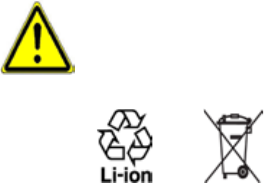
6
SAFETY PRECAUTIONS FOR POWER SUPPLY UNIT
• Use the correct external power source
A product should be operated only from the type of power source
indicated on the electrical ratings label. If you are not sure of the type
of power source required, consult your authorized service provider or
local power company. For a product that operates from battery power
or other sources, refer to the operating instructions that are included
with the product.
• Handle battery packs carefully
This product contains a Li-ion or Li-ion Polymer battery. There is a
risk of fire and burns if the battery pack is handled improperly. Do
not attempt to open or service the battery pack. Do not disassemble,
crush, puncture, short external contacts or circuits, dispose of in fire
or water, or expose a battery pack to temperatures higher than 60˚C
(140˚F).
WARNING: Danger of explosion if battery is incorrectly replaced.
To reduce risk of fire or burns, do not disassemble, crush, puncture,
short external contacts, expose to temperature above 60° C (140° F),
or dispose of in fire or water. Replace only with specified batteries.
Recycle or dispose of used batteries according to the local regulations
or reference guide supplied with your product.
• Take extra precautions
• Keep the battery or device dry and away from water or any liquid
as it may cause a short circuit.
• Keep metal objects away so they don’t come in contact with the
battery or its connectors as it may lead to short circuit during
operation.
• Do not use a battery that appears damaged, deformed, or
discolored, or the one that has any rust on its casing, overheats, or
emits a foul odor.
7
• Always keep the battery out of the reach of babies and small
children, to avoid swallowing of the battery. Consult the doctor
immediately if the battery is swallowed.
• Only use the battery with a charging system that has been
qualified with the system per this standard, IEEE-Std-1725-2006.
Use of an unqualified battery or charger may present a risk of fire,
explosion, leakage or other hazard.
• Replace the battery only with another battery that has been
qualified with the system per this standard, IEEE-Std-1725-2006.
Use of an unqualified battery may present a risk of fire, explosion,
leakage or other hazard.
• Avoid dropping the phone or battery. If the phone or battery
is dropped, especially on a hard surface, and the user suspect
damage, take it to a service centre for inspection.
• If the battery leaks:
• Do not allow the leaking fluid to come in contact with skin
or clothing. If already in contact, flush the affected area
immediately with clean water and seek medical advice.
• Do not allow the leaking fluid to come in contact with eyes.
If already in contact, DO NOT rub; rinse with clean water
immediately and seek medical advice.
• Take extra precautions to keep a leaking battery away from fire
as there is a danger of ignition or explosion.
• Communicate the appropriate steps immediately in case a hazard
occurs.
SAFETY PRECAUTIONS FOR DIRECT SUNLIGHT
Keep this product away from excessive moisture and extreme temperatures.
Do not leave the product or its battery inside a vehicle or in places where
the temperature may exceed 60°C (140°F), such as on a car dashboard,
window sill, or behind a glass that is exposed to direct sunlight or strong
ultraviolet light for extended periods of time. This may damage the product,
overheat the battery, or pose a risk to the vehicle.

8
PREVENTION OF HEARING LOSS
CAUTION: Permanent hearing loss may occur if earphones or
headphones are used at high volume for prolonged periods
of time.
NOTE: For France, Earphone (listed below) for this device have been tested
to comply with the Sound Pressure Level requirement laid down in the
applicable NF EN 50332-1:2000 and/or NF EN 50332-2:2003 standards as
required by French Article L. 5232-1.
• Earphone, manufactured by HTC, Model HS S168.
SAFETY IN AIRCRAFT
Due to the possible interference caused by this product to an aircraft’s
navigation system and its communications network, using this device’s
phone function on board an airplane is against the law in most countries. If
you want to use this device when on board an aircraft, remember to turn off
your phone by switching to Airplane Mode.
ENVIRONMENT RESTRICTIONS
Do not use this product in gas stations, fuel depots, chemical plants or
where blasting operations are in progress, or in potentially explosive
atmospheres such as fuelling areas, fuel storehouses, below deck on
boats, chemical plants, fuel or chemical transfer or storage facilities, and
areas where the air contains chemicals or particles, such as grain, dust, or
metal powders. Please be aware that sparks in such areas could cause an
explosion or fire resulting in bodily injury or even death.
EXPLOSIVE ATMOSPHERES
When in any area with a potentially explosive atmosphere or where
flammable materials exist, the product should be turned off and the user
should obey all signs and instructions. Sparks in such areas could cause an
explosion or fire resulting in bodily injury or even death. Users are advised
not to use the equipment at refueling points such as service or gas stations,
and are reminded of the need to observe restrictions on the use of radio
equipment in fuel depots, chemical plants, or where blasting operations
are in progress. Areas with a potentially explosive atmosphere are often,
but not always, clearly marked. These include fueling areas, below deck on
boats, fuel or chemical transfer or storage facilities, and areas where the air
contains chemicals or particles, such as grain, dust, or metal powders.
9
ROAD SAFETY
Vehicle drivers in motion are not permitted to use telephony services with
handheld devices, except in the case of emergency. In some countries,
using hands-free devices as an alternative is allowed.
SAFETY PRECAUTIONS FOR RF EXPOSURE
• Avoid using your phone near metal structures (for example, the steel
frame of a building).
• Avoid using your phone near strong electromagnetic sources, such as
microwave ovens, sound speakers, TV and radio.
• Use only original manufacturer-approved accessories, or accessories
that do not contain any metal.
• Use of non-original manufacturer-approved accessories may violate
your local RF exposure guidelines and should be avoided.
INTERFERENCE WITH MEDICAL EQUIPMENT FUNCTIONS
This product may cause medical equipment to malfunction. The use of this
device is forbidden in most hospitals and medical clinics.
If you use any other personal medical device, consult the manufacturer
of your device to determine if they are adequately shielded from external
RF energy. Your physician may be able to assist you in obtaining this
information.
Turn your phone OFF in health care facilities when any regulations posted
in these areas instruct you to do so. Hospitals or health care facilities may be
using equipment that could be sensitive to external RF energy.
HEARING AIDS
Some digital wireless phones may interfere with some hearing aids. In the
event of such interference, you may want to consult your service provider,
or call the customer service line to discuss alternatives.
NONIONIZING RADIATION
Your device has an internal antenna. This product should be operated in
its normal-use position to ensure the radiative performance and safety
of the interference. As with other mobile radio transmitting equipment,
users are advised that for satisfactory operation of the equipment and
for the safety of personnel, it is recommended that no part of the human
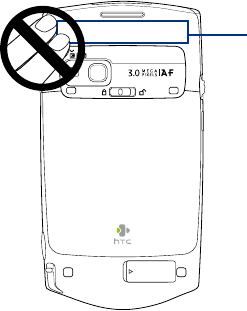
10
body be allowed to come too close to the antenna during operation of the
equipment.
Use only the supplied integral antenna. Use of unauthorized or modified
antennas may impair call quality and damage the phone, causing loss of
performance and SAR levels exceeding the recommended limits as well
as result in non-compliance with local regulatory requirements in your
country.
To assure optimal phone performance and ensure human exposure to RF
energy is within the guidelines set forth in the relevant standards, always
use your device only in its normal-use position. Do not touch or hold the
antenna area unnecessarily when placing or receiving a phone call. Contact
with the antenna area may impair call quality and cause your device to
operate at a higher power level than needed. Avoiding contact with the
antenna area when the phone is IN USE optimizes the antenna performance
and the battery life.
Antenna location
11
General Precautions
• Heed service markings
Except as explained elsewhere in the Operating or Service
documentation, do not service any product yourself. Service needed
on components inside the device should be done by an authorized
service technician or provider.
• Damage requiring service
Unplug the product from the electrical outlet and refer servicing to
an authorized service technician or provider under the following
conditions:
• Liquid has been spilled or an object has fallen into the product.
• The product has been exposed to rain or water.
• The product has been dropped or damaged.
• There are noticeable signs of overheating.
• The product does not operate normally when you follow the
operating instructions.
• Avoid hot areas
The product should be placed away from heat sources such as
radiators, heat registers, stoves, or other products (including
amplifiers) that produce heat.
• Avoid wet areas
Never use the product in a wet location.
• Avoid using your device after a dramatic change in temperature
When you move your device between environments with very
different temperature and/or humidity ranges, condensation may
form on or within the device. To avoid damaging the device, allow
sufficient time for the moisture to evaporate before using the device.
NOTICE: When taking the device from low-temperature conditions into a
warmer environment or from high-temperature conditions into
a cooler environment, allow the device to acclimate to room
temperature before turning on power.
12
• Avoid pushing objects into product
Never push objects of any kind into cabinet slots or other openings
in the product. Slots and openings are provided for ventilation. These
openings must not be blocked or covered.
• Mounting accessories
Do not use the product on an unstable table, cart, stand, tripod,
or bracket. Any mounting of the product should follow the
manufacturer’s instructions, and should use a mounting accessory
recommended by the manufacturer.
• Avoid unstable mounting
Do not place the product with an unstable base.
• Use product with approved equipment
This product should be used only with personal computers and
options identified as suitable for use with your equipment.
• Adjust the volume
Turn down the volume before using headphones or other audio
devices.
• Cleaning
Unplug the product from the wall outlet before cleaning. Do not use
liquid cleaners or aerosol cleaners. Use a damp cloth for cleaning, but
NEVER use water to clean the LCD screen.
13
Contents
Chapter 1 Getting Started 19
1.1 Getting to Know Your PDA Phone and Accessories ....... 20
1.2 Installing the SIM Card and Battery ................................ 24
1.3 Installing a Storage Card ................................................. 27
1.4 Starting Up ........................................................................ 27
1.5 The Today Screen .............................................................. 30
1.6 The Start Menu ................................................................. 31
1.7 Quick Menu ....................................................................... 32
1.8 HTC Home ......................................................................... 32
1.9 Status Icons ....................................................................... 38
1.10 Programs ........................................................................... 40
1.11 Settings ............................................................................. 43
Chapter 2 Entering and Searching
Information 47
2.1 Entering Information ....................................................... 48
2.2 Using the On-screen Keyboard........................................ 49
2.3 Using Letter Recognizer ................................................... 49
2.4 Using Block Recognizer.................................................... 50
2.5 Using Transcriber .............................................................. 50
2.6 Using Symbol Pad ............................................................. 52
14
2.7 Using Notes to Draw, Write, and Record Voice Notes .... 53
2.8 Searching Information ..................................................... 53
Chapter 3 Using Phone Features 55
3.1 Using the Phone ............................................................... 56
3.2 Making a Call .................................................................... 58
3.3 Receiving a Call ................................................................. 61
3.4 Smart Dialing .................................................................... 63
3.5 Additional Dialing Information ....................................... 65
Chapter 4 Setting Up Your PDA Phone 67
4.1 Basic Settings .................................................................... 68
4.2 Personalizing the Today Screen ...................................... 69
4.3 Customizing Phone Settings and Services ..................... 71
4.4 Protecting Your Device ..................................................... 73
4.5 Using Fingerprint Sensor and
HTC Fingerprint Manager ................................................ 75
4.6 Other Settings .................................................................. 80
Chapter 5 Synchronizing Information
with Your Computer 83
5.1 About Synchronization .................................................... 84
5.2 Setting Up Windows Mobile® Device Center
on Windows Vista ............................................................. 85
5.3 Setting Up ActiveSync® on Windows XP ......................... 88
5.4 Synchronizing with Your Computer ................................ 89
15
5.5 Synchronizing via Bluetooth ........................................... 91
5.6 Synchronizing Music and Video ...................................... 92
Chapter 6 Organizing Contacts, Appointments,
Tasks, and Other Information 93
6.1 Managing Your Phonebook ............................................. 94
6.2 Contacts ............................................................................ 94
6.3 SIM Manager ..................................................................... 99
6.4 Calendar .......................................................................... 101
6.5 Tasks ................................................................................ 104
6.6 Notes ............................................................................... 106
Chapter 7 Exchanging Messages 109
7.1 Messaging ....................................................................... 110
7.2 Text Messages ................................................................. 111
7.3 MMS ................................................................................. 112
7.4 Types of E-mail Accounts ............................................... 118
7.5 E-mail Setup Wizard ....................................................... 119
7.6 Using E-mail .................................................................... 122
Chapter 8 Working with Company E-mails
and Meeting Appointments 129
8.1 Synchronizing Your Device with
the Exchange Server ...................................................... 130
8.2 Working with Company E-mails .................................... 132
16
8.3 Managing Meeting Requests......................................... 137
8.4 Finding Contacts in the Company Directory ................ 138
8.5 E-mail Security ................................................................ 140
Chapter 9 Working with Documents
and Files 145
9.1 Microsoft® Office Mobile ................................................ 146
9.2 Adobe® Reader® LE ......................................................... 147
9.3 Copying and Managing Files ......................................... 148
9.4 ZIP .................................................................................... 150
9.5 Backing Up Data ............................................................. 151
Chapter 10 Getting Connected 155
10.1 Comm Manager .............................................................. 156
10.2 Connection Setup ........................................................... 157
10.3 Ways of Connecting to the Internet .............................. 158
10.4 Wi-Fi ................................................................................. 158
10.5 GPRS/3G .......................................................................... 162
10.6 Dial-up and Other Connections..................................... 163
10.7 Starting a Data Connection ........................................... 164
10.8 Internet Explorer® Mobile .............................................. 165
10.9 Windows Live™ ............................................................... 166
10.10
Using Your Device as a Modem (Internet Sharing) .............171
10.11 Bluetooth ........................................................................ 172
17
Chapter 11 Using GPS 181
11.1 Guidelines and Preparation for Using GPS ................... 182
11.2 Downloading Satellite Data via QuickGPS ................... 184
11.3 GPS Controls ................................................................... 186
Chapter 12 Experiencing Multimedia 187
12.1 Camera ............................................................................ 188
12.2 Pictures & Videos ............................................................ 200
12.3 Windows Media® Player Mobile .................................... 202
12.4 Audio Manager ............................................................... 207
Chapter 13 Managing Your PDA Phone 215
13.1 Adding and Removing Programs .................................. 216
13.2 Managing Memory ......................................................... 217
13.3 Task Manager .................................................................. 218
13.4 Resetting Your Device .................................................... 219
13.5 Checking System Information ....................................... 222
13.6 Windows Update ............................................................ 222
13.7 Battery Saving Tips......................................................... 223
Chapter 14 Using Other Applications 225
14.1 Voice Speed Dial ............................................................. 226
14.2 Java .................................................................................. 228
14.3 Spb GPRS Monitor .......................................................... 229
18
Appendix 233
A.1 Regulatory Notices ......................................................... 234
A.2 Specifications ................................................................. 240
Index 243

Chapter 1
Getting Started
1.1 Getting to Know Your PDA Phone and
Accessories
1.2 Installing the SIM Card and Battery
1.3 Installing a Storage Card
1.4 Starting Up
1.5 The Today Screen
1.6 The Start Menu
1.7 Quick Menu
1.8 HTC Home
1.9 Status Icons
1.10 Programs
1.11 Settings
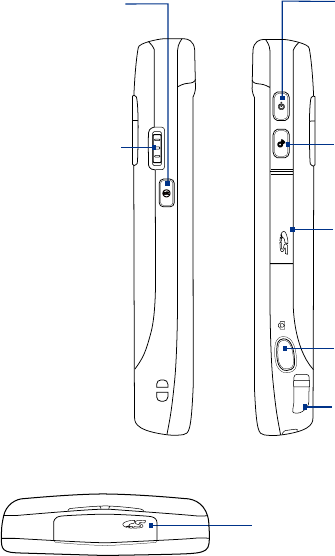
20 Getting Started
1.1 Getting to Know Your PDA Phone and
Accessories
Left panel
Jog Wheel
• Scroll up or down
to navigate through
menus, program
instructions; press the
wheel to carry out a
selection.
• During a call or when
playing music, scroll
up or down to adjust
the sound volume.
• When receiving an
incoming call, scroll
down to disable the
audio notification.
OK button
Press to confirm your
data entries, to exit the
program in use, or to
open the Start menu
from the Today screen.
Right panel
POWER
Press and hold for about 3
seconds to turn the device
on or off. Press briefly
to turn off the display
temporarily. For more
information, see “Starting
Up” in this chapter.
SD Card Slot
Pry open the rubber
cover to access the SD
card slot. See "Installing a
Storage Card" for details.
Stylus
COMM MANAGER
Press to launch Comm
Manager. See Chapter 10
for details.
CAMERA
Press to launch the
Camera. See Chapter 12
for details.
Top panel
SD Card Slot
Pry open the rubber cover to access
the SD card slot. See "Installing a
Storage Card" for details.
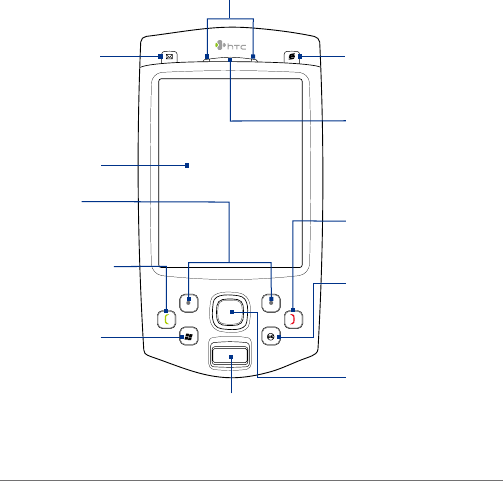
Getting Started 21
Front panel
MESSAGING
Press to open
Messaging.
See Chapter 7
for details.
Notification LEDs
* See description below.
Earpiece
Listen to a phone call
from here.
Touch Screen
TALK
Press to answer
an incoming call
or dial a number.
Left/Right
SOFT KEYs
START MENU
NAVIGATION Control/ENTER
Press this multi-directional
control up, down, left, or right
to move through menus and
program instructions; carry
out the selection by pressing
the center button
.
END
Press to end a call or to
return to the Today screen.
OK
See OK button.
INTERNET EXPLORER
Press to open Internet
Explorer. See Chapter 10
for details.
Fingerprint Sensor
Swipe your finger(s) for
fingerprint authentication
before accessing device data.
* Left LED: Shows Green and Amber lights for HSDPA/WCDMA/EDGE/GSM/GPRS
standby, message, and network status as well as for notification and
battery charging status. Shows a flashing red light when the battery level
reaches 5% or lower.
Right LED: Shows a flashing Blue light for Bluetooth system notification of powered-
up and ready to transmit Bluetooth signal, or a flashing Green light for
Wi-Fi status. When both Bluetooth and Wi-Fi are enabled, their lights flash
alternately. Shows Amber light for GPS status.
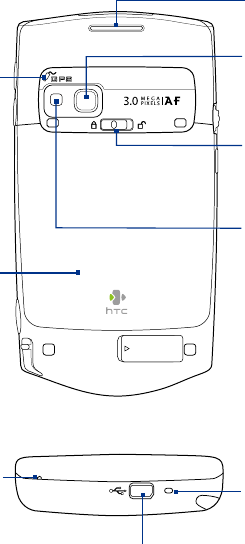
22 Getting Started
Back panel
Speaker
3 Megapixel
Autofocus Camera
See Chapter 12 for
details.
Back Cover
GPS Antenna
Connector
Peel off the rubber
cap and connect an
external GPS antenna
for better GPS signal
reception.
Note Use only the
external GPS
antenna having
model number
as GA S120. Flash Light
Use the flash light to
shoot photos/video
clips under poor
lighting conditions.
Back Cover Latch
Slide this latch to
release the back
cover.
Bottom panel
Sync Connector/Earphone Jack
Connect the supplied USB cable to synchronize
information or plug in the AC adapter to recharge
the battery. You can also connect the supplied
USB stereo headset for hands-free conversation or
for listening to audio media.
Microphone
RESET
Press the RESET button
with the stylus, to soft-
reset your device.
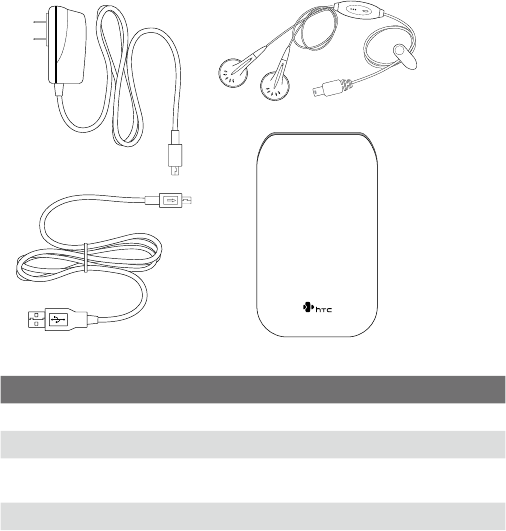
Getting Started 23
Accessories
2
13
4
No. Accessory Function
1 AC adapter Recharges the battery.
2 USB Sync cable Connects your device to a PC and synchronizes data.
3 Stereo headset Press the Send/End button to pick up a call or put a
call on hold; press and hold the button to end the call.
4 Pouch Acts as a protective carrying case for your device.
24 Getting Started
1.2 Installing the SIM Card and Battery
Always turn off your device before installing/replacing the SIM card and
battery. The SIM card contains your phone number, service details, and
phonebook/message memory. Your device supports both 1.8V and 3V SIM
cards. Some legacy SIM cards will not function with your device. You should
consult with your service provider for a replacement SIM card. There may be
fees for this service.
Your device contains a rechargeable Li-ion polymer battery. It is designed to
use only manufacturer-specified original batteries and accessories. Battery
performance depends on many factors, including network configuration,
signal strength, the temperature of the environment in which you operate
your device, the features and/or settings you select and use, items attached
to connecting ports, and your voice, data, and other program usage
patterns.
Battery life estimates (approximations):
• Standby time: Up to 460 hours for WCDMA
Up to 407 hours for GSM
• Talk time: Up to 284 minutes for WCDMA
Up to 464 minutes for GSM
Warning! To reduce risk of fire or burns:
• Do not attempt to open, disassemble, or service the battery pack.
• Do not crush, puncture, short external contacts, or dispose of in fire
or water.
• Do not expose to temperatures above 60oC (140oF).
• Replace only with the battery pack designated for this product.
• Recycle or dispose of used battery as stipulated by local regulation.
Important Before opening the SIM card door, make sure you turn off the device
first. Opening the SIM card door while the device is turned on may
damage the device.
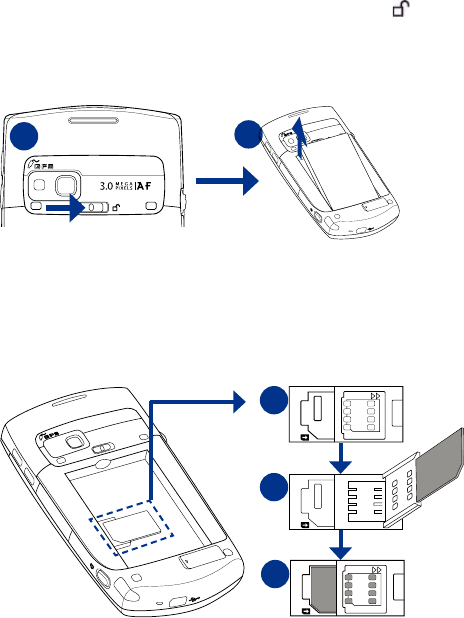
Getting Started 25
To install the SIM card
1. Make sure your device is turned off.
2. Slide and hold the back cover latch to the unlock position ( ) to
release the back cover, then remove the back cover by lifting it up
from the top end.
3. If you have installed the battery, remove it by lifting it up from its top
end (see “To remove the battery“ later in this chapter).
23
4. Press and slide the SIM card holder towards right to unlock, and then
lightly lift it open.
5. Insert the SIM card into the holder with its gold contacts facing down
and its cut-off corner facing toward outside of the slot.
6. Move the SIM card holder down, and then press gently to close and
lock it in place.
6
OPEN
PRESS LOCK
OPEN
PRESS LOCK
5
4
Tip An illustration of the correct SIM card orientation is etched on the SIM
card door.
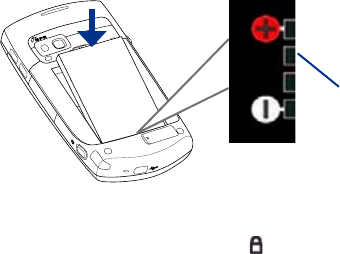
26 Getting Started
To remove the SIM card
Press and slide the SIM card holder towards right to unlock it, and lightly flip
it open. Then gently take the SIM card out from the SIM card holder.
To install the battery
Install the battery by inserting it with its exposed copper part aligned with
the protruding copper conductor on the bottom left side of the battery
compartment. Insert the bottom part of the battery first, then gently push
the battery into place.
Copper
conductor
After you have installed the battery, replace the back cover by inserting the
bottom part first and then gently pressing its upper part. The back cover
latch clicks back to the lock position ( ).
To remove the battery
1. Make sure your device is turned off.
2. Release and remove the back cover (see “To install the SIM card”
section).
3. To remove the battery, lift it up from its top end using the groove on
the battery compartment (see “To install the SIM card” section).
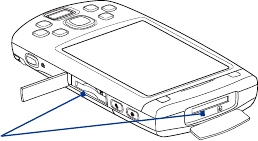
Getting Started 27
1.3 Installing a Storage Card
Your device comes with two storage card slots: one is at the top, while the
other one is at the right side of the device. To have additional storage for
your images, videos, music, and data files, you can purchase SDTM memory
cards and install them in these slots.
To insert an SD card
1. Pry open the rubber that covers the storage card slot.
SD card slot
2. Insert the SD card into the slot with the gold contacts facing down.
3. Replace the rubber cover.
Note To remove the SD card, press the SD card to eject it from the slot.
1.4 Starting Up
After installing your SIM card and battery and charging the battery, you can
now power on and start using your device.
Turn your device on and off
To turn on the power
Press and hold the POWER button for a few seconds.
When you turn on your device for the first time, a Quick Setup Wizard
will guide you through the calibration process and the setup of regional
settings, date and time, and password. For more information about touch
screen calibration, see “Calibrate the device” later in this chapter.

28 Getting Started
To turn off the power
Press and hold the POWER button for a few seconds.
A message will then be displayed, prompting you whether or not to turn off
the device completely.
Auto configure the data connection settings
The first time you power on your device, you will see a notification message
from the Connection Setup on the Today screen.
The Connection Setup can automatically configure your device’s data
connections, such as GPRS, WAP, and MMS, for you so that you do not need
to enter the settings manually onto your device.
To automatically configure data connection settings
1. When you see the notification message from the Connection Setup,
tap Yes.
Note If you do not see the notification message, tap on the title bar to
display the message.
2. If your SIM card supports multiple network operator profiles, a
message will appear with network profile choices. Select the profile
you want to use and tap OK.
3. Connection Setup then starts to configure your device’s data
connection settings.
4. After the Connection Setup completes the configuration, tap Restart.
For more information about the Connection Setup, see Chapter 10.
Charge the battery
New batteries are shipped partially charged. Before you start using your
device, it is recommended that you install and charge the battery. Some
batteries perform best after several full charge/discharge cycles. You can
charge the battery in two ways:
•
Charging the device’s battery by connecting the power adapter.
• Connecting your device to a PC via the provided USB Sync cable.
Note Only the AC adapter and USB cable provided with your device should be
used to charge the device.

Getting Started 29
Charging is indicated by a solid amber light on the left LED indicator.
As the battery is being charged while the device’s power is on, a charging
icon ( ) will be shown on the title bar of the Today screen. After the
battery has been fully charged, the left LED becomes green and a full
battery icon ( ) appears on the Today screen’s title bar.
Warning! • Do not remove the battery from the device while you are charging it
using the AC or car adapter.
• As a safety precaution, the battery stops charging when it overheats.
Calibrate the device
Calibrating the touch screen involves tapping the center of a cross with the
stylus as the cross moves around the screen. This process ensures that when
you tap the screen with your stylus, the tapped item is activated.
If your device does not accurately respond to screen taps, follow these steps
to re-calibrate it:
1. Tap Start > Settings > System tab > Screen.
2. On the General tab, tap Align Screen, then follow the on-screen
instructions to complete the calibration.
Manage screen settings
The device’s display has the following orientation modes: Portrait and
Landscape. To change the orientation, tap Start > Settings > System tab >
Screen, and select the orientation you want.
Tip To quickly change the screen orientation, you can also tap the Rotate Screen
icon in HTC Home’s Launcher. See “HTC Home” later in this chapter for details.
To smooth the edges of screen fonts for many programs, on the ClearType
tab, select the Enable ClearType check box.
To increase the readability or to see more content on the screen, on the
Text Size tab, adjust the text size by moving the slider.
Switch your device to Sleep mode
Quickly pressing the POWER button turns off the display temporarily and
switches your device to Sleep mode. Sleep mode suspends your device to a
low power state while the display is off in order to save battery power.
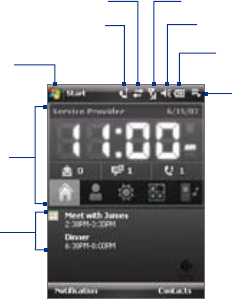
30 Getting Started
Your device also automatically goes into Sleep mode when you leave the
device idle after a certain amount of time.
To specify the timeout period before your device goes into Sleep mode
1. Tap Start > Settings > System tab > Power > Advanced tab.
2. Under On battery power, make sure the Turn off device if not used
for check box is selected.
3. Select the battery timeout period, then tap OK.
You will still be able to receive messages and calls while your device is in
Sleep mode. Pressing the POWER button again or new incoming calls/
messages will wake up your device.
1.5 The Today Screen
The Today screen displays important information, such as upcoming
appointments and status indicators. You can tap a section on the screen to
open the associated program.
Your upcoming
appointments
Open Start Menu
Notification
Signal strength
Adjust volume
Battery status
HTC Home
(See “HTC Home”
in this chapter
for details)
Open Quick Menu
(See “Quick Menu” in
this chapter for details)
Connection status
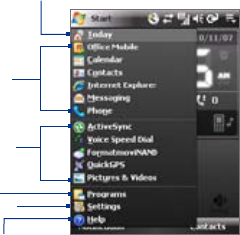
Getting Started 31
• To access the Today screen, tap Start > Today.
• To customize the Today screen display, including the background
image, tap Start > Settings > Personal tab > Today.
For more information about customizing the Today screen, see Chapter 4.
1.6 The Start Menu
The Start menu, located at the top left corner of the Today screen, displays a
list of programs. You can start a program by scrolling through the programs
list and then pressing ENTER, or by tapping a program with the stylus.
View Help information for the
current screen.
View and change settings.
Access more programs.
Open a recently-used program.
Open a program.
(The items displayed in the
Start menu can be customized
by tapping Start > Settings >
Personal tab > Menus).
Switch to the Today screen.
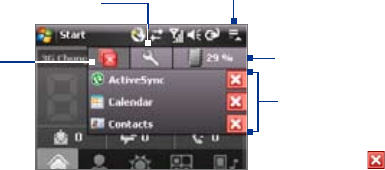
32 Getting Started
1.7 Quick Menu
The Quick Menu, located at the top right corner of the Today screen, shows
the currently running programs. You can quickly switch between running
programs and stop programs when you do not need to use them.
Tap this button to open
the Quick Menu.
• To switch to a running
program, tap the
program name.
• To stop running a
program, tap .
Customize how programs are
closed. (See “Task Manager” in
Chapter 13.)
Stop all
currently
running
programs.
Shows the total program
memory usage (in
percentage). Tap to open
Memory settings.
1.8 HTC Home
HTC Home™ is a Today screen plug-in that gives you up-to-date local
information at a glance, such as time, day and weather information, and
shows new messages and missed calls.
HTC Home also has 3 other tabs that let you quickly access your frequently-
called contacts, often-used or accessed programs or device settings, and
ring tone settings.
HTC Home has five components: Home, Favorite People, Weather,
Launcher, and Sound. At the bottom of HTC Home, there is a toolbar that
allows you to switch between these components.
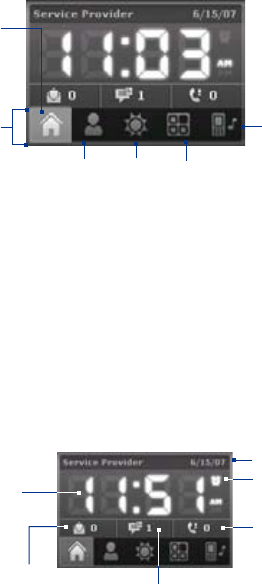
Getting Started 33
HTC Home
Toolbar
Home
Weather LauncherFavorite People
Sound
To switch between the different components of HTC Home
Do any of the following:
• Tap the tabs in the toolbar.
• Use the NAVIGATION Control. If the toolbar is not selected, press
NAVIGATION up/down first to select the toolbar. Press NAVIGATION
left/right to select a tab and then press ENTER.
Home
Home displays the current date and local time. When you have new
incoming messages and calls, it shows you the number of new e-mails,
SMS/MMS messages, and missed calls. If you have set up the alarm, it also
shows the Alarm icon.
Number of new e-mails.
Tap this icon to view
your e-mails.
Number of new SMS/MMS messages.
Tap this icon to view your SMS and MMS messages.
Alarm icon
Number of missed calls.
Tap this icon to view the
Call History.
Time display.
Tap this display area
when you want to
change the date or time,
or to enable the alarm.
Current date
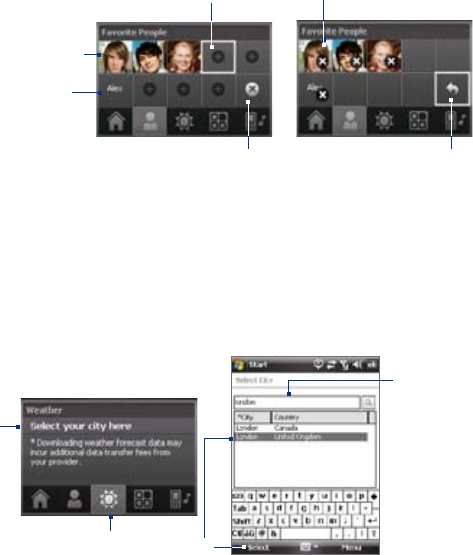
34 Getting Started
Favorite People
Favorite People allows you to add 9 frequently-called contacts, giving you
easy access to these contacts whenever you need to call them.
Note To add contacts that are in your SIM card, copy the contact first to your
Contacts list.
Tap to
automatically
call the contact.
Tap an empty slot to
add a contact. Tap a contact to remove it.
Return
Tap to remove a contact
from the Favorite People list.
Contact
without picture
set.
Note To replace a contact, you need to delete it first and then choose a new
contact to replace the contact that was deleted.
Weather
Weather shows you the current weather as well as weather information of
the next four days of the week. The first time you use this feature, you need
to select your city first to get the weather information of your city.
To select your city
2
1
3
4
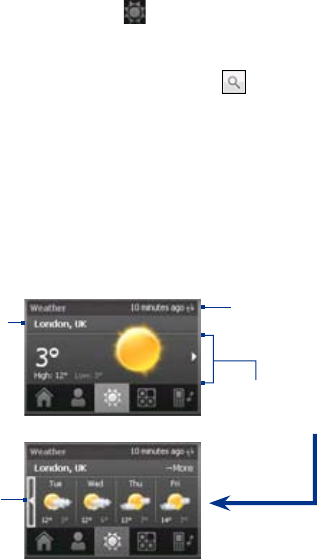
Getting Started 35
1. Select the Weather tab ( ).
2. Tap the area that shows Select your city here.
3. On the Select City screen, type in the city name whose weather
information you want to track, then tap .
Tip You can also browse through the list of cities to choose your city.
4. Select the city on the list and tap Select.
To view weather information
After selecting your city, your device automatically connects to the Internet
via GPRS/3G and downloads weather information of the current day and
the next four days of the week. The current temperature, the highest and
lowest temperatures, and a visual indicator of the climate (showing if it’s a
cloudy or rainy day, etc.) will be displayed in the Weather tab.
Weather for the next 4 days
Tap this area
to return to
the current
day’s weather.
Current day’s weather
Tap this area to view
weather information of the
next four days of the week.
Tap this area
if you want to
select another
city.
Shows the time or days that have
passed since the last download
of weather information. Tap this
item to download the latest
weather data.
Tip You can also use the Wi-Fi connection of your device to download weather
data. For more information about using Wi-Fi, see Chapter 10.
Note If you have not connected to the Internet and downloaded weather
information for five days, the following error message will be displayed:
"Unable to retrieve data for selected city. Select here to retry." Use GPRS/3G
or Wi-Fi to connect your device to the Internet, then tap the area that shows
the error message to download weather data.
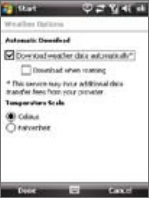
36 Getting Started
To customize weather settings
1. Tap the area that shows the city name.
2. On the Select City screen, select Menu > Weather Options.
3. You can enable or disable the following options:
• Download weather data automatically. When this check box is
selected, weather information will automatically be downloaded
from the AccuWeather Web site whenever you select the Weather
tab, if the data has not been updated within the last three hours.
Weather data will also be downloaded every time an ActiveSync
connection occurs (through over-the-air or USB connection).
Clear this check box if you prefer
to manually download weather
information.
• Download when roaming.
Select this check box only
if want to allow automatic
download of weather data when
you’re roaming. This may incur
additional costs.
• Temperature Scale. Choose
whether to display temperature in
Celsius or Fahrenheit.
Tip To check for more detailed weather information on the AccuWeather Web
site, select Menu > About Weather on the Select City screen and then tap
the link that shows AccuWeather.com. Internet Explorer Mobile then opens
and brings you to the AccuWeather Web site.
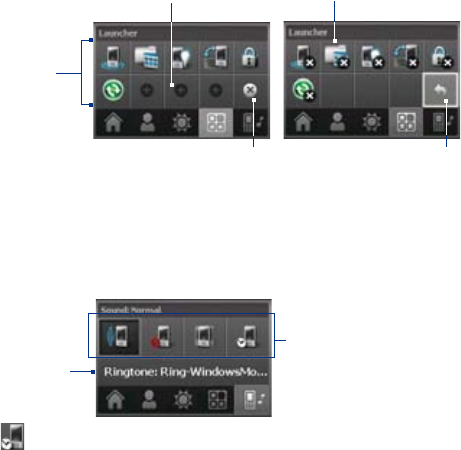
Getting Started 37
Launcher
Launcher allows you to add quick shortcuts to your favorite programs
and settings for one-tap access. Quick settings such as Adjust Backlight,
Rotate Screen and Lock Device, and a few program shortcuts are added by
default. They can be replaced with your preferred settings and programs.
Remove shortcuts
Tap a quick
shortcut to open
the associated
program or apply
the associated
setting.
Tap an empty slot to add a
shortcut to a setting or your
favorite program. Tap a shortcut to remove it.
Return
Note To replace a shortcut, you need to delete it first and then add a shortcut to
your favorite program or setting.
Sound
Sound lets you quickly set the device volume and change the ring tone of
your device.
Tap a button to set the
device volume.
Tap to open the
phone sound
settings.
Tap to set the device volume to Automatic. If Automatic is selected,
the device will vibrate during a scheduled event in your calendar; when
there is no scheduled event in your calendar, the device will use the Normal
mode settings.
Note To learn more about setting device volume, see Chapter 3.
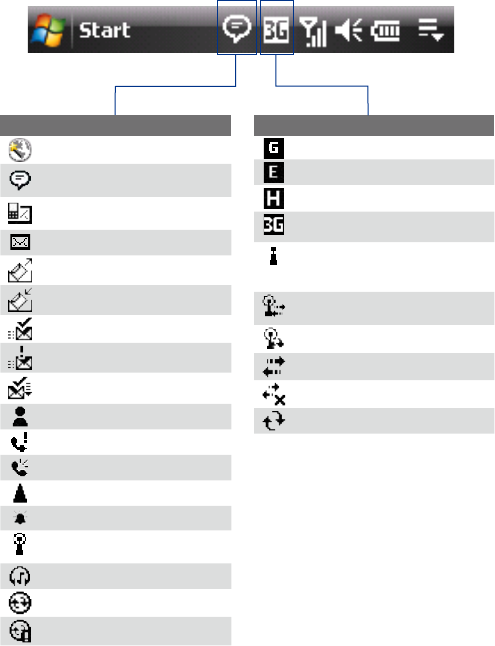
38 Getting Started
1.9 Status Icons
The following are some of the status icons that you may see on the device.
Icons that appear in this area
GPRS available.
EDGE available.
HSDPA available.
WCDMA available.
Wi-Fi function enabled, but
device not connected to a
wireless network yet.
Connected to a wireless
network.
Synchronizing via Wi-Fi.
Connection is active.
Connection is not active.
Synchronization in progress.
Icons that appear in this area
Connection Setup
There are more notifications.
Tap the icon to view all.
New text messages;
SMS notification of voice mail.
New e-mail message.
Sending MMS.
Receiving MMS.
MMS sent.
Cannot send MMS.
New incoming MMS.
New Windows Live™ message.
Missed call.
Speakerphone on.
Roaming.
Alarm.
Other wireless network(s)
detected.
Bluetooth headset detected.
ActiveSync notification.
Synchronization error.
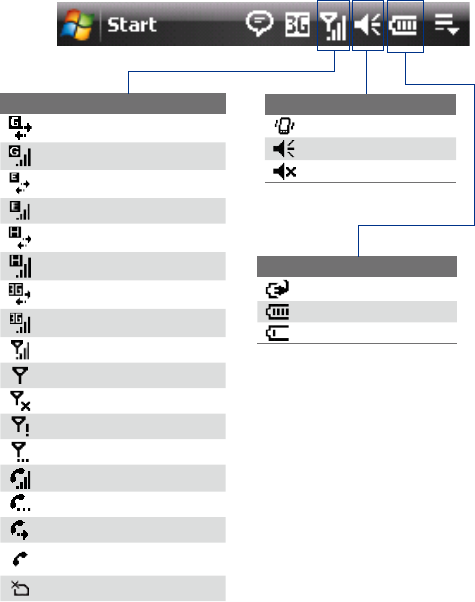
Getting Started 39
Icons that appear in this area
Battery charging
Battery full
Battery very low
Icons that appear in this area
Vibrate mode.
Sound on.
Sound off.
Icons that appear in this area
GPRS connecting.
GPRS in use.
EDGE connecting.
EDGE in use.
HSDPA connecting.
HSDPA in use.
WCDMA connecting.
WCDMA in use.
Maximum signal strength.
No signal.
Phone is turned off.
No phone service.
Searching for phone service.
Voice call in progress.
Call on hold.
Calls are forwarded.
Dialing while no SIM card is
inserted.
No SIM card inserted.
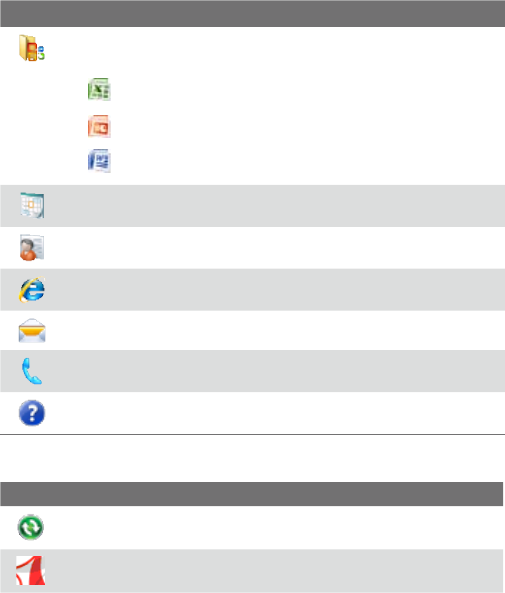
40 Getting Started
1.10 Programs
The following are programs you can find on your device or install from the
Applications Disc.
Programs in the Start Menu
Icon Description
Office Mobile Use the complete suite of Microsoft® Office applications
for your mobile device.
Excel Mobile Create new workbooks or view and edit Excel
workbooks.
PowerPoint Mobile View PowerPoint slides and presentations.
Word Mobile Create, view, and edit Word documents.
Calendar Keep track of your appointments and create meeting
requests.
Contacts Keep track of your friends and colleagues.
Internet Explorer Mobile Browse Web and WAP sites as well as
download new programs and files from the Internet.
Messaging Send and receive e-mail, MMS, and text messages.
Phone Make and receive calls, switch between calls, and set up
conference calling.
Help See Help topics for the current screen or program.
Programs screen
Icon Description
ActiveSync Synchronize information between your device and a PC or
the Exchange Server.
Adobe Reader LE View PDF (Portable Document Format) files on your
device.
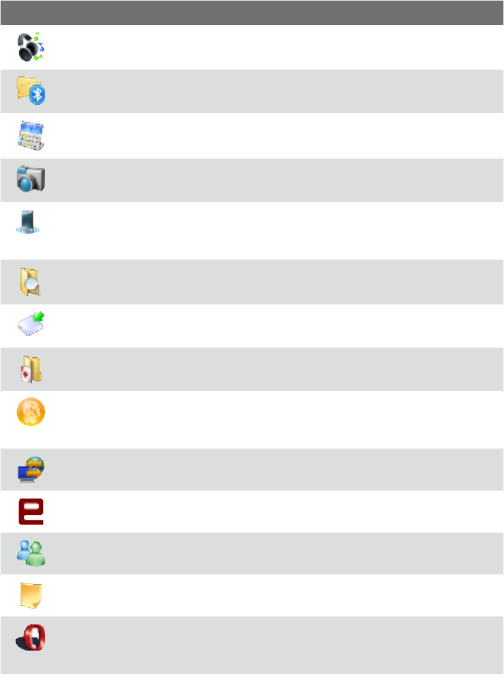
Getting Started 41
Icon Description
Audio Manager Browse for music files by organizing music files into
categories.
Bluetooth Explorer Search for other Bluetooth devices that have file
sharing enabled and access their Bluetooth shared folder.
Calculator Perform basic arithmetic and calculations, such as addition,
subtraction, multiplication, and division.
Camera Take photos or shoots video clips with accompanying audio.
Comm Manager Manage your device’s connections (including Wi-Fi,
GPRS, Bluetooth, and ActiveSync), turn the phone on or off, switch to
ringer/vibration mode, and enable or disable the Direct Push function.
File Explorer Organize and manage files on your device.
Format NAND Flash Lets you erase all your data and files from the
NAND flash and quickly format it.
Games Play two pre-installed games: Bubble Breaker and Solitaire.
HTC Fingerprint Manager Offer fingerprint authentication to access
user credentials for logging on to the device and encrypting/decrypting
files.
Internet Sharing Connect your notebook computer to the Internet
using your device's data connection.
Java Download and install Java applications, such as games and tools,
on your device.
Messenger This is the mobile version of Windows Live™ Messenger.
Notes Create handwritten or typed notes, drawings, and voice
recordings.
Opera Browser Gives you an alternative Internet browser. Opera
provides tabbed browsing and lets you save images, copy text, and send
links via e-mail, MMS, or SMS.
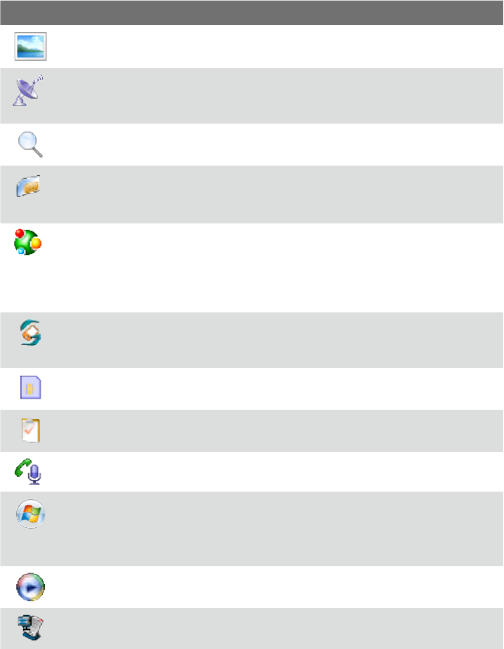
42 Getting Started
Icon Description
Pictures & Videos View, organize, and sort pictures, animated GIFs, and
video files on your device or a storage card.
QuickGPS Downloads satellite data over the Internet via ActiveSync,
Wi-Fi or GPRS/3G to speed up the time for determining your current GPS
position.
Search Search contacts, data, and other information on your device.
SIM Manager Manage the contacts that are stored on your SIM card.
You can also use this program to copy SIM contents to Contacts on your
device.
Spb GPRS Monitor You will find this program in the Application
Disc that came with the device. You can install and use this program
to measure the amount of data transfers that you have made via the
GPRS/3G or GSM network connection, and calculate network usage
costs. See Chapter 14 for details.
Sprite Backup You will find this program in the Application Disc that
came with the device. This provides you with a quick and easy way to
create backups of your data. See Chapter 9 for details.
STK (SIM Tool Kit) Service Access information and other services
offered by your wireless service provider.
Tasks Keep track of your tasks.
Voice Speed Dial Allows you to record voice tags so that you can dial a
phone number or launch programs simply by speaking a word.
Windows Live Use this mobile version of Windows Live™ to find
information on the Web. It also lets you sign into your Windows Live
account so that you can access your Live Mail messages and send/receive
instant messages in Live Messenger.
Windows Media Player Mobile Play back audio and video files.
ZIP Save memory and free up storage space on your device by
compressing files in the conventional ZIP format.
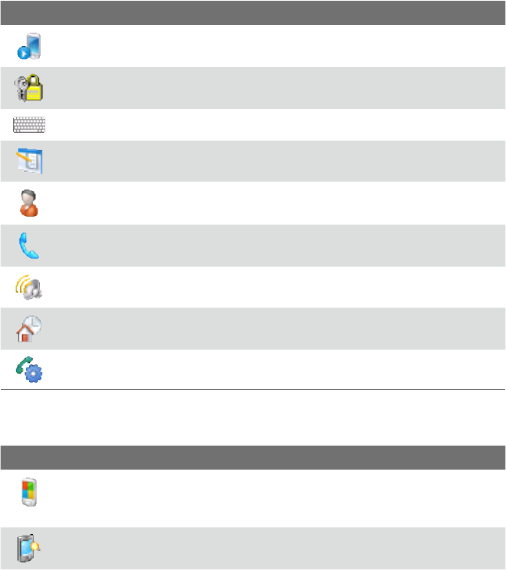
Getting Started 43
1.11 Settings
You can adjust the device settings to suit the way you work. To see all
available settings, tap Start > Settings, then tap the Personal, System, and
Connections tabs located at the bottom of the screen.
Personal tab
Icon Description
Buttons Assign a program or function to a hardware button.
HTC Fingerprint Options Configure options for fingerprint sensor in
order to secure your device.
Input Set options for each of the input methods.
Menus Set what programs will appear in the Start menu.
Owner Information Enter your personal information on your device.
Phone Customize phone settings such as ring tone, set a PIN number for
your SIM card, and more.
Sounds & Notifications Enable sounds for events, notifications, and
more, and set the type of notification for different events.
Today Customize the appearance and the information to be displayed
on the Today screen.
Voice Speed Dial Create voice tags for voice dialing contacts and SIM
contacts as well as for launching programs.
System tab
Icon Description
About This is where you can see basic information such as the Windows
Mobile® version and type of processor used on your device. You can also
specify a name for your device.
Backlight Set the backlight timeout and adjust brightness.
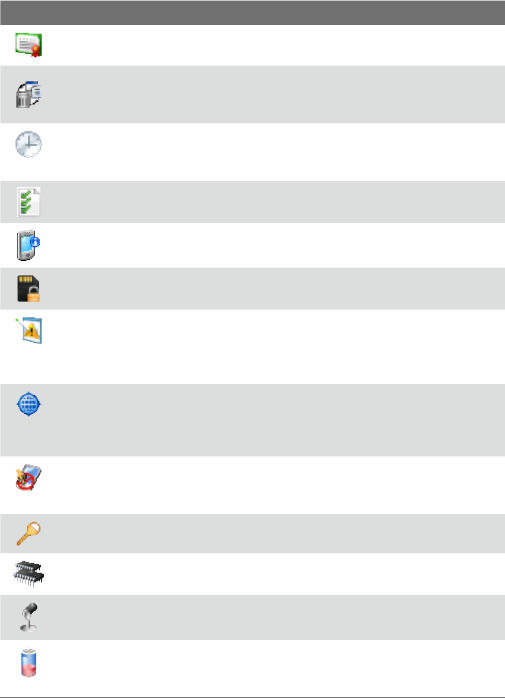
44 Getting Started
Icon Description
Certificates See information about certificates that are installed on your
device.
Clear Storage Tap this icon only when you need to remove all your
data and files from the memory and reset your device to factory default
settings.
Clock & Alarms Set the device clock to the date and time of your locale
or to a visiting time zone when you’re traveling. Alarms can also be set at
specified days and times of a week.
Customer Feedback Set your device to automatically send information
about how you use. By default, this option is disabled.
Device Information See information about the firmware version,
hardware, identity, and the duration of calls made on your device.
Encryption Allow files on your storage card to be encrypted. Encrypted
files will be readable only on your device.
Error Reporting Enable or disable the device's error reporting function.
When this function is enabled and a program error occurs, technical data
about the state of the program and your computer will be logged in a text
file and delivered to Microsoft's technical support if you choose to send it
.
External GPS Set the appropriate GPS communication ports, if required.
You may need to do this when there are programs on your device that
access GPS data or you have connected a GPS receiver to your device.
See Help for details.
Key Lock Lock the buttons on your device except for the POWER button
when the device is in Sleep mode. This ensures you will not switch the
device on by accident and consume unnecessary power.
Lock Set a password for your device.
Memory Check the device memory allocation status and memory card
information. You can also stop currently running programs.
Microphone AGC Adjust the volume of your voice automatically when
you are recording.
Power Check the remaining battery power. You can also set the timeout
for turning off the display (switching device to Sleep mode) to conserve
battery power.
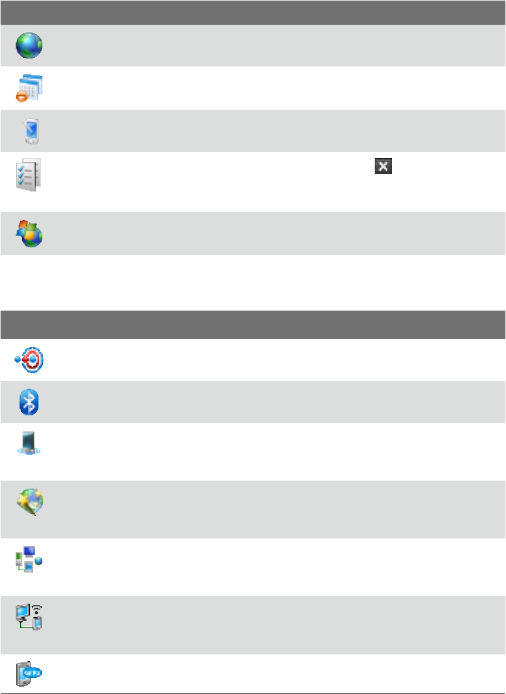
Getting Started 45
Icon Description
Regional Settings Set the regional configuration to use, including the
format for displaying numbers, currency, date, and time on your device.
Remove Programs Remove programs that you installed on your device.
Screen Change the screen orientation, re-calibrate the screen, and
change the screen text size.
Task Manager Stop running programs and set the ( ) button to end
programs immediately when you tap the button. For more information,
see "Task Manager" in Chapter 13.
Windows Update Link to Microsoft's Web site and update Windows
Mobile® on your device with the latest security patches or fixes.
Connections tab
Icon Description
Beam Set your device to receive incoming Bluetooth beams.
Bluetooth Turn Bluetooth on, set your device to visible mode, and scan
for other Bluetooth devices.
Comm Manager Manage your device’s connections (including Wi-Fi,
GPRS/3G, Bluetooth, and ActiveSync), turn the phone on or off, switch to
ringer/vibration mode, and enable or disable the Direct Push function.
Connection Setup Configure your device’s data connections, such as
GPRS/3G, WAP, and MMS, based on the detected or selected network
operator. See Chapter 10 for details.
Connections Set up one or more types of modem connections for your
device, such as phone dial-up, GPRS/3G, and more, so that your device
can connect to the Internet or a private local network.
CSD Line Type Set the line type to use when making a circuit switch
data (CSD) connection. Normally, you do not need to change the setting
unless you encounter a problem on establishing a connection.
GPRS Setting Set the GPRS authentication method.
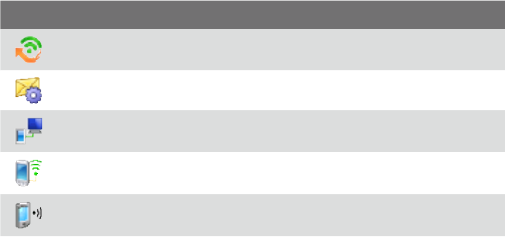
46 Getting Started
Icon Description
HSDPA Turn on or off HSDPA. Your wireless service provider must
support this feature to be able to turn it on.
SMS Service Enables sending of SMS text messages via a data
connection, such as GPRS or a circuit-switched connection. .
USB to PC Set a USB serial connection between your device and PC
when there are problems connecting ActiveSync.
Wi-Fi Scan for available wireless networks.
Wireless LAN See information about the active wireless network, and
customize Wi-Fi settings.

Chapter 2
Entering and Searching
Information
2.1 Entering Information
2.2 Using the On-screen Keyboard
2.3 Using Letter Recognizer
2.4 Using Block Recognizer
2.5 Using Transcriber
2.6 Using Symbol Pad
2.7 Using Notes to Draw, Write, and
Record Voice Notes
2.8 Searching Information
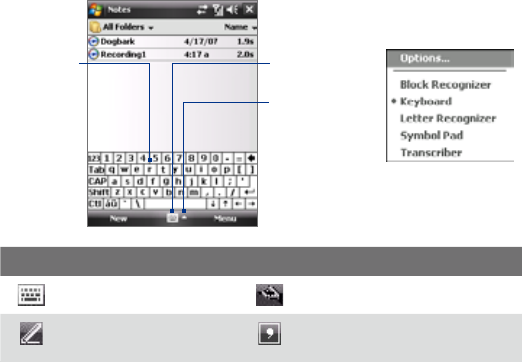
48 Entering and Searching Information
2.1 Entering Information
When you start a program or select a field that requires text or numbers, the
Input Panel icon becomes available on the menu bar.
Tap the Input Selector arrow (that appears next to the Input Panel icon)
to open a menu where you can select a text input method and customize
input options. After selecting a text input method, the corresponding Input
Panel is then displayed and you can use it to enter text. To toggle between
showing and hiding the Input Panel, simply tap the Input Panel icon.
Input Panel
(Keyboard)
Input Selector
arrow
Input Panel icon
Icon Input method Icon Input method
On-screen Keyboard Transcriber
Letter Recognizer or
Block Recognizer Symbol Pad
Note Some text input methods may not be available in certain language versions
of the device.
Entering and Searching Information 49
2.2 Using the On-screen Keyboard
The on-screen Keyboard is available when text entry is possible. You can
enter text by tapping keys on the keyboard that are displayed on the screen.
To enter text using the on-screen Keyboard
1. In a program, tap the Input Selector arrow, and tap Keyboard.
2. Enter text by tapping keys on the on-screen Keyboard.
To enlarge the on-screen Keyboard
1. Tap the Input Selector arrow, then tap Options.
2. In the Input method list, select Keyboard.
3. Tap Large keys.
2.3 Using Letter Recognizer
With Letter Recognizer, you can write individual letters, numbers, and
punctuation, which are then converted into typed text.
To use Letter Recognizer
1. From a program, tap the Input Selector arrow, and tap Letter
Recognizer.
2. Write characters, numbers, and symbols in the designated writing
area
.
• Enter capital letters by writing in the ABC (left) area of the box.
• Enter lower case letters by writing in the abc (middle) area of the
box.
• Enter numbers by writing in the 123 (right) area of the box.
• Enter punctuation and symbols by tapping in either area of the
box and then writing the desired character.
Note Letter Recognizer is available when text entry is possible.
50 Entering and Searching Information
2.4 Using Block Recognizer
With Block Recognizer, you use a single stroke to write letters, numbers,
symbols, and punctuation, which are then converted into typed text.
To use Block Recognizer
1. From a program, tap the Input Selector arrow, and tap Block
Recognizer.
2. Write characters, numbers, and symbols in the designated writing
area
.
• Enter letters by writing in the abc (left) area of the box.
• Enter numbers by writing in the 123 (right) area of the box.
• Enter symbols and punctuation by tapping in either area of the
box and then writing the desired character.
Note Block Recognizer is available when text entry is possible.
2.5 Using Transcriber
Transcriber is a handwriting recognition program that allows you to write
in cursive, print, or a combination of both. Transcriber works transparently
in the background of programs, recognizing words with its integrated
dictionary. When Transcriber is turned on, it interprets stylus movement
anywhere on the screen as handwriting input. For more information about
using Transcriber, see Help on your device.
To start Transcriber
1. Start a program that accepts user input, such as Word Mobile.
2. Tap the Input Selector arrow, and tap Transcriber. The Transcriber
introductory screen appears.

Entering and Searching Information 51
To write using Transcriber
1. In a program, position the cursor where you want text to appear.
2. Use the stylus to write anywhere on the screen. The handwriting will
be converted to text shortly after you lift the stylus from the screen.
To enter punctuation and symbols
Transcriber comes with an on-screen keyboard that provides an easy way to
add punctuation or a special symbol to existing text.
From a program, tap on the Transcriber toolbar. The keyboard remains
visible until you tap the button again.
Tips • To reposition the keyboard, tap and hold the title bar, then drag to the
desired location.
• When no text is selected, you can also open the keyboard by doing the
gesture. For more information about using Transcriber gestures, see Help
on your device.
To edit text
1. In a program, draw a line across the text you want to edit.
2. After you lift the stylus from the screen, the line will disappear and the
selected text will be highlighted.
3. Do either of the following:
• Rewrite the text.
• Use gestures to capitalize letters, insert a space, and so on. For
information about using Transcriber gestures, see Help on your
device.
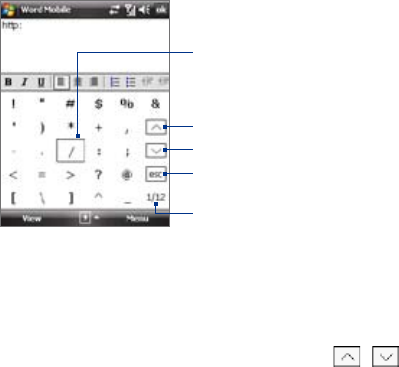
52 Entering and Searching Information
2.6 Using Symbol Pad
Symbol Pad provides a comprehensive list of common symbols such as
parentheses, braces, currency signs, and more, as well as punctuation marks
and special characters.
Tap a symbol to select it. Use the NAVIGATION
Control to navigate through the available
symbols, then press ENTER to select a symbol.
Tap to display the previous page of symbols.
Tap to display the next page of symbols.
Tap to close the Symbol Pad without
selecting any symbol.
This indicates the current page and the total
number of symbol pages.
To open the Symbol Pad and select a symbol
1. Create or open a document, such as a Word document.
2. To open the Symbol Pad, tap the Input Selector arrow, then tap
Symbol Pad.
3. To browse through the pages of symbols, tap / on the
Symbol Pad screen.
4. Tap a symbol to select it and close the Symbol Pad. The selected
symbol will then be inserted in your document.

Entering and Searching Information 53
2.7 Using Notes to Draw, Write, and Record Voice
Notes
Using Notes, you can draw directly on the screen, or write on the screen
and save notes in your own handwriting. You can also create a stand-alone
recording (voice note) or you can add a recording to a note.
For more information on what you can do with Notes, see “Notes” in
Chapter 6.
2.8 Searching Information
You can search for files and other items stored in My Documents folder or
on an installed storage card of your device. You can search by file name
or by words located in the item. For example, you can search in e-mail
messages, notes, appointments, contacts, and tasks, as well as in online
Help.
To search for a file or an item
1. Tap Start > Programs > Search.
2. In the Search for field, you can:
• Enter the file name, word, or other information you want to search
for.
• Tap the down arrow icon ( ), and from the list, select one item
that you have looked for before.
3. In the Type field, you can tap the down arrow icon ( ) and select a
data type from the list to help narrow your search.
4. Tap Search. The system then starts searching the matched files in the
My Documents folder and subfolders.
5. In the Results list, tap the item you want to open.
Note The storage card symbol or is displayed next to the names of files
saved on a storage card.
54 Entering and Searching Information

Chapter 3
Using Phone Features
3.1 Using the Phone
3.2 Making a Call
3.3 Receiving a Call
3.4 Smart Dialing
3.5 Additional Dialing Information
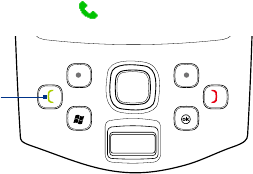
56 Using Phone Features
3.1 Using the Phone
Like a standard mobile phone, you can use your device to make, receive,
and keep track of calls and send messages. You can also dial directly
from Contacts, and easily copy phonebook entries from your SIM card to
Contacts on your device.
The Phone screen
From the Phone screen, you can access Call History, Speed Dial, and Phone
settings. To open the Phone screen, do one of the following:
• Tap Start > Phone.
• Press the TALK button ( ).
TALK button
Enter your PIN
Most SIM cards are preset with a PIN (personal identification number) that is
provided by your wireless service provider.
1. Enter the preset PIN assigned by your wireless service provider.
2. Tap Enter.
Note If your PIN is entered incorrectly three times, the SIM card will be blocked. If
this happens, you can unblock it with the PUK (PIN Unblocking Key) obtained
from your wireless service provider.

Using Phone Features 57
Turn the phone function on and off
In many countries, you are required by law to turn off the phone while on
board an aircraft.
To turn off the phone function
1. Tap Start > Programs > Comm Manager.
2. On the Comm Manager screen, tap the Phone button to turn off the
phone function.
The icon indicates the phone function is turned off.
To resume call function
Turn on the phone function by tapping the Phone button again on the
Comm Manager screen.
The icon indicates the phone function is turned on.
Airplane mode
Another way to turn off the phone function is to switch your device to
Airplane mode.
To enable Airplane mode
When you enable Airplane mode, it turns off all wireless radios on your
device, which include the phone function, Bluetooth, and Wi-Fi.
1. Tap Start > Programs > Comm Manager.
2. On the Comm Manager screen, tap the Airplane Mode button to
enable Airplane mode.
The icon indicates that Airplane mode is enabled.
To disable Airplane mode
When you disable Airplane mode, it turns the phone function back on.
This also restores the previous state of Bluetooth, but keeps Wi-Fi disabled.
Disable Airplane mode by tapping the Airplane Mode button again on the
Comm Manager screen.
The icon indicates that Airplane mode is disabled.
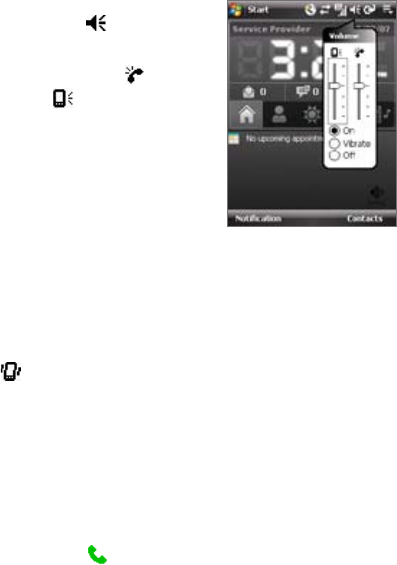
58 Using Phone Features
Adjust the device volume
1. Tap the Speaker icon ( ).
2. Under Volume, do the following:
• Adjust the phone volume ( ) or
device volume ( ) by moving the
slider to the desired volume level.
• Tap On, Vibrate, or Off to change both
the system and ringer volume settings.
You can also change the device volume
settings through the Sound tab on the
HTC Home. See Chapter 1 for details. Volume adjustment
Notes • To adjust the conversation phone volume, you must do it during a call.
Adjusting the volume at another time will affect the ring, notification, and
MP3 sound levels.
• When you activate Vibrate mode, sound will automatically be muted and
your device will vibrate when an incoming call is received. The Vibrate
icon ( ) will appear in the title bar to indicate that Vibrate mode is
activated.
3.2 Making a Call
With your device, you can make a call from Phone, Contacts, Speed Dial,
Call History, and SIM Manager.
Make a call from Phone
1. Press the TALK button ( ).
2. On the Phone screen, tap the desired phone number, then press the
TALK button.
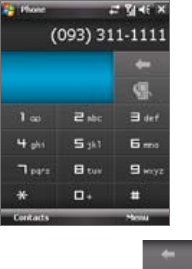
Using Phone Features 59
Tip If you tap a wrong number, tap Delete ( ) to erase each subsequent
digit of a number. To erase the entire number, tap and hold Delete.
Make a call from Contacts
Tap Contacts on the Today screen or tap Start > Contacts, then do one of
the following:
• Press NAVIGATION up or down to select a contact, and press TALK.
• Tap the desired contact in the contacts list, and tap the phone
number that you want to call.
• Tap and hold the desired contact, and on the shortcut menu,
tap Call Work, Call Home, or Call Mobile.
To choose one of the numbers of a contact to dial
By default, the mobile phone number (m) of a contact is dialed when you
make a call from Contacts. However, you can specify that a different phone
number is dialed instead.
1. Tap Start > Contacts.
2. Press NAVIGATION up or down to select the contact.
3. Press NAVIGATION left or right. The letters representing the number
will change as you scroll through them.

60 Using Phone Features
Make a call from Call History
1. On the Phone screen, tap Call History ( ) .
2. You can either scroll through all calls in Call History, or tap Menu >
Filter and select from a category of call types.
3. Scroll to the desired contact or phone number, and tap Call.
One-touch Speed Dial
Use Speed Dial to call frequently-used numbers with a single tap. For
example, if you assign a contact to the location 2 in Speed Dial, you can
simply tap and hold the number 2 key on the Phone screen to dial the
contact’s number. Before you can create a Speed Dial entry, the number
must already exist in Contacts.
To create a Speed Dial entry
1. On the Phone screen, tap Menu > Speed Dial.
2. Tap Menu > New.
3. Tap a contact. Select the phone number that you want to add to be
assigned with a speed dial key.
4. In the Location box, select an available key to use as the speed dial
key.
Note If you want to place a phone number in a position that is already occupied,
the new number will replace the number that is already there.
Tips • To create a Speed Dial entry from Contacts or SIM card contact, tap the
contact, select the number you want to add to Speed Dial and then tap
Menu > Add to Speed Dial.
• To delete a Speed Dial entry, in the Speed Dial list, tap and hold the
desired entry, and tap Delete.
To call voicemail
The number 1 key is generally reserved for your voicemail. Press and hold
this key to call voicemail.

Using Phone Features 61
Make a call from SIM Manager
SIM Manager allows you to view the contents of your SIM card, transfer SIM
phonebook entries to Contacts on your device, and make a call from your
SIM card.
To call a SIM contact
1. Tap Start > Programs > SIM Manager. Wait for your SIM card
contents to load.
2. Tap and hold the name or phone number of the person you want to
call, and tap Call.
For more information about SIM Manager, see Chapter 6.
3.3 Receiving a Call
When you receive a phone call, a message will appear, giving you the
option to either answer or ignore the incoming call.
To answer or reject an incoming call
• To answer the call, tap Answer, or press TALK on the device.
• To reject the call, tap Ignore, or press END on the device.
To end a call
Once an incoming or outgoing call is in progress, press END on the device
to hang up.
To check a missed call
You will see the icon on top of the screen when you missed a call. To
check who the caller is:
• Tap the icon , then tap View; or
• On the Phone screen, tap the Call History button ( ). You can
view missed calls as well as incoming and outgoing calls in Call
History.

62 Using Phone Features
To put a call on hold
Your device notifies you when you have another incoming call, and gives
you the choice of rejecting or accepting the call. If you are already on a call
and accept the new call, you can choose to switch between the two callers,
or set up a conference call between all three parties.
1. Tap Answer to take the second call, and put the first one on hold.
2. To end the second call and return to the first call, press END on the
device.
To switch between two calls
Tap Swap.
To set up a conference call
1. Either put a call on hold, and dial a second number; or, accept a
second incoming call when you already have one in progress.
2. Tap Menu > Conference.
Note Not all service providers support conference calling. Contact your service
provider for details.
To turn on and off the Speakerphone
The built-in Speakerphone on your device allows you to talk hands-free or
lets other people listen to the conversation.
• During a call, tap Speaker On, or press and hold TALK until the
speakerphone turns on. The speakerphone icon ( ) appears in the
title bar.
• To turn o the speakerphone, tap Speaker Off, or press and hold
TALK again until the speakerphone turns o.
Warning! To avoid damage to your hearing, do not hold your device against your ear
when the Speakerphone is turned on.
To mute a call
You can turn off the microphone during a call, so that you can hear the
caller but the caller cannot hear you.
• During a call, tap Mute.
• When the microphone is turned o, the mute icon ( ) appears on
the screen. Tap Unmute to turn on the microphone again.
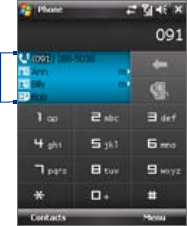
Using Phone Features 63
3.4 Smart Dialing
Smart Dialing makes it easy for you
to dial a phone number.
When you start entering a phone
number or contact name, Smart
Dialing will automatically search and
sort the contact entries on the SIM
card, in Contacts, and the phone
numbers in Call History (including
incoming, outgoing, and missed
calls). You can then select the desired
number or contact from the filtered
list to dial.
Smart
Dialing
panel
Tips on using Smart Dialing
Smart Dialing starts looking for numbers or contacts that match the
sequence you have entered. Below are some tips on how to use Smart
Dialing to quickly find a desired phone number or contact.
To find a phone number
• Simply enter the first one or two digits to find a phone number in Call
History.
• Enter the first three digits or more if you want to find a phone number
from the saved contacts on your device and SIM card.
To find a contact name
You can just enter the first letter of a contact’s first name or surname. Smart
Dialing will search for the letter starting from the first character of a contact
name as well as from the character that appears after a space, dash, or
underscore in a contact name. For example, if you tap number “2” which is
associated with [a, b, c] on the Phone keypad, contact names such as the
following will be considered matches: “Ben Miller”, “George Adams”, “John-
Carter”, “Carter, Ellen”, “Dixon, Allan”, “Thomas_Clark”, “JaneCampbell”.
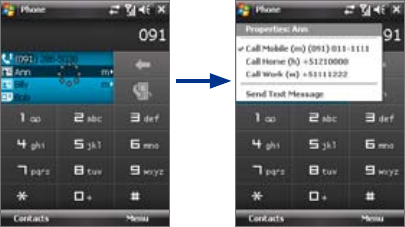
64 Using Phone Features
If the matching list is long and you want to narrow down the search further,
enter another letter. Using the same example above, if you continue to
tap “3” which is associated with [d, e, f], the matching list will be narrowed
down to the following names: “Ben Miller”, “George Adams”, “Carter, Ellen”,
“Dixon, Allan”.
Make a call or send a text message using Smart Dialing
1. Press the TALK button on your device to open the Phone screen.
2. Begin entering the first few numbers or characters.
When you start entering a number or letter, the Smart Dialing panel
will display matches found.
3. In the Smart Dialing panel, browse the list by sliding your finger or the
stylus up or down or by pressing NAVIGATION up or down.
4. You can do one of the following:
• When the desired contact is selected, press the TALK button to
place a call.
• To send a text message to the selected contact, tap and hold the
contact, and tap Send Text Message.
• To call a different phone number associated with the selected
contact, tap and hold the selected contact, and tap the phone
number you want to call.
Tap and hold the contact to pop up the shortcut menu.
Using Phone Features 65
Tip
To view or edit information associated with the selected contact, tap the
contact’s name on the shortcut menu (applies only to entries stored in
Contacts on your device).
Set up Smart Dialing
1. On the Phone screen, tap Menu > Smart Dialing Options.
2. On the Options tab, select the Enable Smart Dialing check box.
• Select the Automatically expand selected contact check box to
enable a contact’s name and phone number to be displayed when
the contact is selected in the matching list.
• Select the Enable drag-scroll check box to scroll in the matched
list by dragging.
• Select the Enable double-click for dialing check box to make a
voice call by double-tapping the item in the matched list.
3.5 Additional Dialing Information
Make an emergency call
Enter the international emergency number for your locale, and tap Call.
Tip Additional emergency numbers may be included in your SIM card. Contact
your service provider for details.
Make an international call
1. Tap and hold the number 0 key on the Phone keypad until the + sign
appears. The + replaces the international prefix of the country that
you are calling.
2. Enter the full phone number you want to dial, and tap Call. The full
phone number includes country code, area code (without the leading
zero, if any) and phone number.
66 Using Phone Features

Chapter 4
Setting Up Your PDA Phone
4.1 Basic Settings
4.2 Personalizing the Today Screen
4.3 Customizing Phone Settings and Services
4.4 Protecting Your Device
4.5 Using Fingerprint Sensor and
HTC Fingerprint Manager
4.6 Other Settings
68 Setting Up Your PDA Phone
4.1 Basic Settings
Owner information
Having owner information displayed on the Today screen makes it easier for
someone to return your device to you if it is lost.
To enter owner information
1. Tap Start > Settings > Personal tab > Owner Information.
2. On the Identification tab, enter your personal information.
Tip If you don’t see owner information on the Today screen, tap Start > Settings
> Personal tab > Today. On the Items tab, select the Owner Info check box.
To display owner information when the device is turned on
You can set your device to display the ‘my info’ screen when power is turned
on. This screen shows your complete personal information.
1. Tap Start > Settings > Personal tab > Owner Information.
2. On the Options tab, select the Identification information check box.
3. If you want additional text displayed, tap the Notes tab and enter the
text (for instance: Reward if found).
4. On the Options tab, select the Notes check box then tap OK.
Time and date
To set the time and date
1. Tap Start > Settings > System tab > Clock & Alarms > Time tab.
2. Select the correct time zone and change the date or time.
Note During synchronization, the time on your device is updated with the time on
your PC.
To set the time and date for a different location
If you visit or communicate with someone in a particular time zone often,
you can select it as your visiting time zone.
1. Tap Start > Settings > System tab > Clock & Alarms > Time tab.
2. Tap Visiting.
3. Select the correct time zone and change the time or date.
Setting Up Your PDA Phone 69
Regional settings
The style in which numbers, currency, dates, and times are displayed is
specified in regional settings.
1. Tap Start > Settings > System tab > Regional Settings.
2. On the Region tab, select your region from the list.
Note This does not change the Operating System language of your device.
3. The region you select determines which options will be available on
the other tabs.
4. To customize settings further, tap the appropriate tabs and select the
desired options.
4.2 Personalizing the Today Screen
The Today screen shows your upcoming appointments, active tasks, and
information about incoming messages. You can customize what to display
on the Today screen.
To customize the Today screen
1. Tap Start > Settings > Personal tab > Today.
2. On the Appearance tab, select the desired theme for the background
of the Today screen.
3. On the Items tab, select the items you want to appear on the Today
screen.
Tip To change the order of items displayed on the Today screen, tap the item,
and tap Move Up or Move Down.
To use a custom background image
You can use one of your own pictures as the background image on the
Today screen. Be aware that pictures can affect the readability of text on the
Today screen.
1. Tap Start > Settings > Personal tab > Today.
2. Select the Use this picture as the background check box, and tap
Browse to view a list of your picture files.
70 Setting Up Your PDA Phone
3. Tap the file name of the picture you want to use.
4. Tap OK.
To set options for displaying appointments on the Today screen
If you have a large number of appointments, you may want to specify the
kind of appointments that are displayed on the Today screen.
1. Tap Start > Settings > Personal tab > Today.
2. Tap the Items tab.
3. Select Calendar and tap Options.
4. Do any of the following:
• Select Next appointment to show only the next appointment
in your schedule, or Upcoming appointments to show multiple
appointments.
• Clear the Display all day events check box if you do not want to
display all-day events.
For more information about using Calendar, see Chapter 6 and 8.
To set options for displaying tasks on the Today screen
If you have a large number of tasks, you may want to specify the kind of
tasks that are displayed on the Today screen.
1. Tap Start > Settings > Personal tab > Today.
2. Tap the Items tab.
3. Select Tasks and tap Options.
4. Do any of the following:
• Under Display number of, select the type of tasks you want to
appear on the Today screen.
• In the Category list, select whether to display only tasks assigned
to a specific category or to display all tasks.
For more information about creating tasks on your device, see Chapter 6.
Setting Up Your PDA Phone 71
Customize the Start menu
You can choose which items appear in the Start menu.
1. Tap Start > Settings > Personal tab > Menus.
2. Select the check boxes of the items you want to appear in the Start
menu. You can select up to seven items.
Tip Create folders and shortcuts inside the folders, Programs and Office
Mobile, on the Start menu. Using Windows Explorer on your PC, navigate
to the /Windows/Start Menu/Programs or Office Mobile folder of your
device, then create the folders and shortcuts that you want. You will see the
added items on your device after you synchronize. For information about
synchronizing your device with the computer, see Chapter 5.
4.3 Customizing Phone Settings and Services
You can customize phone settings, such as the ring type and ring tone to
be used for incoming calls, and the keypad tone to be used when entering
phone numbers. You can also set up your device to use phone services such
as Call Waiting, Call Forwarding, and more.
To access phone settings and services
• Tap Menu > Options on the Phone screen; or
• Tap Start > Settings > Personal tab > Phone.
Ringer settings
To change the ring tone and ring type
1. On the Phone screen, tap Menu > Options > Phone tab.
2. In the Ring tone list, tap the sound you want to use.
Tip
You can use *.wav, *.mid, *.mp3, *.wma or other files (see “Specifications”
in the Appendix for a list of supported file formats) that you downloaded
from the Internet or copied from your PC as ring tones. Copy the sound
files first to the /Windows/Rings folder on your device, then select the
sound from the Ring tone list of your device. For more information about
copying files, see Chapter 9
.
3. In the Ring type list, choose whether to be notified of incoming calls
by a ring, a vibration, or a combination of both.
72 Setting Up Your PDA Phone
Keypad tone
You can change the tone you hear when entering a phone number on the
keypad. If set to Long tones, the tone is heard continuously for as long as
the number on the keypad is pressed. Use this setting if you are having
trouble accomplishing tasks that rely on tones from your device such as
accessing messages from an answering machine. If set to Short tones, the
tone is heard only for one or two seconds. If set to Off, no tone will be heard.
1. On the Phone screen, tap Menu > Options > Phone tab.
2. In the Keypad list, tap the option you want.
Phone services
Your device can directly link to the mobile phone network, and allow
you to access and change the settings of various phone services for your
device. Phone services may include Call Forwarding, Call Waiting, Voicemail,
and more. Contact your wireless service provider to find out about the
availability of phone services for your device.
To access and change settings of phone services
1. Tap Start > Settings > Personal tab > Phone > Services tab.
2. Select the service you want to use, then tap Get Settings.
3. Choose your desired options, then tap OK.
For more information about customizing settings of phone services, see
Help on your device.
Networks
You can view on your device which mobile phone networks are available
to you, and arrange them in the order that you want your device to access
them. For example, if your first preferred network is unavailable, your device
will try to access your second preferred network.
To view available networks
1. Tap Start > Settings > Personal tab > Phone > Network tab.
2. Under Network selection, select Manual. The list of available
networks is then displayed.
Setting Up Your PDA Phone 73
To set preferred networks
1. Tap Start > Settings > Personal tab > Phone > Network tab.
2. Tap Set Networks and follow the instructions on the screen to
arrange the networks according to your preference.
3. After arranging the networks in the preferred order, tap OK to return
to the Network tab.
4. In the Network selection list, select Automatic.
5. Tap OK.
4.4 Protecting Your Device
Protect your USIM/SIM card with a PIN
You can protect your USIM/SIM card from unauthorized use by assigning a
PIN (personal identification number). Your first PIN will be given to you by
your wireless service provider; you can change the PIN later.
1. On the Phone screen, tap Menu > Options > Phone tab.
2. Select the Require PIN when phone is used check box.
3. To change the PIN at any time, tap Change PIN.
Tip Emergency calls can be placed at any time, without requiring a PIN.
Protect your device with a password
You can help keep your data more secure by requiring a password every
time the device is turned on. You create your own password when you
begin using your device.
To set a device password
1. Tap Start > Settings > Personal tab > Lock.
2. Select the Prompt if device unused for check box, and in the box to
the right, select how long your device must be idle before a password
is required. In the Password type box, select the type of password
you would like to use. Enter and confirm the password.
If your device is configured to connect to a network, use an
alphanumeric password for increased security for your device.
74 Setting Up Your PDA Phone
3. On the Hint tab, enter a phrase that will help you remember your
password, but does not allow others to guess your password.
4. Tap OK. The next time the device is turned on, you will be prompted
to enter your password.
Notes • To ensure you can always make emergency calls, do not begin your
password with the digits of your local emergency number.
• The hint will be displayed after the wrong password is entered five times.
To unlock your device
1. Enter your device password when you are prompted.
2. Tap Unlock.
Note If you forget your password, you can hard reset or clear the device memory.
Before you do this, make sure you back up your data and files to your PC so
that you can restore them back to your device. See Chapter 9 for details.
Encrypt data on your storage card
1. On the Today screen, tap Start > Settings > System tab >
Encryption.
2. Select Encrypt files placed on storage cards.
Notes • Encrypted files can be read only on the device that encrypted them.
• Encrypted files are opened just like other files, provided you are using the
device that encrypted them. There is no separate step for you to take to
read these files.
Important If Encrypt files placed on storage cards is or was enabled before, then
backup all files from the storage card before using Clear Storage, hard
reset or updating the ROM system software. Otherwise you will no longer
be able to access the encrypted files on the storage card. Use ActiveSync
or Windows Mobile Device Center to transfer files between your storage
card and computer. After the procedure, copy your files back to the
storage card.
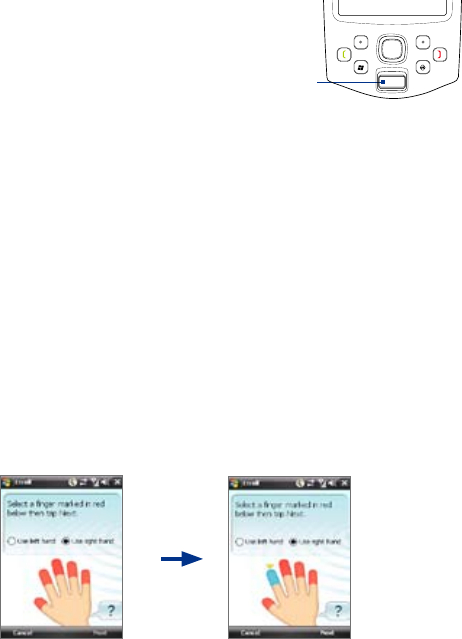
Setting Up Your PDA Phone 75
4.5 Using Fingerprint Sensor and HTC Fingerprint
Manager
Your device features a fingerprint sensor,
which you can find on the lower side of
the device. Your device is pre-installed
with HTC Fingerprint Manager, the
fingerprint recognition software, which
provides an extra layer of data security to
protect your device and personal data
.
Fingerprint
Sensor
The HTC Fingerprint Manager software includes fingerprint authentication
to access user credentials for logging on to the device and encrypting/
decrypting files.
Enroll your fingerprint
When you turn on your device for the first time, the Quick Setup Wizard will
prompt you to enroll your fingers. Enrolling your fingers then activates the
fingerprint sensor on your device. You can however enable the fingerprint
sensor by launching
the HTC Fingerprint Manager software on your device.
The first time you use the HTC Fingerprint Manager software, a wizard
will guide you through enrolling your fingerprints and setting up data
protection.
To run the wizard
1. Tap Start > Settings > System tab > Lock.
2. On the Enroll screen, select which fingerprint you want to enroll by
tapping the corresponding finger on the screen. Tap Next.
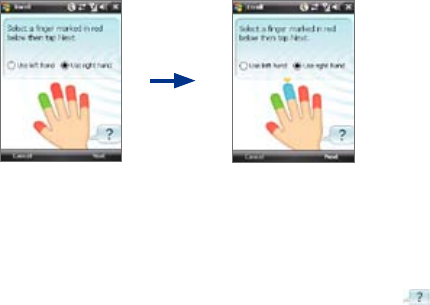
76 Setting Up Your PDA Phone
3.
After selecting a finger to enroll, you are prompted to swipe your finger
across the fingerprint sensor.
4. Repeat this procedure at least four times to register your fingerprint.
When you have successfully registered, you will be prompted to enroll
another fingerprint. Tap OK to proceed.
5. Select another finger to enroll and repeat the previous steps, or tap
Next to continue.
6. After you are done, tap No if you do not want to enroll any more
fingers.
7. Tap Finish.
For more information on how to use HTC Fingerprint Manager, tap or
see Help on your device.
Authentication
After enrolling one or more of your fingerprints, HTC Fingerprint Manager
will prompt for fingerprint authentication whenever you log on to your
device. Swipe a finger that has an enrolled fingerprint on the fingerprint
sensor to log on and access your device data.
If you have enrolled your fingers while setting up your device for the first
time, then the Authenticate screen of HTC Fingerprint Manager will appear
every time you power on your device, and prompt you to swipe your enrolled
fingers on the fingerprint sensor. After your fingerprints are authenticated,
you will be allowed to log on to the device and access your personal data.
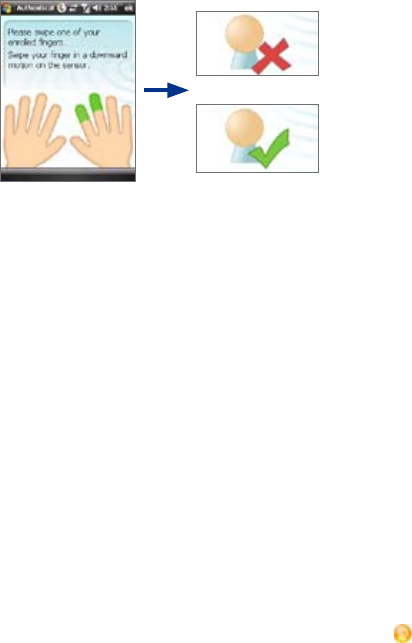
Setting Up Your PDA Phone 77
Indicates that
authentication failed.
If this happens, swipe
your finger again.
Indicates that
authentication
is successful.
Fingerprint authentication is also required before you change any of the
HTC Fingerprint settings or encrypt/decrypt files on your device. When you
see HTC Fingerprint Manager’s Authentication window, swipe your enrolled
finger over the fingerprint sensor.
Encrypt/Decrypt files with fingerprint security
You can encrypt files and restrict read and write access to the files only to
yourself by requiring fingerprint authentication.
If you have not yet enrolled your fingerprints, you will be automatically
prompted to do so while start encrypting one or more files. Similarly, you can
decrypt and access a protected file only if you swipe your enrolled fingers
and find a match with the enrolled fingerprints stored on your device.
To encrypt files
1. Tap Start > Programs > HTC Fingerprint Manager.
2. In the horizontally or vertically split explorer screen, select the check
box(s) corresponding to the file(s) you want to encrypt.
3. Tap Encrypt.
4. Swipe a finger that has an enrolled fingerprint over the fingerprint
sensor. Your identity is then authenticated.
5. The file is being processed. Tap OK to confirm.
6. The files are protected and a fingerprint secured icon appears on
the file.
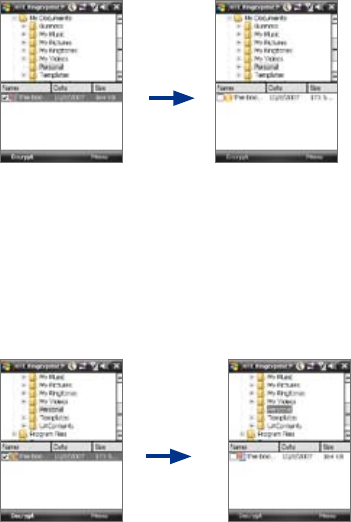
78 Setting Up Your PDA Phone
To decrypt files
1. Tap Start > Programs > HTC Fingerprint Manager.
2. In the horizontally or vertically split explorer screen, select the check
box corresponding to the encrypted file(s) that you want to decrypt.
3. Tap Decrypt.
4. Swipe a finger that has an enrolled fingerprint over the fingerprint
sensor. Your identity is then authenticated.
5. The file is being processed. Tap OK to confirm decrypting the file.
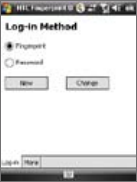
Setting Up Your PDA Phone 79
HTC Fingerprint Manager settings
HTC Fingerprint Manager allows you to enroll new fingerprints, change or
remove enrolled fingerprints, set new password, change existing password,
and choose a log-in method. You can also set options to notify you when a
read-only file is encrypted/decrypted or to just display the results after any
encryption/decryption process is completed.
To configure HTC Fingerprint Manager
1. Tap Start > Settings > Personal tab > HTC Fingerprint Options.
2. When you see the Authentication window, swipe your finger on the
fingerprint sensor.
3. In Log-in Method, choose the method using which you want to log
on to your device or access device data.
4. Do any of the following:
• Tap New to enroll a new fingerprint.
• Tap Change to change/remove an
enrolled fingerprint.
• Tap the More tab to select the
options for viewing encryption and
decryption notifications and results.
If you have selected Fingerprint as the Log-in Method, you will be
prompted to unlock your device by authenticating your fingerprints before
you can synchronize your device with a PC via ActiveSync. Similarly, if you
have selected Password as the Log-in Method, the PC will prompt you
to provide the set password and unlock your device before you can start
synchronization.
80 Setting Up Your PDA Phone
4.6 Other Settings
Device name
The device name is used to identify your device in the following situations:
• Synchronizing with a PC
• Connecting to a network
• Restoring information from a backup
Note If you synchronize multiple devices with the same PC, each device must have
a unique name.
To change the device name
1. Tap Start > Settings > System tab > About.
2. Tap the Device ID tab.
3. Enter a name.
Note The device name must begin with a letter, consist of letters from A to
Z, numbers from 0 to 9, and cannot contain spaces. Use the underscore
character to separate words.
Display settings
To adjust screen brightness
1. Tap Start > Settings > System tab > Backlight.
2. On the Brightness tab, move the slider right to increase the
brightness, or left to decrease the brightness.
To set the backlight to dim after a time delay
1. Tap Start > Settings > System tab > Backlight.
2. Tap the Battery power tab, or the External power tab.
3. Select the Turn off backlight if device is not used for check box, and
specify the time delay.
To increase or decrease the size of text on the screen
1. Tap Start > Settings > System tab > Screen > Text Size tab.
2. Move the slider to increase or decrease the text size.
Setting Up Your PDA Phone 81
Button settings
To reassign programs or shortcuts to program buttons
Your device may come with programs already assigned to hardware
buttons. You can customize these buttons to open the programs you
often use, or to perform certain shortcuts, such as changing the screen
orientation, opening the Today screen, or opening Input Panel.
1. Tap Start > Settings > Personal tab > Buttons.
A list of buttons and their current assignments are displayed on the
Program Buttons tab.
2. Tap the button you want to reassign. To help you identify the buttons,
there are numbers and icons representing the original function of the
button.
3. In the Assign a program box, tap the program or shortcut you want
to assign.
4. Tap OK.
Word completion options
Word completion helps you enter text faster by suggesting words as you
enter letters using the input methods. You can set the number of suggested
words to display, when to show the word list, and more.
1. Tap Start > Settings > Personal tab > Input > Word Completion tab.
2. Make sure the Suggest words when entering text check box is
selected.
3. By default, the suggested word list appears whenever you enter a
space. To make the word list appear after letters are entered, select
the number of letters that you want to be entered before displaying
the word list.
4. The suggested word list shows up to four words by default. You can
change the number of words to display in the suggested list.
5. Make sure the Enable Auto Correct check box is selected if you want
mistyped words to be corrected automatically.
Tip The word database learns and adds more words as you enter new words
during text entry. To delete the added words and reset the database back to
the default, tap Clear Stored Entries.

82 Setting Up Your PDA Phone
Alarms and notifications
To set an alarm
1. Tap Start > Settings > System tab > Clock & Alarms > Alarms tab.
2. Tap <Description> and enter a name for the alarm.
3. Tap the day of the week for the alarm. You can select multiple days by
tapping each desired day.
4. Tap the time to open a clock and set the time for the alarm.
5. Tap the alarm icon ( ) to specify the type of alarm you want. You
can choose a ashing light, a single sound, a repeating sound, or
vibration.
6. If you choose to play a sound, tap the list next to the Play sound
check box and tap the sound you want.
To choose how to be notified about events or actions
1. Tap Start > Settings > Personal tab > Sounds & Notifications.
2. On the Sounds tab, choose how you want to be notified by selecting
the appropriate check boxes.
3. On the Notifications tab, in Event, select an event name and choose
how you want to be notified by selecting the appropriate check
boxes. You can choose from several options, such as a special sound, a
message, or a ashing light.
Tip Turning off sounds and the flashing light helps conserve battery power.

Chapter 5
Synchronizing Information
with Your Computer
5.1 About Synchronization
5.2 Setting Up Windows Mobile® Device Center
on Windows Vista
5.3 Setting Up ActiveSync® on Windows XP
5.4 Synchronizing with Your Computer
5.5 Synchronizing via Bluetooth
5.6 Synchronizing Music and Video
84 Synchronizing Information With Your Computer
5.1 About Synchronization
You can take information from your computer wherever you go by
synchronizing them to your device. The following types of information can
be synchronized between your computer and your device:
• Microsoft® Office Outlook® information, which include Outlook
e-mail, contacts, calendar, tasks, and notes
• Media, such as pictures, music and video
• Favorites, which are the bookmarked links to your favorite Web sites
• Files, such as documents and other files
Before you can synchronize, you need to install and set up first the
synchronization software on your computer. For more information, see
“Setting Up Windows Mobile Device Center on Windows Vista®” if you are
using Windows Vista®, or see “Setting Up ActiveSync on Windows XP” if you
are using Windows XP®.
Ways to synchronize
After you have installed the synchronization software to your computer,
connect and synchronize your device with your computer by using one of
the following methods:
• Connect and synchronize using the supplied USB sync cable.
Upon connecting the sync cable to your device and your computer,
the synchronization process starts automatically.
• Connect and synchronize using Bluetooth.
You must first set up a Bluetooth partnership between your device
and your computer before you can synchronize information between
them using Bluetooth. For more information about setting up
a Bluetooth partnership, see Chapter 10. For information about
synchronizing through Bluetooth, see “Synchronizing via Bluetooth”
later in this chapter.
Synchronizing Information With Your Computer 85
Try to synchronize frequently in order to keep information up-to-date in
both your device and your computer.
Note You can also synchronize Outlook e-mail, contacts, calendar, and tasks on
your device with the Exchange Server at your work. For more information
about setting up your device to synchronize with the Exchange Server, see
Chapter 8.
5.2 Setting Up Windows Mobile® Device Center on
Windows Vista
Windows Mobile® Device Center is the replacement for Microsoft®
ActiveSync® on Windows Vista®.
Note Some versions of Windows Vista come with Windows Mobile Device Center
already installed. If Windows Mobile Device Center is not available on your
Windows Vista, you can install it from the Getting Started Disc that came with
your device.
Set up synchronization
When you connect your device to your PC and start Windows Mobile
Device Center for the first time, you are asked to create a Windows
Mobile® partnership with your device. Follow the steps below to create a
partnership.
1. Connect your device to your PC. Windows Mobile Device Center
configures itself and then opens.
2. On the license agreement screen, click Accept.
3. On the Windows Mobile Device Center’s Home screen, click Set up
your device.
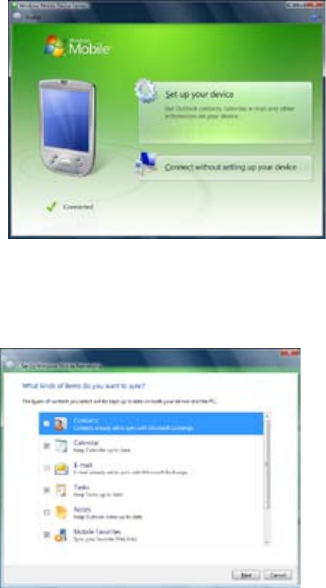
86 Synchronizing Information With Your Computer
Note Choose Connect without setting up your device if you only want to
transfer media files, check for updates, and explore your device but not
sync Outlook information.
4. Select the information types that you want to synchronize, then click
Next.
5. Enter a device name and click Set Up.
When you finish the setup wizard, Windows Mobile Device Center
synchronizes your device automatically. Notice that Outlook e-mails and
other information will appear on your device after synchronization.
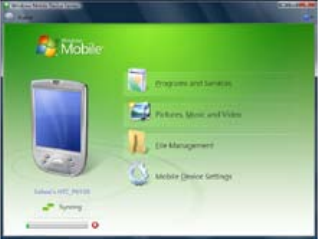
Synchronizing Information With Your Computer 87
Use Windows Mobile Device Center
To open Windows Mobile Device Center, click Start > All Programs >
Windows Mobile Device Center on your Windows Vista computer.
On Windows Mobile Device Center, you can do the following:
• Click Mobile Device Settings to view and change synchronization
settings.
• When you click Pictures, Music and Video > __ new pictures/
video clips are available for import, a wizard guides you to tag
and transfer photos from your device to the Photo Gallery on your
Windows Vista PC.
• Click Pictures, Music and Video > Add media to your device from
Windows Media Player to your device to synchronize music and
video files using Windows Media® Player. For more information, see
“Using Windows Media® Player Mobile” in Chapter 12.
• Click File Management > Browse the contents of your device to
view documents and files from your device.
Note See Windows Mobile Device Center Help for more information.
88 Synchronizing Information With Your Computer
5.3 Setting Up ActiveSync® on Windows XP
The Getting Started Disc that comes with your device contains Microsoft
ActiveSync 4.5 or later. Follow the steps in this section to install and set up
ActiveSync on Windows XP or other compatible Windows systems.
Note For a list of compatible Windows systems, please go to
http://www.microsoft.com/windowsmobile/activesync/activesync45.mspx.
Install ActiveSync
1. Insert the Getting Started Disc into the disc drive on your PC.
2. ActiveSync is available in English and several other languages. Select
the desired language then click Next.
3. Click Setup and Installation.
4. Select the ActiveSync check box and click Install.
5. Read the license terms and click Accept.
6. When installation is complete, click Done.
7. On the Getting Started with Windows Mobile® screen, click Close.
Set up synchronization
Follow the steps below to set up a synchronization partnership.
1. Connect your device to your PC. The Synchronization Setup Wizard
automatically starts and guides you to create a synchronization
partnership. Click Next to proceed.
2. To synchronize your device with your PC, clear the Synchronize
directly with a server running Microsoft Exchange check box then
click Next.
3. Select the information types that you want to synchronize then click
Next.
4. Select or clear the Allow wireless data connections check box
according to your preference.
5. Click Finish.

Synchronizing Information With Your Computer 89
When you finish the wizard, ActiveSync synchronizes your device
automatically. Notice that Outlook e-mails and other information will
appear on your device after synchronization.
5.4 Synchronizing with Your Computer
Connect and synchronize your device with your PC using the USB cable or
Bluetooth connection.
Start and stop synchronization
You can manually synchronize either from your device or PC.
From your device
1. Tap Start > Programs > ActiveSync.
2. Tap Sync.
To end synchronization before it completes, tap Stop.
Tip To delete a partnership with one PC completely, tap Menu > Options, tap
the computer name, then tap Delete. Your device must not be connected to
the PC for this option to be available.
From Windows Mobile Device Center
1. Click Start > All Programs > Windows Mobile Device Center.
2. Click at the lower left of the Windows Mobile Device Center.
To end synchronization before it completes, click .
From ActiveSync on your PC
When you connect your device to your PC, ActiveSync automatically opens
on your PC and synchronizes.
• To manually start synchronization, click .
• To end synchronization before it completes, click .

90 Synchronizing Information With Your Computer
Change which information is synchronized
You can change the information types and the amount of information to
synchronize for each type either on your device or your PC. Follow the steps
below to change synchronization settings on your device.
Note Before changing synchronization settings on your device, disconnect it from
your PC.
1. In ActiveSync on your device, tap Menu > Options.
2. Select the check box for any items you want to synchronize. If you
cannot select a check box, you might have to clear the check box for
the same information type elsewhere in the list.
3. To change synchronization settings for an information type, for
instance, E-mail, select it and tap Settings.
You can then set the download size limit, specify the time period of
information to download, and more.
Notes • Some information types such as Favorites, Files and Media cannot be
selected in ActiveSync Options on your device. You can only select or clear
these items from your PC’s Windows Mobile Device Center or ActiveSync.
• A PC can have sync partnerships with many different Windows Mobile®
powered devices, but a device can have sync partnerships with at most
two PCs only. To ensure that your device will synchronize properly with
both PCs, set up the second PC using the same synchronization settings
you used on the first PC.
• Outlook e-mail can be synchronized with only one computer.
Troubleshoot sync connection problem
When the PC is connected to the Internet or a local network, in some cases,
the PC may disconnect the connection with your device in favor of the
Internet or network connection.
If this happens, tap Start > Settings > Connections tab > USB to PC, then
clear the Enable advanced network functionality check box. This makes
your PC utilize a serial USB connection with your device.
The USB to PC ( ) icon appears on the Today Screen when serial USB
connection is used.
Synchronizing Information With Your Computer 91
5.5 Synchronizing via Bluetooth
You can connect and synchronize your device with the PC using Bluetooth.
Note To connect and synchronize your device with a computer via Bluetooth, your
computer must have built-in Bluetooth or installed with a Bluetooth adapter
or dongle.
To synchronize with a computer via Bluetooth
1. Set up Windows Mobile Device Center or ActiveSync on your PC
to synchronize through Bluetooth. See the program’s Help for
instructions.
2. On your device, tap Start > Programs > ActiveSync.
3. Make sure that Bluetooth on both your device and the computer
are turned on and set to visible mode. For more information, see
“Bluetooth” in Chapter 10.
4. Tap Menu > Connect via Bluetooth. Make sure the Bluetooth
function of both your device and the computer are turned on and set
to visible mode.
5. If this is the first time you have connected to this computer via
Bluetooth, you must first complete the Bluetooth wizard on your
device and set up a Bluetooth partnership between your device
and the computer. For more information about creating a Bluetooth
partnership, see “Bluetooth partnerships” in Chapter 10.
Note To conserve battery power, turn off Bluetooth when not in use.
92 Synchronizing Information With Your Computer
5.6 Synchronizing Music and Video
If you want to carry your music or other digital media along with you while
you travel, set up Windows Media® Player on your computer to synchronize
music and video with your device.
Other than selecting the Media information type to be synchronized, all
media synchronization settings must be set in Windows Media® Player.
Before media can be synchronized, you must do the following:
• Install Windows Media® Player Version 11 on the PC. (Windows Media®
Player 11 works only in Windows XP or later versions).
• Connect your device to the PC with a USB cable. If your device is
currently connected using Bluetooth, you must end that connection
before media can be synchronized.
• Set up a sync partnership between your device and your PC’s
Windows Media® Player.
For more information about using Windows Media® Player on your device,
see Chapter 12.

Chapter 6
Organizing Contacts,
Appointments, Tasks, and
Other Information
6.1 Managing Your Phonebook
6.2 Contacts
6.3 SIM Manager
6.4 Calendar
6.5 Tasks
6.6 Notes
94 Organizing Contacts, Appointments, Tasks, and Other Information
6.1 Managing Your Phonebook
Your PDA phone gives you several ways to store and manage phone
numbers and other information about your contacts.
• Use Contacts to create and save contacts on your device’s memory or
your USIM/SIM card.
• Use SIM Manager to store and manage USIM/SIM contacts.
6.2 Contacts
Contacts is your address book and information storage for the people and
businesses you communicate with. There are three types of contacts that
you can create on your device:
• Microsoft® Office Outlook® contacts. Contacts that are stored on
your device, which can be created on your device or synchronized
with your PC or the Exchange Server. For each contact, you can store
phone numbers, e-mail addresses, instant messaging (IM) names,
company and home addresses, and information such as a job title,
birthday, and a lot more. You can also add a picture and assign a ring
tone to an Outlook contact.
• USIM/SIM contacts. Contacts that are stored on the USIM/SIM card.
Only the name and a phone number can be stored for each entry.
• Windows Live™ contacts. Contacts that you communicate with using
Windows Live™ Messenger or MSN. Just like Outlook contacts, you
can also enter complete information for a Windows Live™ contact. For
more information, see “Add Windows Live™ contacts” in Chapter 10.
Note You can only add Windows Live™ contacts after you have set up
Windows Live™ on your device.
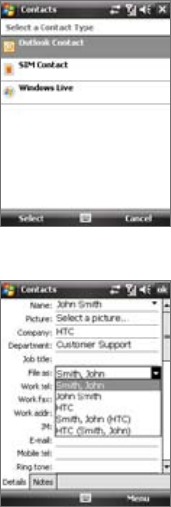
Organizing Contacts, Appointments, Tasks, and Other Information 95
Add new contacts
To add a contact on your device
1. Tap Start > Contacts.
2. Tap New, select Outlook Contact, and enter the contact information.
3. In the File as field, choose how you want the contact name to appear
in the contact list.
4. To add a photo of the contact, tap Select a picture, then select
the picture file or tap Camera to take a photo of the contact. This
photo appears on the Phone screen when you receive a call from the
contact.
96 Organizing Contacts, Appointments, Tasks, and Other Information
5. To assign a ring tone to the contact, tap the Ring tone field, scroll
through the list of tones, then select a desired tone.
6. When finished, tap OK.
Tips • If someone who is not in your list of contacts calls you, you can create a
contact from Call History by tapping and holding a phone number and
then tapping Save to Contacts from the shortcut menu.
• To save a phone number that is contained in a message, tap the phone
number, then tap Menu > Save to Contacts.
• To edit contact information, tap the contact name then tap Menu > Edit.
To add a contact to your USIM/SIM card
1. Tap Start > Contacts.
2. Tap New then select SIM Contact.
3. Enter a contact name and phone number.
4. Tap OK.
Tip You can also use the SIM Manager to add and edit contacts on your USIM/
SIM card. For more information, see "SIM Manager" later in this chapter.
Organize and search
To group similar contacts
You can group similar contacts for easier management by assigning them
to categories.
1. Create a new Outlook contact, or select an existing Outlook contact
to edit.
2. Tap Categories.
3. Select a preset category such as Business or Personal, or tap New to
create your own category.
4. When finished, tap OK.
To view contacts by category, tap Menu > Filter then select the desired
category.
Note If your contact list has been filtered by a category, that category is
automatically assigned when you create a new contact.
Organizing Contacts, Appointments, Tasks, and Other Information 97
To work with the contact list
There are several ways to use and customize the contact list. Here are a few
tips:
1. Tap Start > Contacts.
2. In the contact list, do any of the following:
• In Name view, you can search for a contact by entering a name
or number, or by using the alphabetical index. To switch to Name
view, tap Menu > View By > Name.
• To see a summary of information about a contact, tap the contact.
From there you can also make a call or send a message.
• To see a list of available actions for a contact, tap and hold the
contact.
• To see a list of contacts employed by a specific company, tap
Menu > View By > Company, then tap the company name.
To find a contact on your device
There are several ways to find a contact when your contact list is long.
1. Tap Start > Contacts.
2. If you are not in Name view, tap Menu > View By > Name.
3. Do one of the following:
• Begin entering a contact name in the provided text box until the
contact you want is displayed. To show all contacts again, clear the
text box.
• Use the alphabetical index displayed at the top of the contact list.
• Filter the list by categories. In the contact list, tap Menu > Filter,
then tap a category you’ve assigned to a contact. To show all
contacts again, select All Contacts.
98 Organizing Contacts, Appointments, Tasks, and Other Information
Share contact information
To beam a contact’s details
You can quickly send contact information to another mobile phone or
device through Bluetooth beaming.
1. Tap Start > Contacts, then select a contact.
2. Tap Menu > Send Contact > Beam.
3. Select a device where to beam the contact.
Note Before you can beam, make sure Bluetooth is turned on and set to visible
mode on your device and the target mobile device. You can also beam
contact information to your PC. For more information, see "Bluetooth" in
Chapter 10.
To send contact information via text messaging
1. Tap Start > Contacts, then select a contact.
2. Tap Menu > Send Contact > SMS \ MMS.
3. Select the contact information you want to send, then tap Done.
4. In the new text message, enter the mobile phone number of the
recipient, then tap Send.
To send contact information as a vCard
A vCard (virtual business card) is a standard file format used for exchanging
contact information. vCard files can be exported to Outlook on the PC. From
your device, you can send a vCard containing contact information as a file
attachment in an MMS message.
1. Tap Start > Contacts, then select a contact.
2. Tap Menu > Send as vCard.
3. A new MMS message is created with the vcard file attached. Enter
the mobile phone number or e-mail address of the recipient then tap
Send.
For more information, see “MMS” in Chapter 7.
Organizing Contacts, Appointments, Tasks, and Other Information 99
6.3 SIM Manager
SIM Manager allows you to view the contents of your USIM/SIM card,
transfer contacts from your USIM/SIM card to your device or vice versa, and
make a call to a USIM/SIM contact.
To create a contact on your USIM/SIM card
1. Tap Start > Programs > SIM Manager.
2. Tap New and enter a contact name and phone number.
3. Tap Save to save the information on your USIM/SIM card.
Tip: To change contact information on your USIM/SIM card, tap a USIM/SIM
contact and edit it. After modifying, tap Save.
To copy USIM/SIM contacts to your device
If you have saved contacts on your USIM/SIM card, you can copy them into
Contacts on your device.
1. Tap Start > Programs > SIM Manager.
2. Select the desired item, or select all USIM/SIM contacts by tapping
Menu > Select All.
3. Tap Menu > Save to Contacts.
To copy contacts to the USIM/SIM card
Only one phone number per contact name can be stored on a USIM/SIM
card. When you copy a contact that has several phone numbers to your
USIM/SIM card, SIM Manager saves each number under a separate name.
To save each number under a different contact name on the USIM/SIM card,
SIM Manager appends an indicator at the end of each name. By default,
/M, /W and /H are appended to indicate mobile, work and home phone
numbers respectively. You can edit this indicator first before you start
copying contacts to your USIM/SIM card. Indicators of the other types of
phone numbers are left empty for you to define them.
1. Tap Start > Programs > SIM Manager, then tap Menu > Tools >
Options.
2. Select the check boxes of the types of phone numbers that you want
to be added to the USIM/SIM card.
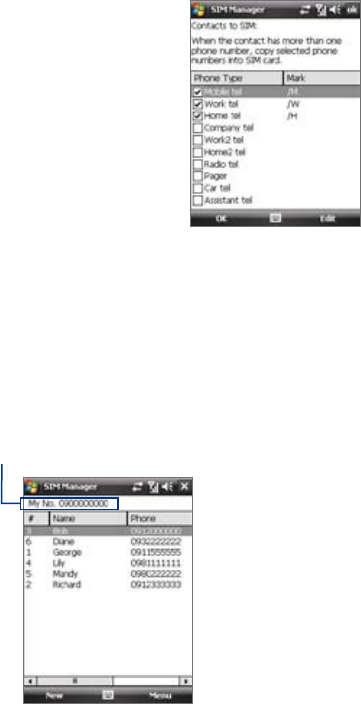
100 Organizing Contacts, Appointments, Tasks, and Other Information
3. Under the Mark column, you
can change the indicator that
will be appended to the USIM/
SIM contact names for each
phone number type. To do so,
select a phone type, tap Edit,
enter your desired indicator,
then tap Save.
4. After modifying, tap OK.
5. Tap Menu > Contacts to SIM.
6. Select the check boxes of the
contact’s phone numbers
that you want to copy to your
USIM/SIM card, then tap Save.
To store your USIM/SIM card’s phone number
1. On the SIM Manager screen, tap Menu > Tools > List of Own
Numbers.
2. Tap [Owner Information name].
3. Change the name, if desired, then enter your mobile phone number.
4. Tap Save.
When your phone number is stored on the USIM/
SIM card, it will appear on the SIM Manager screen.
Organizing Contacts, Appointments, Tasks, and Other Information 101
6.4 Calendar
Use Calendar to schedule appointments, including meetings and other
events. Your appointments for the day can be displayed on the Today
screen. If you use Outlook on your PC, you can synchronize appointments
between your device and PC. You can also set Calendar to remind you of
appointments with a sound or flashing light, for example.
Create appointments
To schedule an appointment
1. Tap Start > Calendar.
2. Tap Menu > New Appointment.
3. Enter a name for the appointment.
4. Do one of the following:
• If it is a special occasion such as a birthday or a whole-day event,
set the All Day option to Yes.
• If there is a time frame for the appointment, select the start and
end dates and time.
5. Specify the type of category for your appointment, so that it can be
grouped with other related appointments. Tap Categories, then
select a preset category (Business, Holiday, Personal, or Seasonal), or
tap New to create your own category.
6. When finished, tap OK to return to the calendar.
Notes • All-day events do not occupy blocks of time in Calendar; instead, they
appear in banners at the top of the calendar.
• To cancel an appointment, tap the appointment and tap Menu > Delete
Appointment.
Tips To have the time entered automatically in Day view, tap the time slot for the
new appointment, and tap Menu > New Appointment.
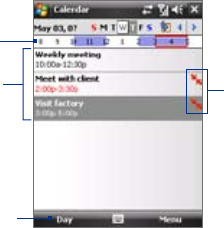
102 Organizing Contacts, Appointments, Tasks, and Other Information
To set a default reminder for all new appointments
You can have a reminder automatically turned on for all new appointments
you schedule.
1. Tap Start > Calendar.
2. Tap Menu > Tools > Options > Appointments tab.
3. Select the Set reminders for new items check box.
4. Set the time when you want the reminder to alert you.
5. Tap OK to return to the calendar.
View appointments
By default, Calendar displays appointments in Agenda view. You can also
look at your appointments in Day, Week, Month, and Year views.
The highlighted hours
here indicate the time of
your appointments.
Tap to view appointment
details.
Agenda view
Tap to switch views.
Indicates
that there
is a conflict
with another
appointment.
• To see detailed appointment information in any view, tap the
appointment.
• To view appointments by category, tap Menu > Filter then select the
desired category.
• To change the default view that Calendar uses to display
appointments, tap Menu > Tools > Options > General tab. Tap the
Start in box then choose the calendar view.

Organizing Contacts, Appointments, Tasks, and Other Information 103
• When in Month view, you will see the following indicators:
Morning appointment
Afternoon or evening appointment
Both morning and afternoon/evening appointments
All-day event
Send appointments
To send a meeting request
Use Calendar to schedule meetings via e-mail with contacts who use
Outlook or Outlook Mobile.
1. Tap Start > Calendar.
2. Schedule a new appointment, or open an existing one and tap Edit.
3. Tap Attendees then add the contacts whom you want to invite.
Note You can specify if an attendee is required or optional only if your
device is connected to a Microsoft Exchange 2007 server. Otherwise,
all attendees are designated as required. For more information, see
Chapter 8.
4. Tap the name of the contact you want to invite.
5. To invite each additional attendee, tap Add Required Attendee or
Add Optional Attendee and tap the name.
6. Tap OK to send.
Tip To choose the e-mail account to use for sending meeting requests, tap
Menu > Tools > Options > Appointments tab. Tap the Send meeting
requests via box and choose to send via your Outlook E-mail, POP3/IMAP4
or Windows Live™ account.
Notes • If you’re sending the meeting request using your Outlook E-mail account,
it will be sent to the attendees the next time you synchronize your device
with your PC or Exchange Server.
• When attendees accept your meeting request, the meeting is
automatically added to their schedules. When their response is sent back
to you, your calendar is updated as well.
104 Organizing Contacts, Appointments, Tasks, and Other Information
To send appointment details as a vCalendar
A vCalendar is a standard file format used for exchanging scheduling and
task information. vCalendar files can be exported to Outlook on the PC.
Tap Menu > Send as vCalendar to send a vCalendar containing
appointment details as a file attachment in an message. For more
information, see “MMS” in Chapter 7.
6.5 Tasks
Use Tasks to keep track of things you need to do. A task can occur once or
repeatedly (recurring). You can set reminders for your tasks and you can
organize them using categories.
Your tasks are displayed in a task list. Overdue tasks are displayed in red.
To create a task
1. Tap Start > Programs > Tasks.
2. Tap Menu > New Task, enter a subject for the task, and fill in
information such as start and due dates, priority, and so on.
3. Specify the type of category for your task, so that it can be grouped
with other related tasks. Tap Categories, then select a preset category
(Business, Holiday, Personal, or Seasonal), or tap New to create your
own category.
4. When finished, tap OK.
Tip You can easily create a short, to-do type task. Simply tap the Tap here to add
a new task box, enter a subject, and tap the Enter button on the on-screen
keyboard. If the task entry box is not available, tap Menu > Options and
select the Show Tasks entry bar check box.
To change the priority of a task
Before you can sort tasks by priority, you need to specify a priority level for
each task.
1. Tap Start > Programs > Tasks.
2. Tap the task you want to change the priority for.
Organizing Contacts, Appointments, Tasks, and Other Information 105
3. Tap Edit, and in the Priority box, tap a priority level.
4. Tap OK to return to the task list.
Note All new tasks are assigned a Normal priority by default.
To set a default reminder for all new tasks
You can have a reminder automatically turned on for all new tasks you
create.
1. Tap Start > Programs > Tasks.
2. Tap Menu > Options.
3. Select the Set reminders for new items check box.
4. Tap OK to return to the task list.
Note The new tasks must have due dates set in order for the reminder to take
effect.
To show start and due dates in the task list
1. Tap Start > Programs > Tasks.
2. Tap Menu > Options.
3. Select the Show start and due dates check box.
4. Tap OK.
To locate a task
When your list of tasks is long, you can display a subset of the tasks or sort
the list to quickly find a specific task.
1. Tap Start > Programs > Tasks.
2. In the task list, do one of the following:
• Sort the list. Tap Menu > Sort By, and tap a sort option.
• Filter the list by category. Tap Menu > Filter, and tap the category
you want displayed.
Tip To filter your tasks further, tap Menu > Filter > Active Tasks or Completed
Tasks.
106 Organizing Contacts, Appointments, Tasks, and Other Information
To send task information as a vCalendar
Tap Menu > Send as vCalendar to send a vCalendar containing task details
as a file attachment in an MMS message. For more information, see “MMS”
in Chapter 7.
6.6 Notes
Notes helps you to quickly capture thoughts, questions, reminders, to-do
lists, and meeting notes. You can create handwritten and typed notes,
record voice notes, convert handwritten notes to text for easy readability,
and send notes to others.
Enter information in Notes
There are several ways to enter information in a note. You can enter typed
text by using the on-screen keyboard or handwriting recognition software.
You can use the stylus to write or draw directly on the screen.
To set the default input mode for Notes
If you frequently add drawings to your notes, you may find it helpful to set
Writing as the default input mode. If you prefer typed text, select Typing.
1. Tap Start > Programs > Notes.
2. In the note list, tap Menu > Options.
3. In the Default mode box, tap one of the following:
• Writing if you want to draw or enter handwritten text in a note.
• Typing if you want to create a typed note.
4. Tap OK.
To create a note
1. Tap Start > Programs > Notes. In the note list, tap New.
2. Tap the Input Selector arrow next to the Input Method icon on the
menu bar, tap the input method you want, and enter your text.
3. If the Input Selector arrow is not displayed, tap the Input Method
icon.
4. When finished, tap OK to return to the note list.
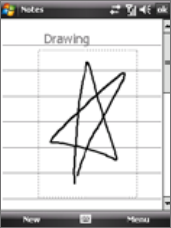
Organizing Contacts, Appointments, Tasks, and Other Information 107
Notes •
To select handwritten text, tap and hold next to the writing. As soon as
dots appear, and before they form a complete circle, quickly drag across
the writing.
• If a letter crosses three ruled lines, it is treated as a drawing rather than
text.
To draw in a note
1. Tap Start > Programs > Notes.
2. In the note list, tap New.
3. To draw on the screen, use the stylus like a pen.
Drawing on the screen
4. A selection box appears around your drawing.
5. When finished, tap OK to return to the note list.
Note To select a drawing (for example, to copy or delete it), tap and hold the
drawing briefly. When you lift the stylus, the drawing is selected.

108 Organizing Contacts, Appointments, Tasks, and Other Information
Record a voice note
You can create a stand-alone recording (voice note) or you can add a
recording to a note.
To create a voice note
1. Tap Start > Programs > Notes.
2. Do one of the following:
• To create a stand-alone recording, record from the note list.
• To add a recording to a note, create or open a note.
3. If you do not see the Recording toolbar, tap Menu > View Recording
Toolbar.
4. Tap the Record icon ( ) to begin recording.
5. Hold your device’s microphone near your mouth or other source of
sound.
6. Tap the Stop icon ( ) when finished recording.
7. If you are adding a recording to a note, tap OK to return to the note
list when finished.
8. If you are recording in an open note, an icon will appear in the note.
9. If you are creating a stand-alone recording, the recording will appear
in the note list.
To change recording formats
1. Tap Start > Settings > Personal tab > Input.
2. Tap the Options tab, and select the desired format you want in the
Voice recording format list.
3. Tap OK.
Note
You can also change recording formats from within Notes. In the note list, tap
Menu > Options > Global Input Options link (at the bottom of the page),
then tap the Options tab.

Chapter 7
Exchanging Messages
7.1 Messaging
7.2 Text Messages
7.3 MMS
7.4 Types of E-mail Accounts
7.5 E-mail Setup Wizard
7.6 Using E-mail
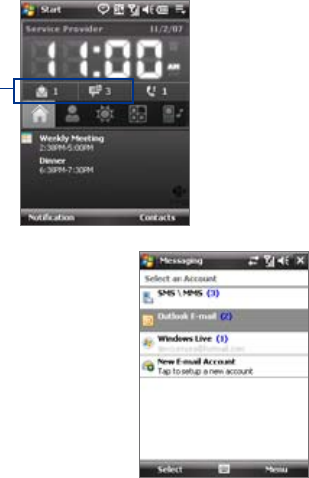
110 Exchanging Messages
7.1 Messaging
Messaging is where your text messages (SMS), multimedia messages
(MMS), and e-mails are located. When you receive new messages, you can
open them from the Today screen. Simply tap the type of message that you
want to open.
New messages
To select a messaging account
Do one of the following:
• Tap Start > Messaging. The
Account Picker screen then appears
where you can select an account.
• While you are in a message list of a
certain account, for example SMS \
MMS, tap Menu > Go To to switch to
other types of messaging accounts.
To configure message account settings
• Tap Menu > Options on the
Account Picker screen; or
• Tap Menu > Tools > Options while
you’re in a message list.
Account Picker screen
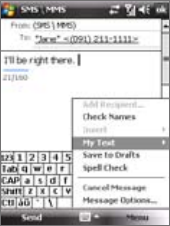
Exchanging Messages 111
7.2 Text Messages
Send short text messages (SMS) up to 160 characters long to other mobile
phones.
Send text messages
To compose and send a text message
1. Tap Start > Messaging > SMS \ MMS.
2. Tap Menu > New > SMS.
3.
Enter the mobile phone number of one
or more recipients, separating them with
a semicolon. To access mobile phone
numbers from Contacts, tap To.
4. Enter your message.
•
To quickly add common messages,
tap Menu > My Text and tap a
desired message.
• To check the spelling, tap Menu >
Spell Check.
5. Tap Send.
Tips • To enter symbols, tap Shift using the on-screen keyboard then tap a
symbol, or use the Symbol Pad. For more information about entering text
and symbols, see Chapter 2.
• If you want to know when a text message is received, before sending the
message that you are composing, tap Menu > Message Options then
select the Request message delivery notification check box.
To always receive a delivery notification, tap Menu > Tools > Options in
the text message list, tap SMS \ MMS, then select the Request delivery
notifications check box.
112 Exchanging Messages
Receive text messages
Text messages are automatically received when the phone function is
turned on. When the phone is turned off, text messages are held by
your wireless service provider until the next time the phone is turned on.
Copy text messages from and to the SIM card
1. Tap Start > Messaging > SMS \ MMS.
2. In the message list, select the text message you want to copy.
3. Do one of the following:
• To copy a text message to the SIM card, tap Menu > Copy to SIM.
• To copy a text message from the SIM card to your device, tap
Menu > Copy to Phone.
Note Text messages stored on your SIM card are automatically displayed in the
Inbox folder. Copying them to your device results in duplicate messages in
the Inbox folder when your SIM card is in use.
7.3 MMS
Sending MMS messages to your friends and family is fun and easy. You can
include pictures, video, and an audio clip in an MMS message.
Notes • Please note that MMS is a charged service and has to be provisioned on
your mobile account. Please contact your wireless service provider to have
MMS provisioned as part of your calling plan.
• Please make sure the size of MMS messages that you send is within the
limits allowed by your wireless service provider.
To access MMS messages on your device
Tap Start > Messaging > SMS \ MMS.
Change MMS settings
When you purchase your device, it is already preset with your wireless
service provider’s MMS settings. If you accidentally lost the preset settings
or you want to add another wireless service provider, you can configure the
settings while composing an MMS message.
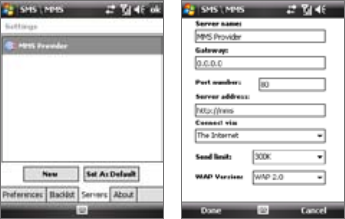
Exchanging Messages 113
To configure MMS settings
1. Tap Start > Messaging > SMS \ MMS.
2. Tap Menu > MMS Options. The Settings screen then appears.
3. In the Preferences tab, select or clear the provided check boxes
according to your needs. You can choose to download MMS messages
in both your home and roaming network, keep track of your MMS
messages, request a delivery or read receipt report, set the resolution
for images that you send, and more.
4. Tap the Servers tab and check if your device is preset with MMS
server settings.
If there are no preset settings, tap New and enter the following
information, which you can get from your other wireless service
provider:
• Server name. A descriptive name, such as your wireless service
provider name.
• Gateway. Location of the MMS server, which is usually in the form
of an IP address.
• Port number. HTTP port number used for connecting to the MMS
server and for file transfer.
• Server address. URL address of the server where MMS messages
are stored.
• Connect via. Select the connection that your device uses for MMS
messages.

114 Exchanging Messages
• Sending size limitation. Select the maximum MMS message size
allowed by your wireless service provider.
• WAP version. Select either WAP 1.2 or WAP 2.0, depending on
which one is being used by your other wireless service provider.
5. Tap OK.
Note • If your device already has preset MMS settings, it is recommended that
you do not change these settings. If you change the preset settings, your
device may not be able to send and receive MMS messages.
• If you add several MMS message service providers to the Settings screen,
you can choose one as your default provider. Select the provider's name
in the list then tap Set As Default.
Create and send MMS messages
You can compose MMS messages in a combination of slides, where each
slide can consist of a photo, video or audio clip, and/or text.
To compose an MMS message
1. Tap Start > Messaging > SMS \ MMS.
2. Tap Menu > New > MMS.
3. When you see the Choose a MMS screen, tap a preset template, or tap
Custom to open a blank MMS message.
Note If you prefer to always create a blank MMS message, select the Always
choose custom check box.
4. In To, enter the recipient’s phone number or e-mail address directly,
or tap To, Cc, or Bcc to choose a phone number or an e-mail address
from Contacts.
5. Enter a subject for your message.
6. Tap the Insert icon ( ) to select and insert a photo or video clip.
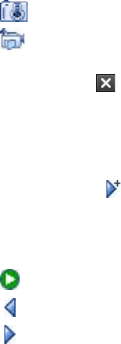
Exchanging Messages 115
When selecting a photo or video clip, you can:
• Tap Menu > View to view it first, then tap Select to insert the
selected photo or video clip into the MMS message you are
composing.
• Tap to take a photo and insert it into the MMS message.
• Tap to record an MMS video clip and insert it into the MMS
message.
• Tap the Exit icon ( ) to quit selection and return to the MMS
message.
7. Enter text and insert audio clips by tapping the respective areas. See
“To add text to an MMS message” and “To add an audio clip to an
MMS message” for details.
8. To add more slides, tap or tap Menu > Slides > Insert Slide. Repeat
steps 5 and 6 to insert a photo/video, text, and audio into each slide
that you added.
While on a slide, you can:
• Tap to preview the slide.
• Tap to go to the previous slide.
• Tap to go to the next slide.
9. While composing an MMS message, you can also do the following:
• Tap Menu > Options > Background to choose a background
color from the list.
• Tap Menu > Options > Text Layout, then choose whether to
place the text above, below, to the left or right of the photo/video.
• Tap Menu > Options > Send Options to specify the sending time,
expiration, priority, category, and other settings for a message.
• Tap Menu > Attachment to include a contacts card, calendar
appointment, or any file as an attachment.
10. Tap Send to send the MMS message.
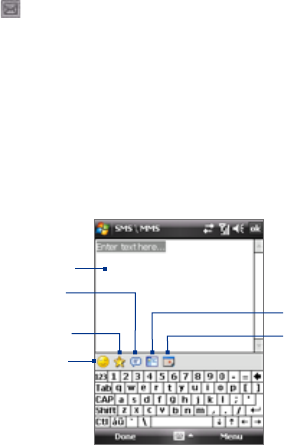
116 Exchanging Messages
Notes You can also send an MMS message directly from the Pictures & Videos or
Camera program. Do one of the following:
• In Pictures & Videos, select a picture from My Pictures, and tap Menu >
Send via MMS.
• Capture a photo or an MMS video clip using the camera, and tap the Send
icon ( ). In the Send File dialog box, tap Send via MMS.
To create an MMS message from a template
While on an MMS message, tap Menu > Template > Select a Template to
compose a message using a predefined template.
Note To save a message as a template, open the message and tap Menu >
Template > Save as Template.
To add text to an MMS message
When you tap Insert text here on your MMS message, an empty screen
appears where you can enter your text. You can insert the following types of
information:
Enter your own text
Choose from common words
or phrases from the My Text list
Include a Favorites link
Add an emoticon
Insert contact
information
Insert calendar
appointment
Tip To edit or delete a phrase on the My Text list, tap and hold a string, then tap
Edit or Delete from the shortcut menu. To create and add a new phrase to
the list, tap New.
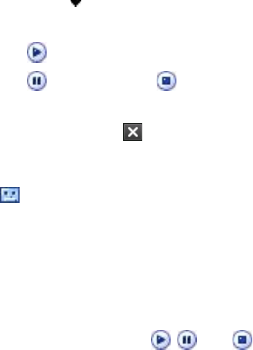
Exchanging Messages 117
To add an audio clip to an MMS message
You can add one audio clip per slide in your MMS message.
1. Tap Insert audio.
By default, My Documents will be shown. Tap My Music or another
folder that contains audio files. When navigating folders, tap the
Down arrow ( ) to return to the upper folder.
2. Select an audio file. When selected, you can:
• Tap to play the audio clip.
• Tap to pause, or tap to stop playback.
• Tap Select to insert it into your MMS message.
• Tap the Exit icon ( ) to quit selection and return to your MMS
message.
• To record a new audio clip and add it to your MMS message, tap
. The Record pop-up window then opens. Tap Record to start
recording, and Stop to end the recording. Tap Play to listen to
the recorded audio clip, then tap Add. The new audio clip is then
inserted into your MMS message.
View and reply MMS messages
To view an MMS message
• Use the playback controls , , and .
• Tap Contents to see a list of files included in the message. On the
Message Contents screen, you can do the following:
• To save a file, select it, and tap Menu > Save.
• To save the contents of a text file to the My Text list, tap Menu >
Save into My Text.
• To associate a photo to one of your contacts, tap Menu > Assign
to Contact.
To reply to an MMS message
Tap Menu > Reply to reply to the sender of the message, or tap Menu >
Reply All to reply to all persons listed in To, Cc, and Bcc of the message.
118 Exchanging Messages
To block a phone number from sending you MMS messages
If you do not want to receive MMS messages from a particular sender, you
can add the sender’s phone number to the MMS Blacklist.
1. When you receive a new MMS message, open and view the message.
2. To avoid receiving MMS messages from this sender next time, tap
Menu > Show > Message Detail.
3. On the MMS Detail screen, tap Menu > Show Contact Details.
4. Tap Menu > Save to Blacklist.
5. Tap Done.
Tip To view the numbers you have blacklisted, on the SMS \ MMS screen, tap
Menu > MMS Options > Blacklist tab.
To unblock a phone number and allow the sender to send you MMS
messages, remove the number from the Blacklist. Tap and hold the phone
number in the Blacklist then tap Delete.
7.4 Types of E-mail Accounts
Before you can send and receive e-mail, you need to set up your e-mail
account on your device. You can set up the following types of e-mail
accounts on your device:
• Outlook e-mail that you synchronize with your PC or your company’s
Exchange Server.
• E-mail account that you have from an Internet Service Provider (ISP).
• Web-based e-mail accounts such as Yahoo!® Mail, AOL®, etc.
• Work account that you access using a VPN connection.
Exchanging Messages 119
7.5 E-mail Setup Wizard
Windows Mobile’s E-mail Setup Wizard lets you easily set up your
personal and work e-mail accounts. You can add an e-mail account from an
Internet Service Provider (ISP) or other e-mail provider as well as Web-based
accounts such as Gmail®, Yahoo!® Mail Plus, AOL®, etc.
Note For more information about setting up your company Outlook e-mail
account, see Chapter 8.
Set up your device to synchronize Microsoft® Office
Outlook® e-mail with the computer
If you have installed the synchronization software on your PC and created a
partnership with your device, then your device is ready to send and receive
Outlook e-mail. If you have not yet installed the synchronization software
nor created a partnership, please do so by following the procedures in
Chapter 5.
Tip To set up your company e-mail account so that you can access Outlook
e-mail messages wirelessly, you must set up your device to synchronize via
a wireless LAN or over-the-air connection with your company’s Exchange
Server. For more information about synchronizing with your company e-mail
server, see Chapter 8.
Set up a POP3 or IMAP4 e-mail account
Set up a POP3 or IMAP4 e-mail account on your device if you have an e-mail
account from an Internet service provider (ISP) or other e-mail provider, or a
Web-based account such as Gmail, Yahoo! Mail Plus, etc. You can also add a
work account that you access using a VPN server connection as a POP3/
IMAP4 account.
1. Tap Start > Messaging > New E-mail Account.
2. Enter your e-mail address, and select the Try to get e-mail settings
automatically from the Internet check box. By selecting the option,
the device attempts to download e-mail server settings so that you
do not need to enter them manually. Tap Next.
3. After Auto Setup finishes, tap Next.
120 Exchanging Messages
Note If Auto Setup is unsuccessful, select Internet e-mail from the Your
e-mail provider list on the next screen. You will also be asked to enter
e-mail server settings during the setup process. See “To specify e-mail
server settings” for details.
4. Enter your name. You can also edit the Account display name field to
specify the name of your ISP or e-mail provider. Tap Next.
5. Enter your login name if it does not show automatically in the User
name field. Also enter your password, and select the Save password
check box. Tap Next.
6. At this point, e-mail setup is complete. In the Automatic Send/
Receive list, choose how frequent you want e-mail messages to be
automatically sent and downloaded on your device.
Note Tap Review all download settings to select download options, set the
e-mail format as HTML or plain text, and more. For more information,
see “To customize download and format settings."
7. Tap Finish.
To specify e-mail server settings
If Auto Setup is unsuccessful, contact your ISP or e-mail provider for the
Incoming mail server and outgoing mail server settings so you can enter
them on your device.
Other options that you can select include the following:
• Select the Outgoing server requires authentication check box, if
required by your provider.
• If the outgoing e-mail server requires a dierent user name and
password for sending e-mail, clear the Use the same user name and
password for sending e-mail check box. You will be prompted to
enter these information.
• Tap Advanced Server Settings, then select the Require SSL check
boxes if your e-mail provider uses an SSL connection for more secured
e-mail.
From the Network connection list, select the data connection that
you use for connecting to the Internet.

Exchanging Messages 121
To customize download and format settings
Before you tap Finish when setting up your POP3 or IMAP4 e-mail account,
you can tap Review all download settings to choose download options,
message format, and other settings.
Options Description
Automatic Send/Receive You can select a time interval for connecting to
the Internet automatically to send and receive
messages.
Download messages Set the number of days of messages that you
want to be downloaded to your device.
Send/receive when I click
Send
By default, messages are immediately delivered
when you tap Send. If you prefer to save
outgoing messages to the Outbox folder first,
clear the check box. (In this case, you will need
to manually send messages by tapping Menu >
Send/Receive).
Use automatic send/
receive schedule when
roaming
This allows your device to data roam when
there is a set time interval for connecting to the
Internet automatically. Since this may result in
higher connection costs, you may want to leave
the check box cleared.
When deleting messages Choose whether to delete messages from the
mail server when you delete them on your device.
Message format Select HTML or Plain Text.
Message download limit Select the e-mail download size. If you have large
volumes of e-mail, use a lower size or select to
download headers only.
122 Exchanging Messages
7.6 Using E-mail
After setting up e-mail accounts on your device, you can start sending and
receiving e-mail messages.
Create and send messages
To compose and send a message
1. Tap Start > Messaging or press the MESSAGING button on your
device, and then select an e-mail account.
2. Tap Menu > New.
3. Enter the e-mail address of one or more recipients, separating them
with a semicolon. To access e-mail addresses stored in Contacts,
tap To.
4. Enter a subject and compose your message. To quickly add common
messages, tap Menu > My Text and tap a desired message.
5. To check the spelling, tap Menu > Spell Check.
6. Tap Send.
Tips • To enter symbols, tap Shift using the on-screen keyboard then tap a
symbol, or use the Symbol Pad. For more information about entering text
and symbols, see Chapter 2.
• To set the priority, tap Menu > Message Options.
• If you are working offline, e-mail messages are moved to the Outbox
folder and will be sent the next time you connect.
To add an attachment to a message
1. In the message that you are composing, tap Menu > Insert and tap
the item you want to attach: Picture, Voice Note, or File.
2. Select the file you want to attach, or record a voice note.
Filter the Inbox message list
When the Inbox on your device is full of messages, it may be hard to browse
and locate a desired message. You can filter your Inbox to only display the
messages that contain a particular sender or subject you are searching for.
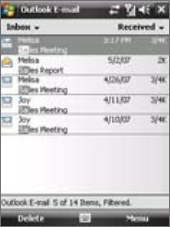
Exchanging Messages 123
To filter your Inbox
• Enter the sender’s name or
e-mail subject you want to
look for using the on-screen
keyboard. As you tap the keys,
the message list narrows down
to the conditions you have set.
For example, pressing “S” then
“A” narrows the list to only the
e-mails that contain sender
names and e-mail subjects that
start with “SA.”
View and reply to messages
To read an incoming message
By default, only the first few kilobytes of a message are shown when you
open an incoming message. To read the whole message, do one of the
following:
• Scroll down to the end of the message and tap Get the rest of this
message; or
• Tap Menu > Download Message.
The message will be downloaded the next time you tap Menu > Send/
Receive to send and receive e-mail.
Notes • If your company is running Microsoft Exchange Server 2007, the message
downloads immediately, without waiting until the next time you
synchronize. For more information about working with company e-mails,
see Chapter 8
• The size column in the message list displays the local size and server size
of a message. Even when an entire message has been downloaded, these
numbers may differ because the size of a message can vary between the
server and the device.
124 Exchanging Messages
To download an attachment
An attachment appears below the subject of the message. Tapping the
attachment opens the attachment if it has been fully downloaded or marks
it for download the next time you send and receive e-mail.
Notes • If there are multiple attachments in the message, all attachments are
downloaded.
• For information about setting your device to automatically download file
attachments, see "Customize e-mail settings".
• If your company is running Microsoft Exchange Server 2007, the
attachment downloads immediately, without waiting until the next time
you synchronize. For more information about working with company
e-mails, see Chapter 8.
To reply to or forward a message
1. Open the message and tap Menu > Reply, Menu > Reply All, or
Menu > Forward.
2. Enter your response. To quickly add common messages, tap Menu >
My Text and tap a desired message.
3. To check the spelling, tap Menu > Spell Check.
4. Tap Send.
Tips • To see more header information, scroll up.
• To always include the original message, from the list view, tap Menu >
Tools > Options > Message tab, and select the When replying to e-mail,
include body check box.
• In the Outlook E-mail account, you will send less data if you do not edit
the original message. This may reduce data transfer costs based on your
rate plan.
To view and reply to HTML e-mails
You can receive, view and reply to HTML e-mails from any type of e-mail
account. The HTML format is retained, without layout shifting or resizing.
Note HTML e-mail support in Outlook Mobile is available only if your company is
using Microsoft Exchange Server 2007.
1. Set the message format to HTML. To find out how to set the message
format, see “Customize e-mail settings”.
Exchanging Messages 125
2. Tap Start > Messaging, select your e-mail account, and open an
HTML e-mail that you received.
3. Tap the Tap to scroll right option to be able to scroll sideways and
get a complete horizontal view of the message.
4. Tap Get the rest of this message that’s shown at the bottom of the
message to download and view the whole message.
5. If the e-mail does not download immediately, tap Menu > Send/
Receive.
6. If images do not immediately appear on the message, tap Internet
pictures blocked then tap Download Internet pictures.
7. Tap Menu and choose whether to reply to the sender(s) or forward
the message.
8. Enter your response then tap Send.
Tip E-mail can contain hyperlinks to Web pages.
Download messages
The manner in which you download messages depends on the type of e-
mail account you have.
To send and receive e-mail for an Outlook account
1. Tap Start > Programs > ActiveSync.
2. Connect your device to your PC using the USB cable or Bluetooth.
Otherwise, connect wirelessly if you are synchronizing Outlook
e-mail with the Exchange Server. For more information, see Chapter 8.
3. Synchronization automatically begins, and your device sends and
receives Outlook e-mail.
Tip You can also manually synchronize anytime by tapping Sync in ActiveSync or
Menu > Send/Receive in Outlook Mobile.
126 Exchanging Messages
To send and receive e-mail for a POP3/IMAP4 account
If you have an e-mail account with an ISP or a work account that you access
using a VPN server connection, you send and receive messages through a
remote e-mail server. Before sending and downloading messages, you need
to connect to the Internet or your corporate network.
1. Tap Start > Messaging and tap your POP3 or IMAP4 e-mail account.
2. Tap Menu > Send/Receive. Messages on your device and e-mail
server are synchronized: new messages are downloaded to the device
Inbox folder, messages in the Outbox folder are sent, and messages
deleted from the server are removed from the device Inbox.
Customize e-mail settings
To change the download size and format for Outlook e-mail
1. Disconnect your device from the computer.
2. Tap Start > Programs > ActiveSync.
3. Tap Menu > Options, select E-mail, then tap Settings.
4. On the E-mail Sync Options screen:
• Under Download size limit, select the desired e-mail size.
• Under Message format, select HTML or Plain text.
5. Close ActiveSync and reconnect your device to the computer.
To change the download size and format for POP3/IMAP4 e-mail
1. Tap Menu > Options on the Account Picker screen, or tap Menu >
Tools > Options while you’re in a message list.
2. Tap your e-mail account.
3. Keep tapping Next until you see Message format and Message
download limit on the screen.
4. Change the options to your desired settings.
5. Tap Finish.
Exchanging Messages 127
To exclude your e-mail address when replying to all
When you reply to all the recipients of an Outlook e-mail, your own e-mail
address will also be added to the recipient list. Customize ActiveSync so that
your e-mail address will be excluded from the recipient list.
1. In ActiveSync on your device, tap Menu > Options.
2. Select the E-mail information type and tap Settings.
3. Tap Advanced.
4. In the My e-mail addresses text box, enter your e-mail address.
5. Tap OK.
To automatically receive attachments on Outlook e-mails
1. Tap Start > ActiveSync.
2. Tap Menu > Options.
3. Tap E-mail > Settings, then select Include file attachments.
To automatically receive attachments on IMAP4 e-mails
1. Tap Start > Messaging.
2. Tap Menu > Options.
3. Tap the name of your IMAP4 account.
4. Tap Next until you see Download attachments on the screen.
5. Select a download size from the Download attachments smaller
than list box.
6. Tap Finish.
To store attachments on a storage card
1. Tap Start > Messaging.
2. Tap Menu > Options > Storage tab.
3. Select the When available, use this storage card to store
attachments check box.
128 Exchanging Messages

Chapter 8
Working with Company E-mails
and Meeting Appointments
8.1 Synchronizing Your Device with
the Exchange Server
8.2 Working with Company E-mails
8.3 Managing Meeting Requests
8.4 Finding Contacts in the Company Directory
8.5 E-mail Security
130 Working With Company E-mails and Meeting Appointments
8.1 Synchronizing Your Device with the
Exchange Server
To keep up-to-date with your company e-mails and meeting schedules
while you’re out of the office, you can connect your device to the Internet
wirelessly and synchronize these information with your company’s
Exchange Server. You can also access your company address book anytime.
Your company must have a mail server that is running Microsoft Exchange
Server with Exchange ActiveSync.
Set up an Exchange Server connection
Before you can start to synchronize with or access information from the
Exchange Server, you need to set up an Exchange Server connection on
your device. You need to get the following information from your network
administrator and enter them on your device:
• Exchange Server name (must be the Outlook Web Access server
name)
• Domain name
• User name and password that you use at work
If you have not synchronized your device with your PC, follow these steps to
set up an Exchange Server connection.
1. Tap Start > Messaging > New E-mail Account.
2. Enter your e-mail address. Clear the Try to get e-mail settings
automatically from the Internet check box, then tap Next.
3. Select Exchange server in the Your e-mail provider list, then tap
Next.
4. Tap Next again.
5. In Server address, enter the Exchange Server name, and tap Next.
6. Enter your user name, password, and domain, and tap Next.
Tip To change the rules for resolving synchronization conflicts, tap
Advanced.
7. Select the check boxes for the types of information items that you
want to synchronize with the Exchange Server.
Working With Company E-mails and Meeting Appointments 131
8. To change synchronization settings of an information type, for
example, E-mail, select the type of information, and tap Settings.
9. Tap Finish.
Note If you synchronized e-mails with your PC before, open ActiveSync on
your device and tap Menu > Add Server Source to set up an Exchange
Server connection. When you're prompted to select information types for
synchronization, you need to clear the E-mail check box under the Windows
PC item first before you can select the E-mail check box under Exchange
Server.
Tip To change Exchange Server settings, open ActiveSync then tap Menu >
Configure Server.
Start synchronization
Before you start synchronizing with the Exchange Server, make sure your
device has been set up with a data connection to the Internet so that you
can synchronize wirelessly. For more information about connections, see
Chapter 10.
After you finish setting up an Exchange Server connection, your device
automatically starts synchronization.
You can manually start synchronization anytime by tapping Sync in
ActiveSync.
Note If you connect your device to your office computer via a USB or Bluetooth
connection, you can use this connection to the PC to “pass through” to the
network and download Outlook e-mails and other information to your
device.

132 Working With Company E-mails and Meeting Appointments
8.2 Working with Company E-mails
Your device gives you instant access to your company e-mails and lets
you manage your messages easier. Direct Push, Fetch Mail, Remote e-mail
search, and e-mail flags are just some of the tools you can use to manage
your e-mails.
Note Some messaging features depend on the Microsoft Exchange Server version
used in your company. Please check with your network administrator for the
availability of these features.
Automatic synchronization through Direct Push
Direct Push technology (push e-mail feature) enables you to receive new
e-mails on your device as soon as they arrive in your Inbox on the Exchange
Server. With this feature, items such as contacts, calendar and tasks are
also immediately updated onto your device when these items have been
changed or new entries have been added on the Exchange Server. To make
Direct Push work, you need to have a GPRS/3G connection on your device.
You need to perform a full synchronization between your device and the
Exchange Server first before Direct Push can be enabled.
Requirement The Direct Push feature works for your device only if your
company is using Microsoft Exchange Server 2003
Service Pack 2 (SP2) with Exchange ActiveSync or
higher version.
To enable Direct Push via Comm Manager
1. Tap Start > Programs > Comm Manager.
2. On the Comm Manager screen, tap the DirectPush button. The
button turns to , which indicates that you will
receive e-mails as they arrive.
When the button is in the state, you need to manually
retrieve your e-mails.
To enable Direct Push via ActiveSync
1. In ActiveSync on your device, tap Menu > Schedule.
2. Select As items arrive in the Peak times and Off-peak times boxes.
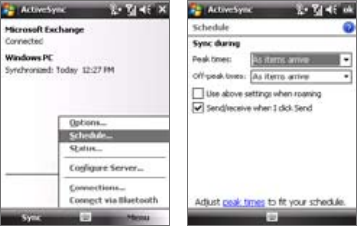
Working With Company E-mails and Meeting Appointments 133
Notes When both the GPRS and Wi-Fi connections are turned on at the same time,
the Direct Push feature will always opt for Wi-Fi.
Scheduled synchronization
If you do not want to use Direct Push, you can set a regular schedule
for synchronizing Outlook e-mail and information. Set how often to
synchronize during Peak times (which usually refer to your working hours)
when e-mail volume is high, as well as Off-peak times when e-mail volume
is low.
1. In ActiveSync on your device, tap Menu > Schedule.
2. Select a shorter time interval in the Peak times box for you to be able
to receive e-mails more frequently.
3. Select a longer interval in the Off-peak times box.
Tip To set the days and hours that make up your peak and off-peak times, tap
Adjust peak times to fit your schedule.
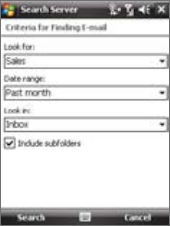
134 Working With Company E-mails and Meeting Appointments
Instant download through Fetch Mail
The Fetch Mail feature downloads an entire e-mail immediately without the
need for you to perform a full Send/Receive action. This limits the download
to just the e-mail message that you want and helps save data cost.
Requirement Fetch Mail works for your device only if your company is
using Microsoft Exchange Server 2007 or higher.
1. Tap Start > Messaging > Outlook E-mail.
2. Tap an e-mail message to open it.
3. By default, only the first few kilobytes of the message is shown. To
download the whole e-mail, scroll to the bottom of the message then
tap Get the rest of this message.
4. A “Downloading message” status appears. Wait for the remainder of
the message body to be downloaded.
Tip For information about changing e-mail sync options such as the initial
download size limit for e-mail, see "Customize e-mail settings" in Chapter 7.
Search for e-mails on the Exchange Server
You can access messages that are not available on your device by searching
your Microsoft Exchange Server mailbox. The search results will be
downloaded and displayed in a Search Results folder.
Requirement Your company must be using Microsoft Exchange Server
2007 or higher.
1. Tap Start > Messaging > Outlook
E-mail.
2. Tap Menu > Tools > Search Server.
3. In the Look for text box, enter the
search keyword.
4. Choose the date range of messages
to search from.
5. From the Look in list, choose
whether to search from your inbox or
outbox only or to search all folders.
6. Tap Search.
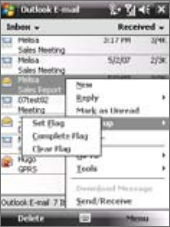
Working With Company E-mails and Meeting Appointments 135
Flag your messages
Flags serve as a reminder for you to follow-up on important issues or
requests that are indicated in the messages. Flagging messages, which
has been a useful feature on desktop Outlook E-mail, can also be done in
Outlook Mobile on your device. You can flag received messages on your
device.
Requirement Flags are enabled only if e-mails are synchronized with
Microsoft Exchange Server 2007 or higher. Flags are
disabled or hidden if e-mails are synchronized with earlier
versions of Microsoft Exchange Server.
To flag or unflag a message
1. Tap Start > Messaging > Outlook E-mail.
2. Select a message, or open a message.
3. Tap Menu > Follow Up and select one of the following options:
• Set Flag Mark the message with a red flag to indicate that it needs
follow up.
• Complete Flag Mark the message with a check mark to indicate
that the issue or request in the e-mail is already completed.
• Clear Flag Remove the flag to unmark the message.
Note E-mail message reminders are displayed on your device if the messages are
flagged with reminders and synchronized from the Exchange Server.
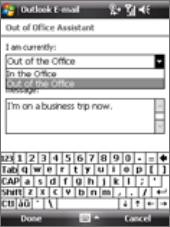
136 Working With Company E-mails and Meeting Appointments
Out-of-office auto-reply
Microsoft® Office Outlook® Mobile allows you to retrieve and change your
out-of-office status. Just like desktop Outlook E-mail, Outlook Mobile
automatically sends an auto-reply message when you’re not available.
To send out-of-office auto-reply messages
1. Tap Start > Messaging >
Outlook E-mail.
2. Tap Menu > Tools > Out of
Office.
3. From the I am currently list,
select Out of the Office.
4. Enter your auto-reply message
then tap Done.
View a document linked to an e-mail message
When you receive an e-mail that contains a link to a document such as a
PDF or Microsoft® Office document located on SharePoint or an internal file
server, you can view the document on your device.
Requirement You can view the document only if you have a Microsoft
Outlook account that synchronizes with Microsoft
Exchange Server 2007 or later. Exchange Server must also
be set up to allow access to SharePoint document libraries
or internal file servers.
1. On the Today screen, tap Start > Messaging.
2. Select an e-mail account, then open a message with a link to a
SharePoint document.
3. Tap the link to open and view the document.
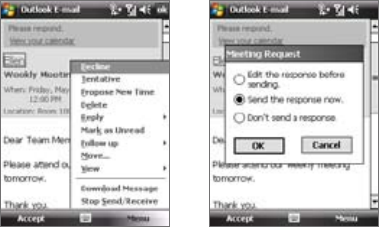
Working With Company E-mails and Meeting Appointments 137
8.3 Managing Meeting Requests
When you schedule and send meeting requests from your device, you can
invite attendees to your meeting and check their status to know about their
availability.
When you receive a meeting request, you can reply by accepting or
declining the request. The meeting request also clearly indicates whether or
not there are conflicting or adjacent meetings.
Requirement Your company must be using Microsoft Exchange Server
2007 or higher.
To reply to a meeting request
1. In Outlook Mobile, tap the meeting request e-mail to open it.
2. Tap Accept to reply and accept the meeting request, or tap Menu >
Decline if you cannot attend the meeting.
Tips • Before responding, you can check your availability during the time
of the requested meeting by tapping View your calendar.
• If the time of the meeting conflicts with your other appointments,
a “Scheduling Conflict” status appears on top of the e-mail.
3. Choose whether or not to edit your response e-mail before sending
then tap OK.
4. If you accepted the meeting request, it will automatically be added as
an appointment in Calendar on your device.
138 Working With Company E-mails and Meeting Appointments
To view the list of meeting participants
1. Tap Start > Calendar.
2. Tap a meeting request that you previously sent, then tap Attendees.
The list of required and optional attendees will be listed.
Notes • For information about creating a meeting request, see “To send a meeting
request” in Chapter 6.
• If you select a meeting that you have organized, the list shows who has
accepted or declined the meeting.
• To view an attendee’s contact information, tap the attendee’s name. If
the attendee is included in your contacts list, you will see the contact
information immediately. If the attendee is not in your contacts list, tap
Company Directory to view the contact information.
8.4 Finding Contacts in the Company Directory
In addition to having contacts on your device, you can access contact
information from your organization’s Company Directory. By having
over-the-air access to the Company Directory, you can easily send e-mail
messages and meeting requests to anyone in your company.
Requirement Access to the Company Directory is available only if
your organization is running Microsoft Exchange Server
2003 SP2 or higher, and you have completed your first
synchronization with the Exchange Server.
1. Synchronize with Exchange Server if you have never done so.
2. Do any of the following:
• In Contacts, tap Menu > Company Directory.
• In a new message, tap the To box (or tap Menu > Add Recipient)
and tap Company Directory.

Working With Company E-mails and Meeting Appointments 139
• In a new meeting request using Calendar, tap Attendees and then
tap Company Directory at the top of the list.
3. Enter the part or full contact name and tap Search. In the search
results list, tap a contact to select it.
Notes • You can save a contact from the Company Directory to your device by
selecting the contact then tapping Menu > Save to Contacts.
• You can search on the following information as long as that information is
included in the Company Directory: First name, Last name, E-mail name,
Display name, E-mail address, or Office location.
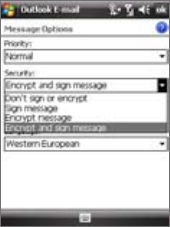
140 Working With Company E-mails and Meeting Appointments
8.5 E-mail Security
Windows Mobile® on your device protects your Outlook e-mails through
Secure/Multipurpose Internet Mail Extension (S/MIME), which allows you to
digitally sign and encrypt your messages.
Digitally signing a message applies your certificate with the authorization
key to the message. This proves to the recipient that the message is from
you and not from an imposter or a hacker, and that the message has not
been altered.
Encryption protects the privacy of your message by converting it from
plain, readable text into cipher (scrambled) text. Only the recipient who has
the authorization key can decipher the message.
Requirement S/MIME encryption and digital signatures for Windows
Mobile® powered devices are available only with Exchange
Server 2003 SP2 or a later version that supports S/MIME. If
you are not using one of these products, or have not yet
synchronized, these options are unavailable.
Note You can encrypt a message with or without a certificate. However, to read an
encrypted message, you need a valid certificate to decrypt it.
To individually sign and encrypt a new message
1. Tap Start > Messaging >
Outlook E-mail.
2. Tap Menu > New to create a new
message.
3. Tap Menu > Message Options.
4. From the Security list, select
whether to encrypt only, sign the
message only, or do both.
5. Tap OK.
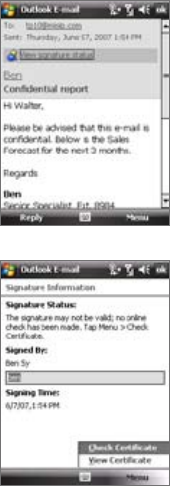
Working With Company E-mails and Meeting Appointments 141
To verify the digital signature on a signed message you receive
1. Open the Outlook e-mail message that has been digitally signed.
2. At the top of the message, tap View Signature Status.
3. Tap Menu > Check Certificate.
To view the details of the certificate in the message, tap Menu > View
Certificate.
Note There can be several reasons why a digital signature is not valid. For example,
the sender’s certificate may have expired, it may have been revoked by the
certificate authority, or the server that verifies the certificate is unavailable.
Contact the sender to report the problem.
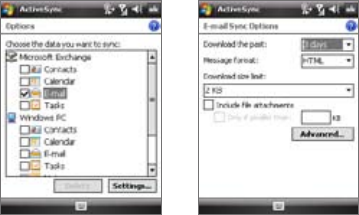
142 Working With Company E-mails and Meeting Appointments
To digitally sign and encrypt all messages
You can set up ActiveSync to digitally sign and encrypt all outgoing
messages. You must obtain a valid certificate to sign and encrypt e-mail
messages successfully.
1. Tap Start > Programs > ActiveSync.
2. Tap Menu > Options.
3. Select the E-mail information type, and tap Settings. On the E-mail
Sync Options screen, tap Advanced.
4. Do one or both of the following:
• To sign all your outgoing e-mail messages so that recipients can
be certain that the messages were sent by you and have not been
altered in any way, select the Sign all outgoing e-mail messages
check box.
• To encrypt all your outgoing e-mail messages so that the
contents of your messages are protected from being viewed by
anyone other than the intended recipients, select the Encrypt all
outgoing e-mail messages check box.
5. Tap Choose Certificate to select a certificate for signing or
encrypting outgoing e-mail messages.
Working With Company E-mails and Meeting Appointments 143
Set permissions on an e-mail message
Another way of protecting your e-mail messages is to send messages with
restricted permissions using Information Rights Management (IRM).
Requirement This works only with a Microsoft Outlook e-mail account
and if your company is using RMS Server SP1.
1. Tap Start > Messaging > Outlook E-mail.
2. Create a message, then tap Menu > Message Options.
3. In Permissions, do one of the following:
• To allow anyone to read the message, select Unrestricted access.
• To prevent the message from being forwarded, printed, or copied,
select Do not forward.
4. Tap OK.
Tip An IRM-protected message received on your device can only be replied to or
forwarded if the message permits it.
144 Working With Company E-mails and Meeting Appointments

Chapter 9
Working with Documents
and Files
9.1 Microsoft® Office Mobile
9.2 Adobe® Reader® LE
9.3 Copying and Managing Files
9.4 ZIP
9.5 Backing Up Data
146 Working With Documents and Files
9.1 Microsoft® Office Mobile
Office Mobile consists of three applications that let you create, edit and
view Microsoft documents. These three applications are:
• Microsoft® Office Word Mobile is a streamlined version of Microsoft
Word. Word documents created on your PC can be opened and
edited on your device. You can also create and edit documents and
templates in Word Mobile and save them as *.docx, *.dotx, *.rtf, and
*.txt files.
• Microsoft® Office Excel® Mobile makes it easy for you to open and
edit Excel workbooks and templates created on your PC. You can also
create new workbooks and templates in Excel Mobile and save them
as *.xlsx and *.xltx files.
• Microsoft® Office PowerPoint® Mobile lets you open and view (not
create) slide show presentations, *.ppt and *.pps formats, created on
your PC.
To open a Office Mobile program
Tap Start > Office Mobile and then select the Office Mobile program you
want to open.
Notes • Word Mobile does not fully support some features of Microsoft Word such
as revision marks and password protection. Some data and formatting
may be lost when you save the document on your device. To see a
complete list of features that are not supported in Word Mobile, see Help
on your device.
• Excel Mobile does not fully support some features such as formulas and
cell comments. Some data and formatting may be lost when you save the
workbook on your device. To see a complete list of features that are not
supported in Excel Mobile, see Help on your device.

Working With Documents and Files 147
9.2 Adobe® Reader® LE
Adobe® Reader® LE is an application for viewing PDF (Portable Document
Format) documents on your device. It supports a subset of the features
found in the PC versions of Adobe Reader.
To open Adobe Reader LE
Tap Start > Programs > Adobe Reader LE.
To open a PDF file on your device
Open File Explorer and find the desired PDF file, then tap the file to open it.
To navigate through a PDF document
When you are viewing a PDF document, you can do any of the following:
• Use the vertical and horizontal scroll bars (including the Up, Down,
Right and Left arrow keys on the bars) to move to the desired
direction of the page.
• Press NAVIGATION up/down/right/left to move to the desired
direction of the page.
• Tap to move to the previous page; tap to move to the next page.
Tap to jump to the first page; tap to jump to the last page.
• Tap Tools > Go To to select the desired page to view.
To search for text in the document
1. Tap Tools > Find > Text or tap on the toolbar.
2. Type in the text to be searched, then tap Find.
3. The matched text in the document will be highlighted.
4. To search for the next occurrence of the text, tap Tools > Find > Next.
To exit Adobe Reader LE
Tap Menu > Exit.
Tips • Adobe Reader LE displays a bookmark pane for the PDF files that contain
bookmarks. Tap the bookmarks to go to a specific section/page within the
file.
• Adobe Reader LE supports password-protected PDF files with up to 128-
bit encryption. When you open a password-protected PDF file, you will be
prompted to enter the password before the file can be opened.
148 Working With Documents and Files
9.3 Copying and Managing Files
You can copy files between your device and PC, or copy files to a storage
card that is inserted on your device. You can also efficiently manage your
files and folders using File Explorer.
Copy files using Windows Mobile® Device Center or
ActiveSync
Using Windows Mobile® Device Center or ActiveSync, you can copy files
from your PC to your device and vice versa.
To copy a file between your device and the PC
1. Connect your device to the PC.
2. Click File Management > Browse the contents of your device in
Windows Mobile Device Center or click Explore in ActiveSync on
your PC. This opens Windows Explorer on your PC and displays the
contents of your device.
3. To copy a file from your device to your PC:
a. In Windows Explorer on your PC, browse your device and navigate
to the file that you want to copy.
b. Right-click the file, then click Copy.
c. Locate the destination folder on your PC. Right-click the folder,
then click Paste.
4. To copy a file from your PC to your device:
a. On your PC, navigate to the folder that contains the file you want
to copy.
b. Right-click the file, then click Copy.
c. Right-click the destination folder on your device, then click Paste.
Copying a file results in separate versions of a file on your device and PC.
Because the files are not synchronized, changes made to one file will not
affect the other. If you want file changes to be automatically updated on
your device and PC, you can synchronize files between your device and PC.
For more information about synchronizing with a computer, see Chapter 5.

Working With Documents and Files 149
Use File Explorer
File Explorer lets you browse the contents of folders on your device. The
root folder on the device is named My Device. My Device is similar to My
Computer on the PC and contains the My Documents, Program Files, Temp,
Storage Card, and Windows folders, among others.
To use File Explorer
1. Tap Start > Programs > File Explorer.
2. Tap a folder or file to open it.
3. To return to an upper level folder, tap the Down arrow ( ) and select
the folder.
4. To delete, rename, or copy a file quickly, tap and hold the file then
choose the desired operation from the shortcut menu. To select
multiple files, tap and drag over the desired files.
Store files to a storage card
To copy files to a storage card
1. Make sure the storage card is properly inserted into your device.
2. Tap Start > Programs > File Explorer and navigate to the
appropriate folder.
3. Tap and hold the file you want to copy, and tap Copy.
4. Tap the Down arrow ( ) then tap Storage Card from the list.
5. Tap Menu > Edit > Paste.
To automatically save files on a storage card
In the Word Mobile, Excel Mobile, and Notes programs, you may find it
helpful to save all new documents, notes, and workbooks directly on a
storage card.
1. From the program file list, tap Menu > Options.
2. With a storage card inserted in your device, in the Save to box, select
the appropriate storage card to automatically save new files on the
storage card.
3. Tap OK.
Note In the file or note list, a storage card symbol ( ) is displayed next to the
names of files saved on a storage card.
150 Working With Documents and Files
9.4 ZIP
ZIP allows you to save memory and increase the storage capacity of your
device by compressing files in the conventional ZIP format. You can view
and extract archive files received from various sources. You can also create
new *.zip files on your device.
Start ZIP and Open .zip files
You can use ZIP to either archive files or open an existing archive file on
your device. Each time you start ZIP on your device, it searches for files
that have the .zip file extension, and displays these files on the Archive List
screen.
To start ZIP on your device
Tap Start > Programs > ZIP.
To open a ZIP file and extract files
1. Open a file using any of the following:
• Select a file and tap File > Open Archive.
• Tap and hold a file and tap Open Archive.
• Double-tap a file.
Note You cannot select multiple ZIP files.
2. The files contained in the zip file are then displayed. Select files by
doing one of the following:
• Tap to select a file.
• To select several files, tap Menu > Action and make sure Multi-
Select Mode is selected. Select files by tapping each file. (Tap a
selected file to deselect it).
• To select all files, tap Menu > Action > Select All.
3. Tap Menu > Action > Extract.
4. Choose a folder in which files will be extracted to, then tap Extract.
Working With Documents and Files 151
To create a zip archive
1. Tap File > New Archive.
2. On the Save As screen, enter a zip file name and choose a folder in
which to save the zip file. You can also choose whether the zip file will
be saved on the device’s main memory or a storage card.
3. Tap Save.
4. Tap Menu > Action > Add.
5. Double-tap the folder that contains the files you want to archive.
6. Select files by doing one of the following:
• Tap to select a file.
• To select several files, tap and hold on the screen, then select
Multi-Select Mode. Select files by tapping each file. (Tap a
selected file to deselect it).
• To select all files, tap and hold on the screen, then tap Select All.
7. Tap Add.
8. Tap Menu > File > Close Archive.
9. After closing the zip file, you can tap Find to search for all zip files and
display them on the Archive List screen.
9.5 Backing Up Data
Use Sprite Backup to back up data, which includes settings, files, contacts,
and all other information, to a storage card or to a designated folder on
your device.
This section describes the basics on how to install Sprite Backup and use it
to back up and restore data on your device. For more information about this
program, see Help on your device.
To install Sprite Backup
1. Make sure your device is connected to your computer via a USB cable.
2. Install Sprite Backup on your device from the PC using the
Applications Disc. Follow the on-screen instructions on your
computer to complete the installation.
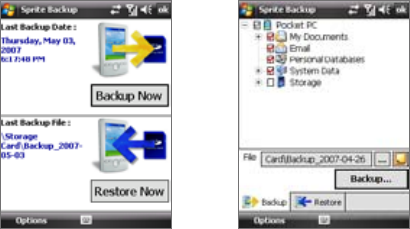
152 Working With Documents and Files
3. After the installation is completed, the Setup Wizard on your
computer will set up Sprite Backup on your device. Follow the on-
screen instructions to complete the setup.
To open Sprite Backup
On your device, tap Start > Programs > Sprite Backup.
Sprite Backup can operate in two different modes: Basic mode and
Advanced mode. The first time you run Sprite Backup, it will be in Basic
Mode. To switch between the modes, tap Options then select the desired
mode.
Basic mode Advanced mode
Basic mode
Basic mode is the default mode, and allows you to easily back up your entire
PDA phone with the tap of a button.
Note To change backup options or location, you will need to do it in Advanced
mode.
To back up data in Basic mode
1. On the Basic mode screen, tap Backup Now.
2. Specify a password (between 6 to 15 characters in length) for the
backup file. Enter this password twice, then tap OK.
3. Follow the on-screen instructions to complete the backup.

Working With Documents and Files 153
To restore data in Basic mode
1. On the Basic mode screen, tap Restore Now.
2. Enter the password for the backup file, then tap OK.
3. Follow the on-screen instructions to complete the restoration process.
Advanced mode
Advanced mode is designed for users with more advanced backup
requirements. It provides a tree view of the data on your device from which
you can select what items you want to back up or restore.
To back up data in Advanced mode
1. Tap Options > Switch to Advanced Mode.
2. The Backup tab of the Advanced mode screen shows a tree view of
the data and files on your device. Tap the ‘+’ symbol at the left of an
item to view its sub-items. Use the check boxes to select or exclude
items for backup.
3. Tap Backup and follow the on-screen instructions to complete the
backup.
To restore data in Advanced mode
1. On the Advanced mode screen, tap the Restore tab.
2. If there is a most recent backup file, this file will be displayed with its
contents. Otherwise, if you want to use an older backup file, tap
then select the desired file.
If the backup file is password protected, the password must be
entered before the backup file can be displayed in the tree view.
3. In the tree view, select the check boxes of items you want to be
restored.
4. Tap the Restore button and follow the on-screen instructions to
restore.
Note In both the Basic and Advanced modes, Sprite Backup soft resets your device
first before it begins the backup or restoration process. It soft resets again
after the operation is completed.

154 Working With Documents and Files
Backup options
To change the backup location and file name
1. On the Advanced mode screen, tap the Backup tab.
2. Tap then enter the backup file name and choose whether to save
the file to the Storage Card or the My Documents folder on your
device.
3. Tap OK.
To disable automatic file naming
1. Tap Options > Backup Options > General Backup Options.
2. Clear the Name Backup Files Automatically check box, then tap OK.
3. Before you perform a backup, tap then specify a backup file name.
To schedule automatic backups
1. Tap Options > Scheduled Backup, then tap Change Scheduling.
2. Select the Enable Scheduled Backup check box, and set the
frequency of backups to perform, date and time, and other options.
3. Tap OK.
To enable remote backups to the computer via ActiveSync
1. Tap Options > Networking.
2. Select the Enable Remote Backup check box.
3. Select Via ActiveSync, then tap OK.
4. Tap then in the Location list, select PC and tap OK.

Chapter 10
Getting Connected
10.1 Comm Manager
10.2 Connection Setup
10.3 Ways of Connecting to the Internet
10.4 Wi-Fi
10.5 GPRS/3G
10.6 Dial-up and Other Connections
10.7 Starting a Data Connection
10.8 Internet Explorer® Mobile
10.9 Windows Live™
10.10
Using Your Device as a Modem
(Internet Sharing)
10.11 Bluetooth
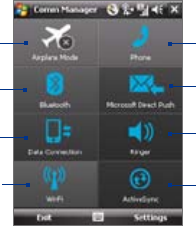
156 Getting Connected
10.1 Comm Manager
Comm Manager acts like a central switch that lets you enable or disable
phone features as well as manage your data connections easily.
To open Comm Manager
Tap Start > Programs > Comm Manager.
1
7
6
5
3
2
8
4
1Tap to switch Airplane mode on or off. Turning on Airplane mode turns off the
phone and Bluetooth functions. For more information, see “Airplane Mode” in
Chapter 3.
2Tap to toggle between turning on or off Bluetooth. Tap Settings > Bluetooth to
configure Bluetooth on your device. See "Bluetooth" in this chapter for details.
3Tap to disconnect active data connections (e.g. 3G or GPRS). You cannot reconnect
a data connection in Comm Manager.
4Tap to toggle between turning on or off Wi-Fi. Tap Settings > Wireless LAN to
configure Wi-Fi on your device. See "Wi-Fi" in this chapter for details.
5Tap to toggle between enabling or disabling the phone. Tap Settings > Phone to
set the ring tone and other phone settings. See Chapter 4 for details.
6Tap to toggle between automatically receiving (as items arrive) or manually
retrieving Outlook e-mails. See Chapter 8 for details.
7Tap to toggle between turning on the phone's ringer or setting the phone to
vibration/mute mode.
8Tap to open ActiveSync so you can synchronize the device and computer. See
Chapter 5 for details.
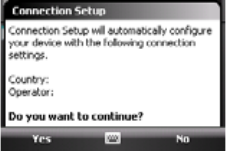
Getting Connected 157
10.2 Connection Setup
Connection Setup configures your device’s data connections, such as
GPRS, WAP, and MMS, for you so that you do not need to enter the settings
manually onto your device. All you need to do is to select your network
operator, then Connection Setup does all the configuration for you.
To automatically detect the network operator
The first time you power on your device, or when you insert a new SIM card
and then power on your device, Connection Setup will display a notification
message to inform you that it will automatically configure your device.
1. Tap Yes on the notification message.
2. If your SIM card supports multiple network operator profiles, the next
message that appears will display network profile choices. Select the
profile you want to use and tap OK.
3. Next, you will be asked if you want to automatically configure your
device to the proper network settings. Tap Yes.
Connection Setup then starts to configure your device’s data
connection settings.
4. After the Connection Setup completes the configuration, tap Restart.
To manually select the network operator
You can also manually select your network operator from Connection
Setup’s settings screen. Connection Setup will then reconfigure your
device’s data connections settings based on the operator that you selected.
1. Tap Start > Settings > Connections tab > Connection Setup.
2.
Select the network Country and Operator you want to use and tap OK
.
158 Getting Connected
Note If you choose a Country and/or Operator that is different from the
installed SIM card network operator, you may not be able to access
network services.
3. The next message that appears prompts you to confirm whether you
want to configure the data connection settings based on the selected
network. Tap Yes.
Connection Setup then starts to configure the data connection settings
.
4. After the Connection Setup completes the configuration, tap Restart.
10.3 Ways of Connecting to the Internet
Your device’s networking capabilities allow you to access the Internet
or your corporate network at work through wireless and conventional
connections. You can connect to the Internet through one of the following
connections:
• Wi-Fi
• GPRS, EDGE, or 3G
• Dial-up
• Work connections, such as Virtual Private Network (VPN) and proxy
connections
10.4 Wi-Fi
Wi-Fi provides wireless Internet access over distances of up to 300 feet (100
meters). To use Wi-Fi on your device, you need access to a wireless access
point or “hotspot”.
Note The availability and range of your device’s Wi-Fi signal depends on the
number, infrastructure, and other objects through which the signal passes.
Turn Wi-Fi on and off
1. Open the Comm Manager.
2. Tap the Wi-Fi button to turn on/o the wireless function. The WLAN
icon indicates the wireless status.
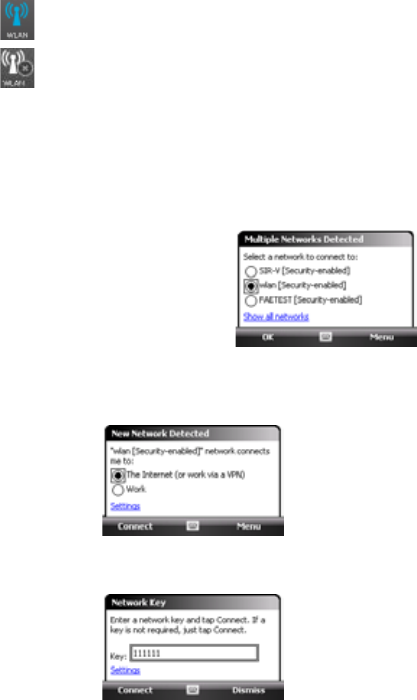
Getting Connected 159
: Wi-Fi is turned on.
: Wi-Fi is turned o.
3. Available wireless networks will be detected.
Connect to wireless networks
After Wi-Fi is turned on in Comm Manager, your device scans for available
wireless networks in your area.
To connect to a wireless network
1. The network names of the
detected wireless networks
will be displayed on a pop-
up message window. Tap the
desired wireless network, then
tap OK.
2. On the next pop-up message window, tap The Internet if the wireless
network connects your device to the Internet. Otherwise, tap Work if
the wireless network connects your device to a private network.
3. If the wireless network is secured by a network key, enter this key,
then tap Connect.
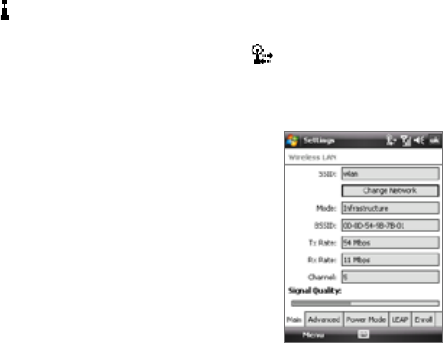
160 Getting Connected
Next time you use your device to detect wireless networks, you will not see
the pop-up message windows again, and you will not be prompted to enter
the network key of the previously accessed wireless network (unless you
perform a hard reset which will erase custom settings on your device).
Note Wi-Fi networks are self-discoverable, which means no additional steps are
required for your device to connect to a Wi-Fi network. It may be necessary
to provide a username and password for certain closed wireless networks.
To check wireless network status
You can check the current wireless connection status from any of the
following screens of your device:
• Title bar.
When you enable Wi-Fi on your device, the Wi-Fi ON icon
( ) will appear on the title bar.
After Wi-Fi is turned on, your device scans for available wireless
networks and the wireless signal icon ( ) appears on the title bar.
The arrows in this icon will move back and forth while your device is
scanning for a wireless network signal. Once your device successfully
connects to a wireless network, the arrows stop moving.
• Wi-Fi Status screen.
Tap Start > Settings > Connections
tab > Wireless LAN > Main tab
to see the name of the wireless
network that your device is currently
connected to.
The configuration and signal quality
of the wireless network are also
shown.

Getting Connected 161
• Configure Wireless Networks
screen.
Tap Start > Settings > Connections
tab > Wi-Fi > Wireless tab. This
screen displays the wireless networks
currently available.
To connect to a wireless network in
the list, tap and hold on the desired
network, then tap Connect.
Tap a wireless network in the list
to view or change its connection
settings.
You can also add new wireless
networks, if available, by tapping Add
New.
To save battery power while connected to a wireless network
Using Wi-Fi consumes battery power fast. Turn off Wi-Fi when not in use. You
can also enable power saving settings.
1. Tap Start > Settings > Connections
tab > Wireless LAN.
2. On the Power Mode tab, move the
Power Save Mode slider to a position
that optimizes performance with the
least power consumption.
For example, move the slider to
the left (Best Performance) to
have the optimal wireless network
performance; move to the right (Best
Battery) to obtain the maximum
battery usage.
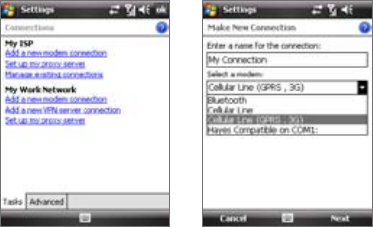
162 Getting Connected
10.5 GPRS/3G
Use GPRS/3G (or EDGE, if available) to connect to the Internet and to send
and receive MMS messages on your device. You will need a data plan to use
your wireless service provider’s GPRS/3G network. Check with your wireless
service provider to find out about GPRS/3G rates.
GPRS/3G settings are already preconfigured on your device, and your device
is ready to use your wireless service provider’s GPRS/3G services. Do not
change the settings as this may cause services to stop working..
To add a new GPRS/3G connection
In times when you need to add another GPRS/3G connection on your
device, obtain the Access point name from your wireless service provider.
Also, check if a user name and password are required.
1. Tap Start > Settings > Connections tab > Connections.
2. Under My ISP, tap Add a new modem connection.
3. On the Make New Connection screen, enter a name for the
connection.
4. In the Select a modem list, select Cellular Line (GPRS , 3G), then tap
Next.
5. Enter the Access point name, then tap Next.
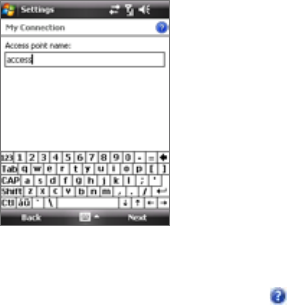
Getting Connected 163
6. Enter the user name and password, only if required.
7. Tap Finish.
Notes • To view help information for any screen, tap the help icon ( ).
• To modify your connection settings, tap Manage existing connections
on the Connections screen, and complete the connection wizard.
10.6 Dial-up and Other Connections
Dial-up
When you use your device to dial up to your Internet Service Provider (ISP)
and connect to the Internet, you will be billed by the number of minutes
that you use.
To set up a dial-up connection to your ISP
To establish a dial-up connection on your device, you need the same
settings that you normally use when you dial up from your computer. This
includes the ISP server phone number, your user name and password.
1. Tap Start > Settings > Connections tab > Connections.
2. Under My ISP, tap Add a new modem connection.
3. On the Make New Connection screen, enter a name for the
connection.
4. In the Select a modem list, select Cellular Line, then tap Next.
164 Getting Connected
5. Enter the ISP server phone number, then tap Next.
6. Enter your user name, password, and any other information required
by your ISP.
7. Tap Finish.
Work network connections
A Virtual Private Network (VPN) connection allows you to access your
company network through your device’s Internet connection. Whereas a
proxy connection lets you access the Internet using an existing connection
to your corporate or WAP network.
To set up work network connections
1. Obtain the following information from your network administrator:
• Server phone number
• User name
• Password
• Domain (and other required settings, such as IP address)
2. Tap Start > Settings > Connections tab > Connections.
3. In My Work Network, follow the instructions for each type of
connection.
4. Complete the connection wizard, then tap Finish.
10.7 Starting a Data Connection
After setting up a data connection such as GPRS or ISP dial-up on your
device, you can now connect your device to the Internet. The connection
is started automatically when you begin using a program that accesses the
Internet such as Internet Explorer® Mobile.
To manually start a data connection
If you have set up multiple types of data connections on your device, you
can manually start a connection.
1. Tap Start > Settings > Connections tab > Connections.
2. Tap Manage existing connections.
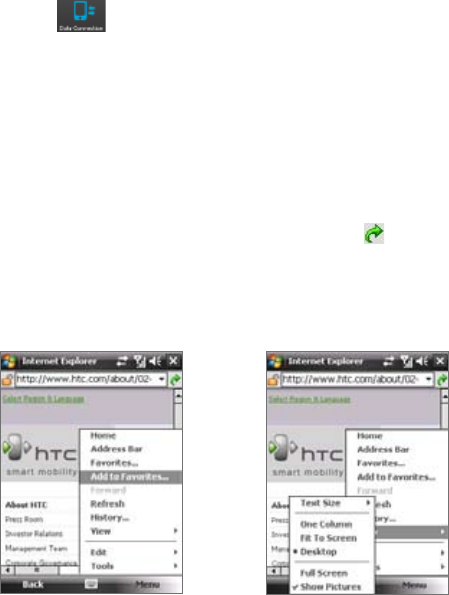
Getting Connected 165
3. Tap and hold the name of the desired connection, then tap Connect.
To disconnect active data connections
Tap Start > Programs > Comm Manager, then tap the Data Connection
button ( ).
10.8 Internet Explorer® Mobile
Internet Explorer Mobile is a full-featured Internet browser, optimized for
use on your device.
To open Internet Explorer
• On the Today screen, tap Start > Internet Explorer.
• Press the INTERNET EXPLORER button on your device.
To go to a Web site
Enter the Web site address in the Address Bar, then tap .
Internet Explorer® menu
While browsing the Web, tap Menu to choose from a list of options, such as
saving Favorites, changing the viewing size, and more. You can also tap and
hold on a Web page to choose options from the shortcut menu.
Tap Menu > Add to Favorites to save
the current Web page in your Favorites
folder.
Tap Menu > View to select the text
size and type of view.
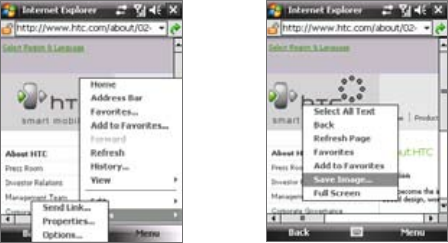
166 Getting Connected
Tap Menu > Tools and choose to send
the current Web page link, view the
page’s properties, or set preferences.
To save an image from a Web
page to your device, tap and hold
the image then tap Save Image.
For more information about Internet Explorer Mobile, go to
http://www.microsoft.com/windowsmobile/help/pocketpc/browseinternet.
mspx
10.9 Windows Live™
Windows Live™ gives you full Internet experience on your device. It helps
you to find information, pursue your interests, and get in touch with friends
and family on the Internet easier.
Windows Live™ offers the following key features:
• Live Search Bar, which lets you search for information on the Web.
• Live Messenger, the next generation of MSN Messenger Mobile.
• Live Mail, the next generation of Hotmail.
• Live Contacts, your address book for storing Live Mail, Live
Messenger and Hotmail contacts.

Getting Connected 167
Set up Windows Live™
The first time you use Windows Live™, sign in by using your Windows Live
ID, which is your Windows Live Mail or Hotmail address, and password.
To set up Windows Live for the first time
1. Tap Start > Programs > Windows Live.
2. Tap Sign in to Windows Live.
3. On the next screen, tap the links to read
the Windows Live™ Term of Use and
the Microsoft Privacy Statement. After
reviewing them, tap Accept.
4. Enter your Windows Live™ Mail or
Hotmail address and password, select
the Save password checkbox, then tap
Next.
5. Choose whether or not to show Windows Live™’s search bar and
applications on the Today screen then tap Next.
6. Choose what information you want to sync online with your device.
If you select Store Windows Live
contacts in your mobile phone’s
contact list, your Windows Live
contacts will be added to the contact
list and to Live Messenger on your
device.
If you select Sync e-mail, your Windows
Live Mail or Hotmail inbox messages
will be downloaded to your device..
7. Tap Next.
8. After synchronization is complete, tap
Done.
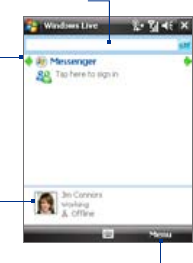
168 Getting Connected
The Windows Live interface
On the main interface of Windows Live, you will see a search bar, navigation
bar, and an area where you can customize to show your picture.
1This is the Live Search Bar.
2Tap the Left or Right arrow to switch
between Windows Live Messenger,
Live Mail, and Sync status.
3Tap to access Windows Live
Messenger settings.
4Tap Menu to access and change
settings.
1
2
3
4
Tip If you chose to display the search bar and Windows Live applications on the
Today screen when you were setting up Windows Live, you’ll also see them
on the Today screen: To show or hide them from the Today screen, open
Windows Live and tap Menu > Options > Today screen options.
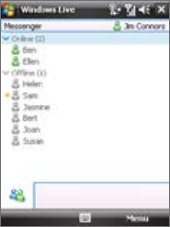
Getting Connected 169
Windows Live Messenger
With this mobile version of Windows Live Messenger, you enjoy many of
the same cool features that you get from the desktop version, which include
the following:
• Instant messaging via text and voice
• Multiple conversations
• Add emoticons
• Contact list with presence
• Send and receive files including photos
• Change status/display name
• View contacts by online status, groups,
and more
• Send messages even when a contact is
oine
Note Before you can use Windows Live Messenger Mobile, your device must be
connected to the Internet. For information about setting up an Internet
connection, see “Ways of Connecting to the Internet” in this chapter.
Launch the messenger and sign in
To open Windows Live Messenger Mobile
• Tap Start > Programs > Messenger; or
• On Windows Live™ or the Today screen, tap the Left or Right arrow
until you see Messenger, then tap it.
To sign in and out
1. Tap Sign in on the messenger screen.
2. If this is your first time to sign in, a message appears to inform you
that your messenger contacts will be added to the contact list on your
device. Tap OK to add them.
Signing in may take several minutes, depending on your connection
speed.
3. To sign out, tap Menu > Sign Out.
170 Getting Connected
To start and end conversations
1. In the contact list, select a contact then tap Send IM to open a
message screen.
2. Enter your text message in the text entry area of the message screen.
3. To add an emoticon, tap Menu > Add emoticon then tap an icon
from the list of emoticons.
4. Tap Send.
5. To end a conversation with the current contact, tap Menu > End
conversation.
Tips • To send a file, tap Menu > Send. You can choose to send a picture, voice
clip or any file.
• To invite one or more contacts to the conversation, tap Menu > Options >
Add participant.
• To send a voice message, tap Voice Clip on a message screen then start
talking. After you have spoken a message, tap Send.
Add Windows Live contacts
You can add new Windows Live contacts in Live Messenger or in Contacts.
To add a Windows Live contact in Live Messenger
1. Tap Menu > Add new contact.
2. Enter the e-mail address of the contact then tap OK.
To add a Windows Live contact in Contacts
1. Tap Start > Contacts.
2. Tap New then tap Windows Live.
3. In the IM box, enter the e-mail address of the contact, which can be a
Windows Live ID or any other e-mail address.
Tip You can fill in other information about the contact, if desired. This is
not absolutely necessary if you will communicate with the contact only
through Windows Live Messenger or Live Mail.
4. Tap OK.
5. Follow the remaining instructions to add the new contact to your
Windows Live contact list.
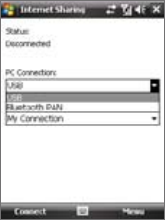
Getting Connected 171
10.10
Using Your Device as a Modem
(Internet Sharing)
Internet Sharing connects your PC or notebook computer to the Internet
by using your device’s data connection (GPRS or EDGE, for instance). You
can choose to connect via USB or Bluetooth.
Follow the procedure in this section to set up your device as a USB modem.
To learn how to set up your device as a Bluetooth modem, see “Use your
device as a Bluetooth modem” in this chapter.
Notes • Make sure your device has a SIM card installed, and your device has a
GPRS or phone dial-up modem connection. If your device has not been
set up with a data connection yet, tap Menu > Connection Settings on
the Internet Sharing screen.
• If you want to use a USB cable connection, you must first install Windows
Mobile Device Center or Microsoft ActiveSync version 4.5 or later on the
computer.
• Before using Internet Sharing, disconnect from Windows Mobile Device
Center or ActiveSync on your computer.
To set up your device as a USB modem
1. On your device, tap Start > Programs >
Internet Sharing.
2. In the PC Connection list, select USB.
3. In the Network Connection list, select
the name of the connection that your
device uses to connect to the Internet.
4. Plug in the USB cable between your
device and the computer.
5. Tap Connect.
To end the Internet connection
On the Internet Sharing screen, tap Disconnect.
172 Getting Connected
10.11 Bluetooth
Bluetooth is a short-range wireless communications technology. Devices
with Bluetooth capabilities can exchange information over a distance of
about eight meters without requiring a physical connection.
Bluetooth modes
Bluetooth on your device operates in three different modes:
• On. Bluetooth is turned on. Your device can detect other Bluetooth-
enabled devices, but not vice versa.
• Off. Bluetooth is turned o. In this mode, you can neither send nor
receive information using Bluetooth. Turn o Bluetooth when not in
use to conserve battery power, or in places where using a wireless
device is prohibited, such as on board an aircraft and in hospitals.
• Visible. Bluetooth is turned on, and all other Bluetooth-enabled
devices can detect your device.
Note By default, Bluetooth is turned off. If you turn it on, then turn off your device,
Bluetooth also turns off. When you turn on your device again, Bluetooth
automatically turns on.
To turn Bluetooth on and make your device visible
1. On your device, tap Start > Settings > Connections tab > Bluetooth
> Mode tab.
2. Select the Turn on Bluetooth and Make this device visible to other
devices check boxes.
3. Tap OK.
Bluetooth partnerships
A Bluetooth partnership is a relationship that you create between your
device and another Bluetooth-enabled device in order to exchange
information in a secure manner.
To create a Bluetooth partnership
1. On your device, tap Start > Settings > Connections tab > Bluetooth.
2. On the Devices tab, tap Add new device. Your device searches for
other Bluetooth devices and displays them in the box.
Getting Connected 173
3. Tap the desired device name in the box.
4. Tap Next.
5. Specify a passcode to establish a secure connection. The passcode
can be 1 up to 16 characters.
6. Tap Next.
7. Wait for the paired device to accept the partnership. The receiving
party needs to enter the same passcode that you specified.
8. The name of the paired device is then displayed. You may edit and
enter a new name for that device.
9. Select the check boxes of services that you want to use from the
paired device.
10. Tap Finish.
Note Creating a Bluetooth partnership between two devices is a one-time process.
Once a partnership is created, the devices can recognize the partnership and
exchange information without entering a passcode again.
To accept a Bluetooth partnership
1. Ensure that Bluetooth is turned on and in visible mode.
2. Tap Yes when prompted to establish a partnership with the other
device.
3. Enter a passcode (the same passcode that is entered on the device
requesting the partnership) to establish a secure connection. The
passcode must be between 1 and 16 characters.
4. Tap Next.
5. Tap Finish. You can now exchange information with the paired
device.
Tips • To rename a Bluetooth partnership, tap and hold the partnership’s name
on the Devices tab of the Bluetooth Settings screen, then tap Edit.
• To delete a Bluetooth partnership, tap and hold the partnership’s name on
the Devices tab, then tap Delete.
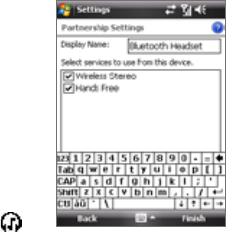
174 Getting Connected
Connect a Bluetooth hands-free or stereo headset
For hands-free phone conversations, you can use a Bluetooth hands-free
headset such as a car kit with your device. Your device also supports A2DP
(Advanced Audio Distribution Profile) which means that you can use a
Bluetooth stereo headset for hands-free phone conversations and for
listening to stereo music.
To connect a Bluetooth hands-free or stereo headset
1. Make sure that both your device and the Bluetooth headset are
turned on and within close range, and that the headset is visible.
Refer to the manufacturer’s documentation to find out how to set the
headset in visible mode.
2. Tap Start > Settings > Connections tab.
3. Tap Bluetooth > Devices tab > Add new device. Your device
searches for other Bluetooth-enabled devices and displays them in
the list.
4. Tap the name of the Bluetooth
headset, then tap Next.
5. Enter the passcode of the Bluetooth
headset, then tap Next.
6. Make sure the Hands Free check box
is selected. If you have a Bluetooth
stereo headset, also make sure
Wireless Stereo is selected.
7. Tap Finish.
While the Bluetooth stereo headset
is connected, the Headset icon ( )
will appear on the title bar.
Note If the Bluetooth stereo headset becomes disconnected, turn the headset on
and repeat steps 1 to 3 above. Tap and hold the name of the Bluetooth stereo
headset and tap Set as Wireless Stereo.
Getting Connected 175
Beam information using Bluetooth
You can beam information, such as contacts, calendar items, and tasks, as
well as files from your device to your computer or to another Bluetooth-
enabled device.
Note If your computer does not have built-in Bluetooth capability, you need to
connect and use a Bluetooth adapter or dongle on your computer.
To beam information from your device to a computer
1. Turn on Bluetooth on your device, and make your device visible. For
information about this, see “To turn Bluetooth on and make your
device visible”.
2. Next, set Bluetooth on your computer to visible mode, create a
Bluetooth partnership, then enable your computer to receive
Bluetooth beams.
If your computer has Windows Vista or Windows XP SP2 and your
computer’s Bluetooth adapter is supported by your Windows version,
do the following steps:
a. On your computer, open Bluetooth Devices from the Control
Panel then click the Options tab.
b. For Windows Vista, select Allow Bluetooth devices to find this
computer.
For Windows XP, select Turn discovery on and Allow Bluetooth
devices to connect to this computer.
c. Create a Bluetooth partnership between your device and
computer. For information about creating a partnership, see
“Bluetooth partnerships”.
d. In the Options tab of Bluetooth Devices, select Show the
Bluetooth icon in the notification area.
e. To enable your computer to receive Bluetooth beams, right-click
the Bluetooth icon at the bottom-right of your computer screen
and select Receive a File.
3. Now you are ready to beam. On your device, select an item to beam.
The item can be an appointment in your calendar, a task, a contact
card, or a file.
176 Getting Connected
4. To beam a contact, tap Menu > Send Contact > Beam.
To beam other types of information, tap Menu > Beam [type of
item].
5. Tap the device name to which you want to send the beam.
6. If you beamed a calendar, task, or contact item to your computer and
it is not automatically added to Outlook, select File > Import and
Export in Outlook to import it.
To beam information to a Bluetooth-enabled device such as another
Windows Mobile powered device, follow steps 1 to 5 in the above
procedure.
Tips • The default folder on your computer where beamed items are stored
may be C:\Documents and Settings\your_username\My Documents in
Windows XP or C:\Users\your_username\My Documents in Windows Vista.
• For your device to receive Bluetooth beams, tap Start > Settings >
Connections tab > Beam and make sure the Receive all incoming
beams check box is selected.
Bluetooth Explorer and Bluetooth file sharing
Bluetooth Explorer searches for other Bluetooth devices that have file
sharing enabled and lets you access their Bluetooth shared folder. You
can copy files from and to their shared folder, and create subfolders in it.
When you enable Bluetooth file sharing on your device, other Bluetooth-
enabled devices will also be able to access your Bluetooth shared folder.
To enable Bluetooth Explorer and Bluetooth file sharing on your device
1. Tap Start > Settings > Connections tab > Bluetooth > FTP tab.
2. Select the Enable Bluetooth Explorer check box. This makes the
\Bluetooth device folder visible in the File Explorer.
3. Select the Enable File Sharing check box.
You can use the default Bluetooth shared folder, or tap Browse to use
another folder as your shared folder.
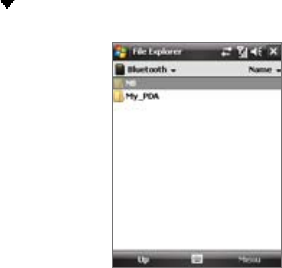
Getting Connected 177
To use Bluetooth Explorer
1. Bluetooth Explorer is integrated with the File Explorer program. You
can open it by tapping Start > Programs > Bluetooth Explorer or
by tapping Down arrow ( ) on the upper left of File Explorer then
tapping Bluetooth.
2. Bluetooth Explorer then scans for
other Bluetooth devices that have file
sharing enabled. From the list, tap to
select a Bluetooth device you want to
connect to. You may need to enter a
passcode in order for you to connect
to the selected device.
3. If there are files contained in the
Bluetooth shared folder on the other
device, you will be able to see them on
the Bluetooth Explorer screen.
Select one or more files, then tap
Menu > Edit and choose to cut or
copy the files.
4. Tap Up twice.
5. Navigate to the folder where you want to paste the files on your
device, then tap Menu > Edit > Paste.
Use your device as a Bluetooth modem
You can connect your device to a notebook or desktop computer through
Bluetooth and use the device as a modem for the computer.
Note If your computer does not have built-in Bluetooth capability, you need to
connect and use a Bluetooth adapter or dongle on your computer.
For the computer to use the Internet connection of your device, activate
Internet Sharing on your device, then set up a Bluetooth Personal Area
Network (PAN) between the computer and your device.
1. On your device, turn on Bluetooth and set it to visible mode.
2. Initiate a Bluetooth partnership from your device by following the
steps in “To create a Bluetooth partnership.“
178 Getting Connected
3. Tap Start > Programs > Internet Sharing.
4. Select Bluetooth PAN as the PC Connection.
5. From the Network Connection list, select the name of the
connection that your device uses to connect to the Internet.
6. Tap Connect.
7. On your computer, set up a Bluetooth Personal Area Network (PAN)
with your device:
For Windows Vista:
a. Click Start > Control Panel > Network and Internet > Network
and Sharing Center.
b. Click Manage network connections and then under Personal
Area Network, double-click Bluetooth Network Connection.
c. In the Bluetooth Personal Area Network Devices dialog box, select
your device, then click Connect.
For Windows XP:
a. Tap Start > Control Panel > Network Connections.
b. Under Personal Area Network, click the Bluetooth Network
Connection icon.
c. Under Network Tasks, click View Bluetooth network devices.
d. In the Bluetooth Personal Area Network Devices dialog box, select
your device, then click Connect.
8. On the Internet Sharing screen on your device, check if a connected
status is displayed, which indicates that your computer has been
successfully connected to the Internet using your device as a
Bluetooth modem.
Print files via Bluetooth
Connect your device to a Bluetooth printer to print contact information,
appointment details, messages, and other file types.
Note You can print files in the .txt, .jpg, .xhtml, .vcf, .vcs file formats.
Getting Connected 179
Before you start printing, make sure to turn on the Bluetooth printer and
to turn on Bluetooth on your device. To turn on Bluetooth, tap Start >
Programs > Comm Manager and then tap the Bluetooth button.
To print contact information
1. Tap Start > Contacts and then select the contact whose information
you want to print.
2. Tap Menu > Print via Bluetooth.
3. Tap Menu > Search Device. Your device starts to search for Bluetooth
devices.
4. Select the Bluetooth printer and tap Menu > Send File.
5. Set the printing options you want and then tap Print.
To print a calendar appointment
1. Tap Start > Calendar and then select the appointment whose details
you want to print.
2. Follow steps 2 to 5 in the “To print contact information” procedure.
To print a message
1. Tap Start > Messaging and then select the messaging account where
the message you want to print is located.
2. Select the message you want to print.
3. Follow steps 2 to 5 in the “To print contact information” procedure.
To print a JPEG file
1. Do one of the following:
• In Pictures & Videos, select the JPEG file and then tap Menu > Print
via Bluetooth.
• In File Explorer, tap and hold the JPEG file and then on the menu, tap
Print via Bluetooth.
2. Follow steps 3 to 5 in the “To print contact information” procedure.
180 Getting Connected

Chapter 11
Using GPS
11.1 Guidelines and Preparation for Using GPS
11.2 Downloading Satellite Data via QuickGPS
11.3 GPS Controls
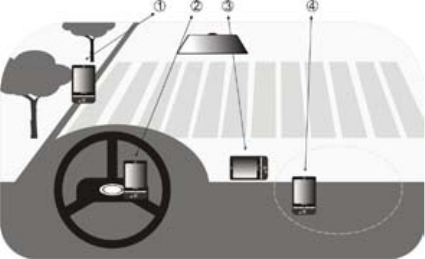
182 Using GPS
11.1 Guidelines and Preparation for Using GPS
•Do not operate the GPS system while driving.
•The plotted GPS route is only for driving references. It should not
aect actual driving behavior.
•Please use the GPS system cautiously. Users shall be liable for any
damages resulting from negligent operation of the system.
•When using inside a vehicle, please utilise the car holder to mount the
device securely in place. Please avoid the areas shown in the following
diagram:
1. Do not place where it will block the driver’s vision.
2. Do not place at where the air bags are.
3. Do not place anywhere in the vehicle without securing in the
holder.
4. Do not place where the air bags could deploy.
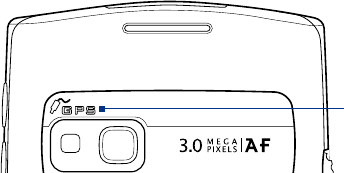
Using GPS 183
• The GPS signal cannot pass through solid non-transparent objects.
Signal reception may be aected due to obstructions such as high-
rise buildings, tunnels, bridges, forests, bad weather (rainy or cloudy
days), etc.
• Signal reception may be aected by obstructions such as high-rise
buildings, tunnels, bridges, forests, weather (rainy or cloudy days),
etc. If the vehicle’s visor contains metal, it will be dicult for the GPS
signal to pass through. To have better signal reception, try connecting
your device to an external GPS antenna.
External GPS
antenna connector
• The Global Positioning System (GPS) is built and operated by the US
Defense Department. The Department is responsible for the accuracy
and maintenance of the system. Any changes that the Department
makes may aect the accuracy and function of the GPS system.
• Wireless communication products (such as mobile phones or radar-
detecting devices) may interfere with the satellite signal, resulting in
unstable signal reception.
• Please do not leave your device in the vehicle and expose to direct
sunlight to avoid overheating the battery that could pose damage to
the device or risk to the vehicle.
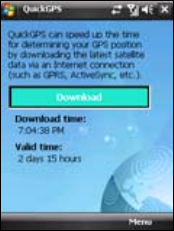
184 Using GPS
11.2 Downloading Satellite Data via QuickGPS
Before you start to use your device for GPS navigation, open the QuickGPS
program first to download Ephemeris data (current satellite position and
timing information) onto your device. This data is needed to determine the
GPS position of your current location.
QuickGPS downloads Ephemeris data from a Web server, instead of
from the satellites, using the Internet connection on your device, which
can be via ActiveSync or GPRS. This significantly speeds up the time for
determining your GPS position.
To open QuickGPS
Tap Start > Programs > QuickGPS.
To download data
Tap Download on the QuickGPS screen.
On the screen, initially, you will see the Valid time of the downloaded
data to be 3 days. As days and time pass, the remaining days and time
of validity will be shown.
To speed up GPS positioning, download the latest Ephemeris data
when the validity of the data expires.
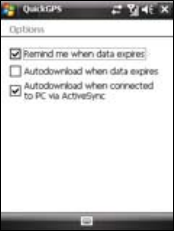
Using GPS 185
Download options
To configure download times, tap Menu > Options and choose from the
following options:
•Remind me when data expires. Enables your device to display
a reminder message when the validity of the Ephemeris data has
expired.
When you see the reminder message, tap Menu to dismiss the
reminder or to set the snooze time so that you will be reminded
again. Tap OK to open the QuickGPS program and download the
latest data.
•Autodownload when data expires. Allows Ephemeris data to be
automatically updated onto your device when the data has expired.
•Autodownload when connected to PC via ActiveSync. Allows
Ephemeris data to be automatically downloaded via ActiveSync to
your device when your device is connected to your computer. Your
computer must be connected to the Internet in order to download
data.
Note The Ephemeris data are stored on HTC Web servers. QuickGPS is
preconfigured to connect to these servers.
186 Using GPS
11.3 GPS Controls
When a map or menu is shown on the GPS software, use the following
controls on your device to navigate:
= On the Map Browser screen, press NAVIGATION up to zoom in, press
NAVIGATION down to zoom out on a map.
= Use the NAVIGATION CONTROL to scroll through items in a menu.
Press the ENTER button to select a menu item and open the
corresponding screen.
= On the Driving View screen, Press NAVIGATION up to zoom in, press
NAVIGATION down to zoom out on a map.
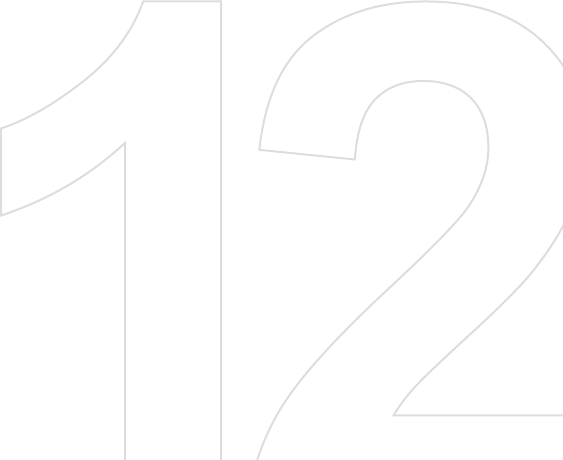
Chapter 12
Experiencing Multimedia
12.1 Camera
12.2 Pictures & Videos
12.3 Windows Media® Player Mobile
12.4 Audio Manager
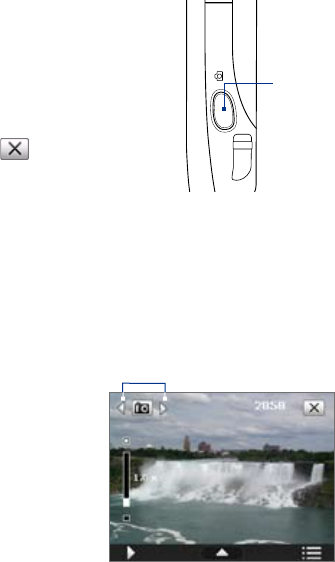
188 Experiencing Multimedia
12.1 Camera
Taking photos and recording video clips along with audio are easy with
your device’s built-in camera.
To open the Camera screen
• Press the CAMERA button on your device.
• Tap Start > Programs > Camera.
The screen orientation automatically switches to
landscape mode when you open Camera.
To exit the Camera
• Tap the Exit icon ( ) on the Camera
screen.
CAMERA
button
Capture modes
The camera on your device allows you to capture pictures and video clips by
using various built-in modes that provide you flexibility in taking your shots.
The Camera mode is set to the Photo capture mode by default. The upper
left corner of the screen displays the active capture mode.
To change the capture mode
• Tap the left or right arrows
next to the mode icon.
• Press NAVIGATION right or
left (in landscape orientation).
• Scroll the Jog Wheel.
Tap to change the capture mode.
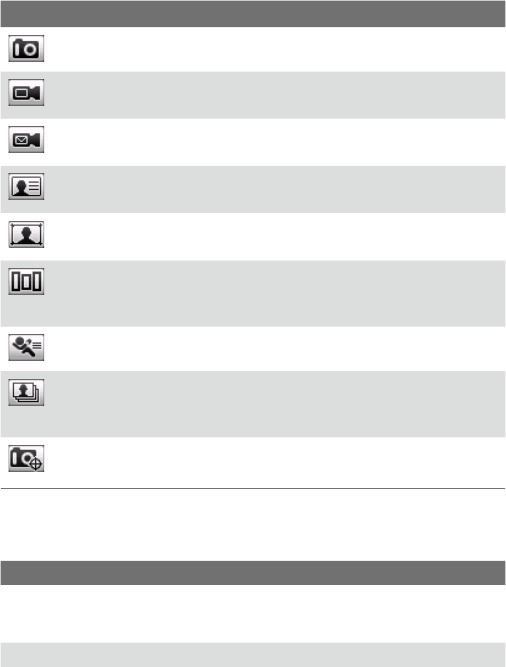
Experiencing Multimedia 189
You can select from the following capture modes:
Icon Capture Mode
Photo: Captures standard still images.
Video: Captures video clips, with or without accompanying
audio.
MMS Video: Captures video clips suitable for sending with MMS
messages.
Contacts Picture: Captures a still image and gives you the
option to immediately assign it as a Photo ID for a contact.
Picture Theme: Captures still images and places them within
frames.
Panorama: Captures a sequence of still images continuously
in one direction, and stitches the images to create a panoramic
view of a scene.
Sports: Captures consecutive photo shots (3, 5, 7, or 10).
Burst: Captures a sequence of still images (maximum 30) as long
as the CAMERA button, Jog Wheel, or the ENTER button on the
NAVIGATION Control is kept pressed.
GPS Photo: Captures still images of your current geographical
location using the built-in GPS.
File formats supported
Using the available capture modes, the camera in your device captures files
in the following formats:
Capture type Format
Photo / Contacts Picture / Picture
Theme / Panorama / Sports / Burst /
GPS Photo
JPEG
Video / MMS Video H.263 (.3gp) ; MPEG-4 (.mp4)

190 Experiencing Multimedia
Camera controls
The camera comes with an auto-focus function to let you capture sharp
and crisp photos and videos of your subjects. Depending on the option you
have chosen in Shoot Option, you will need to either press the CAMERA
button half-way or all the way to take a photo or to start capturing video.
When you press the CAMERA or ENTER button, the Camera starts to focus
on the subject, indicated by a flashing bracket ( ). When focus is set, the
bracket changes to a steady green bracket ( ).
Note The Shoot Option only applies to the CAMERA button. Pressing the ENTER
button automatically takes the shot.
To take photos and video clips
• Press the CAMERA button, ENTER button, or the Jog Wheel to take a
photo or contacts picture.
• Press the CAMERA button, ENTER button, or the Jog Wheel to start
recording video; press it again to stop recording.
• Press the CAMERA button, ENTER button, or the Jog Wheel when
taking each shot in Picture Theme or Panorama mode.
• Press the CAMERA button, ENTER button, or the Jog Wheel to take
consecutive shots in Sports mode, then move your device to follow
the movement of your subject.
• Press and hold the CAMERA button, ENTER button, or the Jog Wheel
when taking consecutive shots in Burst mode. Release the button to
stop taking shots.
On-screen controls and indicators
The on-screen controls and indicators appear on the Camera screen for a
short duration, and then they disappear automatically from the screen to
offer you a distraction-free view of the image that you intend to capture. To
view the controls and indicators again, touch or tap the screen.
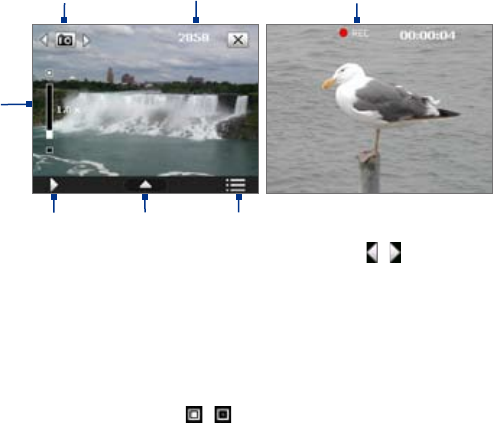
Experiencing Multimedia 191
3
7
Video mode
6
1 2
4
Photo mode
5
1 Mode Switching control. Tap the left/right arrow ( / ) on the
screen to switch the capture mode.
2 Remaining information indicator. In Photo, Contacts Picture, Picture
Theme, Panorama, Sports, Burst, and GPS Photo modes, this shows
the remaining, available shots of pictures based on current settings.
In Video and MMS Video modes, this shows the remaining duration
that can be recorded. While recording video, this shows the recorded
duration.
3 Zoom control. Tapping / on the screen allows you to zoom in or
zoom out.
Note This control only appears when zooming is supported by the
Resolution you have selected.
Tip You can also press NAVIGATION up/down (in landscape orientation) to
zoom in and out.
4 Album. Tap to view photos and videos on your device and/or storage
card.
5 Quick Settings Panel. Tap to open the Quick Settings Panel. See
“Quick Settings Panel” for details.
6 Menu. Tap to open the Camera Settings screen.
7 Recording indicator. This shows a red, ashing indicator while video
recording is in progress.

192 Experiencing Multimedia
Picture Theme mode
8
10
Sports mode
9
8
Template Selector icon. In Picture Theme mode, tap to toggle
among the dierent templates.
9
Progress indicator. In Picture Theme, Panorama, Sports, and Burst
modes, this shows the number of consecutive shots.
10 Exit. Tap to exit the Camera program.
11 GPS Signal Indicator icon. In
GPS Photo mode, indicates
that the GPS service is connected
and ready, while indicates that
the GPS service is disconnected
or not available.
11
Quick Settings Panel
The Quick Settings Panel provides a quick way of adjusting the most
common camera settings. Tap the screen to open the Quick Settings Panel.
Keep tapping a button on the panel, for instance, Resolution, to cycle
through the available settings.
Note The available settings on the menu depend on the Capture mode selected.
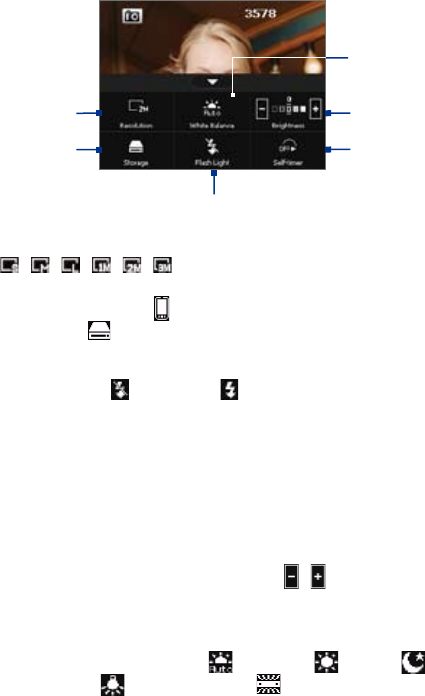
Experiencing Multimedia 193
2
15
4
3
6
1 Resolution. The resolution icon indicates the current resolution. Tap
to toggle among the dierent resolution options:
/ / / / /
2 Storage. Tap to toggle between saving captured photos or video clips
on the device memory or on the built-in ash storage card, called
NAND Flash . You can also save the captured photos and video
clips on a storage card if you have installed a storage card on your
device. In such a case, tap Storage Card 1 or Stoarge Card 2.
3 Flash Light. Tap to turn on or to turn o the ash light that is
located at the back of the device.The Flash Light option is available
for Photo, Contacts Picture, Picture Theme, Panorama, and GPS Photo
capture modes.
4 Self-timer. Tap to set the self-timer to 2 seconds, 10 seconds, or Off
when in the Photo or Contacts Picture mode. When you press the
Jog Wheel, CAMERA button, or ENTER button to capture a still image,
it starts to count down, and then captures a still image after the
assigned time.
5 Brightness. Tapping the minus/plus icon ( / ) decreases or
increases the brightness level.
6 White Balance. White balance enables the camera to capture
colors more accurately in dierent lighting conditions. White
balance settings include Auto ( ), Daylight ( ), Night ( ),
Incandescent ( ), and Fluorescent ( ).

194 Experiencing Multimedia
Zooming
Before taking a picture or shooting video, you can zoom in on your subject
by pressing NAVIGATION up (landscape orientation) on your device or by
tapping the Zoom In button ( ) above the Zoom Bar. When the zooming
limit is reached, you will hear a beep. To zoom out, press NAVIGATION down
(landscape orientation) or tap the Zoom Out button ( ).
The camera zoom range for a picture or a video clip depends on the capture
mode and resolution. The following is a summary:
Capture mode Capture size setting Zoom range
Photo /
GPS Photo
3M (1536 x 2048) No zooming available
2M (1200 x 1600) No zooming available
1M (960 x 1280) 1.0x to 2.0x
Large (480 x 640) 1.0x to 2.0x
Medium (240 x 320) 1.0x to 4.0x
Small (120 x 160) 1.0x to 8.0x
Video
CIF (352 x 288) 1x and 2x
Large (320 x 240) 1x and 2x
Medium (176 x 144) 1x and 2x
Small (128 x 96) 1x and 2x
MMS Video Medium (176 x 144) 1x and 2x
Small (128 x 96) 1x and 2x
Contacts
Picture
Large (480 x 640) 1.0x to 2.0x
Medium (240 x 320) 1.0x to 4.0x
Picture Theme Determined by the current
template
Depends on the size of the
template currently loaded
Panorama
Large (480 x 640) 1x and 2x
Medium (240 x 320) 1x, 2x and 4x
The final stitched image size varies depending on the capture
size and panorama direction setting.
Sports Large (480 x 640) 1x and 2x
Medium (240 x 320) 1x, 2x and 4x
Burst Large (480 x 640) 1x and 2x
Medium (240 x 320) 1x, 2x and 4x
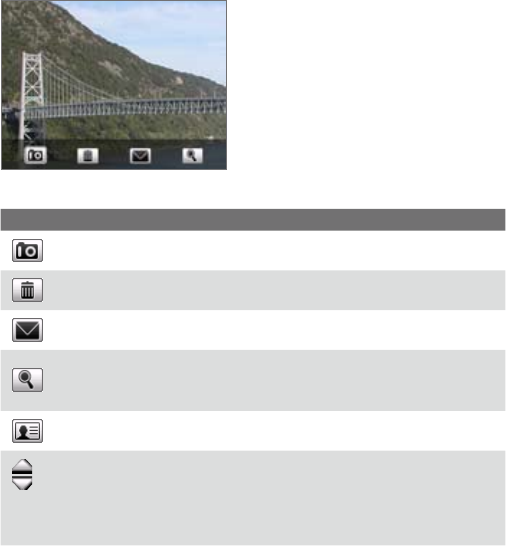
Experiencing Multimedia 195
Note The zoom control only appears onscreen when zooming is supported by the
Resolution you have selected.
The Review screen
After taking a still image or
recording a video clip, you can view,
send, or delete the image or video
clip on the Review screen.
You can also tap the following icons at the bottom of the Review screen:
Icon Function
Back Return to the live Camera screen.
Delete Remove the captured image or video.
Send Send via e-mail or MMS.
View
View the image in the Pictures & Videos program,
or play the captured video in Windows Media®
Player.
Assign to Contacts Associate the photo to a selected contact.
Browse
After capturing in Sports or Burst mode, the total
number of consecutive shots is shown in the
top right corner of the Review screen. Tap the
up/down arrow to browse through the sequence
of photos.
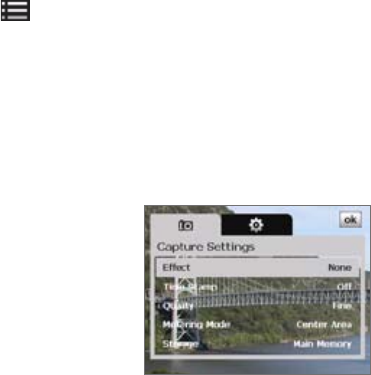
196 Experiencing Multimedia
Camera settings
Tap the Menu icon ( ) to open the Camera Settings screen. The Camera
Settings screen allows you to configure capture and camera settings.
The Camera settings consist of two tabs: Capture Settings and Advanced.
Use the Capture Settings tab to adjust options for your selected capture
mode; Use the Advanced tab to set the Camera program preferences.
You can either tap on-screen or press the NAVIGATION Control buttons to
navigate the Camera Settings screen.
Capture Settings tab
The available options on this tab depend on the capture mode selected.
• Template (Picture Theme). Select
a template to use.
•
Effect. Choose a special eect such
as Grayscale, Sepia, etc., to apply to
your photos or video clips
.
Note White Balance cannot be
applied if an Effect has already
been applied.
• Time Stamp (Photo, Sports, Burst, and GPS Photo modes). Choose
whether or not to include the shooting date and time on captured
photos.
• Quality (Photo, Contacts Picture, Panorama, Sports, Burst, and GPS
Photo modes). Select the JPEG image quality level for all captured still
images. You can choose from Basic, Normal, Fine, and Super Fine.
• Metering Mode. Select a metering mode to allow the camera to
measure the amount of light and calculate the best-fit exposure value
before capturing. Choose either Center Area to measure light using
the center area of the image or Average to measure light using the
area all around the image.
• Storage. Select where you want to save your files. You can either save
the files to the Main memory, NAND flash, or to a storage card.
•
Capture Speed (Burst and Sports modes). This determines the interval
between shots. Fast captures consecutive shots at the shortest interval
.
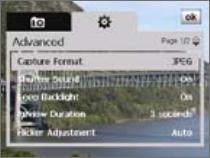
Experiencing Multimedia 197
• Snapshots (Sports mode). Select the number of consecutive shots to
capture.
• Direction (Panorama mode). Choose in what direction images will be
stitched in a panorama.
• Stitch Count (Panorama mode). Select the number of snapshots to
be taken and stitched into a panorama.
• Grace Period. (GPS Photo). Select the amount of time (None, 3
minutes, 10 minutes) during which you can capture photos or video
clips without having an active GPS signal on your device. After this
duration is over, you will be prompted to reinitiate the GPS signal
if it is disconnected or broken. If the GPS signal is not restored, the
capture mode changes to Photo.
Advanced tab
The available options on this tab depend on the capture mode selected.
• Capture Format. Select the
desired file format.
• Shutter Sound. Choose whether
or not you want the camera to
make a shutter sound when you
press the Jog Wheel, ENTER button,
or CAMERA button to take photos
or record video clips.
• Shoot Option. The camera comes with an auto-focus feature
that is activated when the CAMERA or ENTER button is pressed.
Selecting Full Press requires you to press the CAMERA button all
the way to take the shot after auto-focus is set. Selecting Half Press
automatically takes the shot after auto-focus is set.
Note This option only applies to the CAMERA button. Pressing the ENTER
button or Jog Wheel automatically takes the shot.

198 Experiencing Multimedia
• Grid (Photo and GPS
Photo modes). Choose
whether or not to show
a grid on the Camera
screen. Showing a grid
helps you frame and
center your subject more
easily and accurately.
Grid
marks
• Keep Backlight. Choose whether to turn the backlight on or off while
using the camera. Setting this to On overrides your device backlight
settings while you are using the camera.
• Review Duration. Set a time length for displaying the captured
image/video on the Review screen. Select No Limit if you do not want
to impose a time limit. Select No Review to immediately return to the
live Camera screen after capturing and saving.
• Flicker Adjustment. When taking indoor shots, flicker on the camera
screen may be caused by inconsistencies between the vertical scan
rate of the camera display and the flicker frequency of fluorescent
lighting. To reduce flicker, you can change the flicker adjustment
setting to Auto or to the proper frequency (50Hz or 60Hz) of the
power in the country where your device is being used.
• Record with Audio (Video and MMS Video mode). Select On to
record audio with the captured video clips, or select Off to capture
video without audio.
• Prefix. When Default is selected as the prefix, the file name of each
new captured file is set to “IMAGE” or “VIDEO” followed by a sequential
number, for example: IMAGE_001.jpg. You may also choose to name
files using either the current Date or Date & Time as the prefix.
Note If you set the Camera to save captured photos to a storage card, the
prefix cannot be selected. Captured photos will be named using the
convention IMAGnnnn.jpg (where 'nnnn' is the counter) which is the
DCIM (Digital Camera Images) naming standard, and will be saved to
the \DCIM\100MEDIA folder on the storage card.
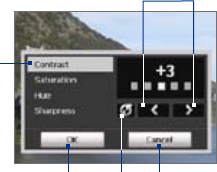
Experiencing Multimedia 199
• Counter. To reset the file naming counter back to 1, tap Reset.
• Recording Limit (Video mode). Set the maximum duration or file size
for recording video.
• Template Folder (Picture Theme mode). By default, templates are
stored in the \My Documents\Templates folder on the device’s Main
Memory. If you transferred some templates to a storage card (via File
Explorer), set this option to Main + Card to specify that templates are
located in both the main memory and the storage card.
• Image Properties. This option lets you adjust the camera display
properties, such as Contrast, Saturation, Hue, and Sharpness.
Note The Image Properties option is not accessible if an Effect on the
Capture Settings tab has already been applied.
1Tap a property to adjust.
2Tap the left/right arrow icon
or press NAVIGATION left/right
(in landscape orientation) to
increase/decrease the value.
3Tap to close the submenu
without applying and saving the
changes.
4Tap to reset all properties to
their default values.
5Tap to save the settings.
2
3
4
1
5
• Show Reminder (Contacts Picture mode). Select On if you want the
Camera to always display a message that confirms whether or not to
assign the captured picture to a contact.
• Help. Tap to open the Camera program help file.
• About. Tap to view information about the Camera program.
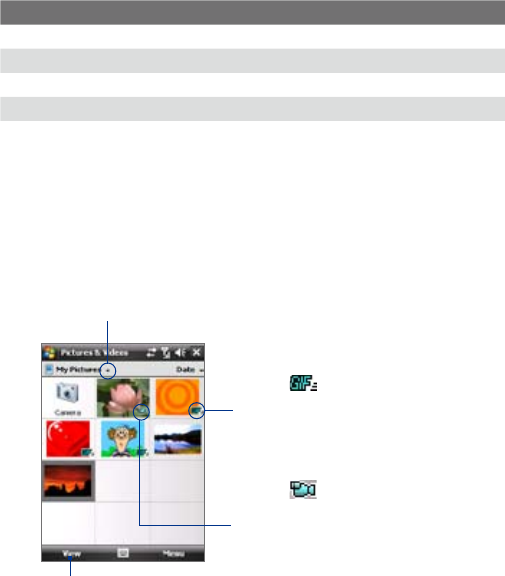
200 Experiencing Multimedia
12.2 Pictures & Videos
Pictures & Videos allows you to view and manage the following types of
media files on your device:
File Type File Extensions
Image *.bmp, *.jpg, *.gif, *.png
GIF animation *.gif
Video *.avi, *.wmv, *.mp4, *.3gp, *.3g2
Audio *.wma
To open Pictures & Videos
Tap Start > Programs > Pictures & Videos.
To view media files
1. On the Today screen, tap Start > Programs > Pictures & Videos.
2. Select a media file and click View or Play (if video file) to view or play
back the file.
Tap to select a different
device location.
Tap to view or play back the
selected media file.
This icon indicates that
the file is a video file. Tap Play
to play back the file in Windows
Media® Player Mobile.
This icon indicates that
the file is a GIF animation
file. Tap View to play back
the file.
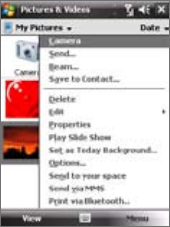
Experiencing Multimedia 201
To copy media files to your device
• Copy pictures and GIF animation files from your PC or a storage card
to the My Pictures folder on your device.
• Copy video files to the My Videos folder.
For more information about copying and managing files on your device, see
Chapter 9.
Pictures & Videos menu
Select a media file onscreen and tap Menu to open a list of options that you
can do with the selected media file.
You can choose to send the selected
media file via one of your messaging
accounts, beam it to another device, play
the pictures as a slide show, send the
picture to your Windows Live MySpace
account, and more.
Tap Options to customize picture
settings and slide show playback
preferences.
Note The available menu options depend on
the selected media file.
When viewing a picture file, tap Menu > Set as Today Background to set
the picture as your Today Screen background.
Edit a picture
You can also do minor touch ups to a still image file such as rotate and crop.
1. In Pictures & Videos, select the picture you want to edit and tap View.
2. Tap Menu > Edit.
3. Tap Rotate to rotate the picture 90 degrees clockwise or tap Menu to
access more editing options.
Tip Each tap of Rotate rotates the picture 90 degrees clockwise.
4. Tap OK.
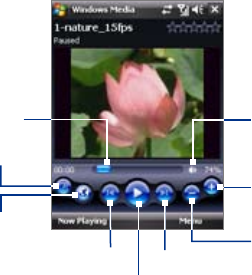
202 Experiencing Multimedia
12.3 Windows Media® Player Mobile
You can use Windows Media® Player Mobile to play digital audio and video
files that are stored on your device or on a network, such as on a Web site.
To open Windows Media Player Mobile
Tap Start > Programs > Windows Media.
About the controls
The following are available controls on the Windows Media® Player Mobile.
Play/Pause
Full screen
Visit WindowsMedia.com
Tap and drag to
jump to any part of
the video or audio
Skip to the beginning of
the current file or to the
previous file
Skip to the next file
Mute/Unmute
Increase Volume
Decrease Volume
About the screens and menus
Windows Media® Player Mobile has three primary screens:
• Playback screen. The screen that displays the playback controls (such
as Play, Pause, Next, Previous, and Volume) and the video window.
• Now Playing screen. This special playlist indicates the current file
being played and any files that are “queued up” to play next.
• Library screen. The screen that lets you quickly find your audio files,
video files, and playlists.

Experiencing Multimedia 203
At the bottom of each screen, you can open a Menu. The commands on
this menu vary, depending upon which screen you are viewing. For more
information about the commands in these menus, see Help on your device.
File formats supported
Video File Formats Supported File Extensions
Windows Media Video
MPEG4 Simple Profile
H.263
H.264
Motion JPEG
.wmv, .asf
.mp4
.3gp, .3g2
.mp4, .3gp, .3g2, .m4v
.avi
Audio File Formats Supported File Extensions
Windows Media Audio
WAV
MP3
MIDI
AMR Narrow Band
AMR Wide Band
AAC, AAC+ and eAAC+
MPEG4 audio
QCELP
.wma
.wav
.mp3
.mid, .midi, .rmi
.amr
.awb
.aac, .mp4, .m4a
.mp4, .m4a
.qcp
About licenses and protected files
When copying protected files from your PC to your device, use the Windows
Media® Player on your PC to synchronize the file to your device. For more
information about synchronizing files to your device, see the Windows
Media® Player Help.
Note You can view the protection status for a file by checking its file properties
(tapping Menu > Properties).
204 Experiencing Multimedia
Synchronize video and audio files
Use the latest version of Microsoft Windows Media® Player on your PC to
synchronize digital media files from your PC to your device. This ensures
that protected files and album art (for skins) are copied to your device
correctly.
To synchronize content to your device automatically
1. On your PC, start Windows Media® Player and then connect your
device to your PC.
2. In the Device Setup Wizard, type a name for your device and click
Finish.
3. On the leftmost pane, right-click your device and select Set Up Sync.
Note You can also sync your storage card if you have one installed on your
device. To sync, right-click Storage Card.
4. On the Device Setup dialog box, select Sync this device
automatically and then select the playlist(s) that you want to sync
between your PC and device.
5. Click Finish.
The files begin synchronizing to your device. The next time you connect
your device to your PC while Windows Media® Player is running,
synchronization will start automatically.
To synchronize content manually to your device
1. If you have not set up synchronization between your device and
PC, follow steps 1 to 3 in “To synchronize content to your device
automatically”.
2. Click the Sync tab on the Windows Media® Player of your PC. Select a
Playlist or a Library on the left panel of the Windows Media® Player.
3. From the Content List, drag the media files that you want to sync to
your device and drop them to the Sync List.
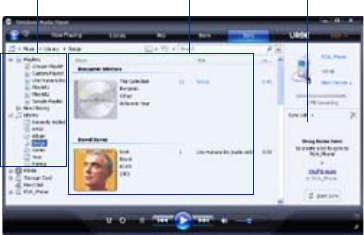
Experiencing Multimedia 205
Playlists and Library List Sync ListContent List
4.
Click Start Sync to start synchronizing the selected files to your device
.
Notes • Use Windows Media® Player 11 or higher on your PC to synchronize media
files to your device.
• Audio files copy faster if Windows Media® Player is configured to
automatically set the quality level for audio files copied to your device. For
more information, see the Windows Media® Player Help.
Play media
Use the library on Windows Media® Player Mobile to find and play songs,
videos, and playlists that are stored on your device or removable storage
card.
To update the Library
1. If you are not on the Library screen, tap Menu > Library.
2. On the Library screen, tap the Library arrow (near the top of the
screen), then tap the media storage that you want use, for example,
Storage Card.
3. In most cases, Windows Media® Player Mobile automatically updates
the library. However, you can manually update the library to ensure
that it contains new files that you recently copied to your device or
storage card. Tap Menu > Update Library to manually update the
library list.
206 Experiencing Multimedia
To play video and audio files on your device
1. Select a category (for example, My Music or My Playlists).
2. Tap and hold the item that you want to play (such as a song, album, or
artist name), then tap Play.
Tips • To play a media file that is stored on your device but is not in a library, on
the Library screen, tap Menu > Open File. Tap and hold the item that you
want to play (such as a file or a folder), then tap Play.
• To play a media file from the Internet or a network server, tap Menu >
Library then tap Menu > Open URL.
Playlists
A playlist is a list of digital media files that play in a specified order. By using
playlists, you can group audio and video files together for convenient
playback.
In Windows Media® Player on your PC, you can create playlists and
synchronize them with your device.
In Windows Media® Player Mobile on your device, you can create a new
playlist by saving the current Now Playing playlist and giving it a new name.
To save a new playlist
1. If you are not on the Library screen, tap Menu > Library.
2. Tap to select a category (for example, My Music or My Playlists).
3. Select a media file that you want, then tap Menu > Queue Up. This
adds the file to the Now Playing list.
Repeat this step until you have added all desired media files to the
Now Playing list.
Note You cannot select multiple files simultaneously.
4. After adding the media files, tap Menu > Now Playing.
5. On the Now Playing screen, tap Menu > Save Playlist.
6. Enter the playlist name then tap Done.
7. To play back the playlist you created, tap My Playlists in the Library,
select your playlist, then tap Play.

Experiencing Multimedia 207
Troubleshooting
If you encounter a problem while using the Windows Media® Player Mobile,
a number of resources are available to help you troubleshoot the issue.
For more information, see the Troubleshooting Windows Media® Player
Mobile page at the Microsoft Web site (http://www.microsoft.com/
windows/windowsmedia/player/windowsmobile/troubleshooting.aspx).
12.4 Audio Manager
Audio Manager is a music browser and player in one. It gives you access
to all the music files on your device, and allows you to easily browse for the
music that you want to play by organizing music into categories such as
title, artist, album, etc. You can also create playlists of your favorite songs
and use the integrated Music Player to play them back.
To launch Audio Manager
Tap Start > Programs > Audio Manager.
Notes • Audio Manager searches for all music files stored on your device memory
and memory card that have the following audio formats: MP3, WMA, AAC,
and AAC+. It will search in the following locations:
Device: My Music\
My Documents (including all subfolders)
Memory card: \Storage Card (including all subfolders)
• Music files are categorized under Artists, Album, Genre, etc. if such
metadata are found in the files.
Library
On the Audio Manager’s Library screen, an arrow that appears in an item
indicates that there is a submenu available. Tap the item name to open the
submenu.
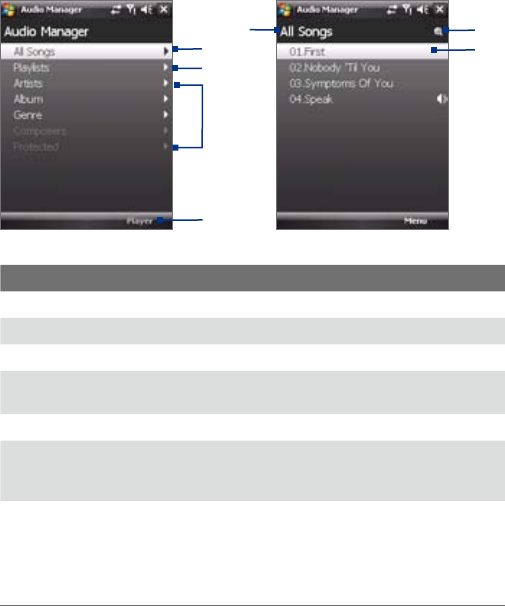
208 Experiencing Multimedia
1
3
4
5
7
2
6
Library: Main screen Library: All Songs screen
No. Description
1Opens a submenu where you can browse music files by file name or song title.
2Opens a submenu where you can create playlists and play them back.
3Opens a submenu where you can browse music files by the selected category.
4Switches to the Music Player screen. (Music Player does not automatically start
playback. You need to tap the Play icon).
5Shows the current submenu name. Tap to return to the upper-level menu.
6Shows a Search icon when the music database in Audio Manager is being
updated. This occurs when music files have been added, renamed, or removed
on the device memory or memory card.
7Shows the song titles or file names of music files when you are in the All Songs
screen. Tap or use the NAVIGATION Control to select a music file and play it in
the Music Player.
Shows more submenus when you are in one of the category screens, such as
Artists, Album, etc. Tap or use the NAVIGATION Control to open a submenu.
When you tap a category on the Library’s Main screen, you will see more
submenus which may have deeper levels of menus. For example, when you
tap Artists, another level of submenus will be listed showing artist names.
When you tap an artist name, more submenus showing album names will
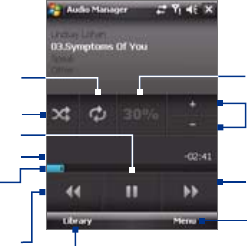
Experiencing Multimedia 209
be displayed. Just keep opening the submenus until you reach the level
where song titles can be selected for playback.
Music files that are protected by Digital Rights Management (DRM) will be
listed under the Protected category. A lock icon shown before song titles
indicates that the music files are protected. Select a file then tap Info if you
want to view file information. A cross-marked lock icon shown before song
titles indicates that the rights for the music files have expired, and you will
not be able to play them. Tap Delete if you want to delete these files.
Note Audio Manager keeps track of the last submenu that you accessed. When
you exit Audio Manager and open it again, it will display the last submenu
that you were in. Keep tapping the submenu name at the top of the screen
until you reach the Library's Main screen.
Music Player
Music Player is integrated within Audio Manager, and it lets you play back
music files. When you select a song in the Library, Music Player opens and
automatically plays it. Use the available buttons to control the playback.
Note When you tap the Exit icon at the top right of the Music Player screen, Audio
Manager closes. Next time you launch Audio Manager, it will open Music
Player directly. To switch back to the Library, tap Library.
Repeat
Shuffle
Playback time
Play/Pause
Increase/Decrease
volume
Go to previous
music Return to
Library screen
Go to next music
Volume level
Open a menu where you can
choose to add the current song
to a playlist, set the song as ring
tone, and more.
Drag the slider to
move forward or
backward in a music.
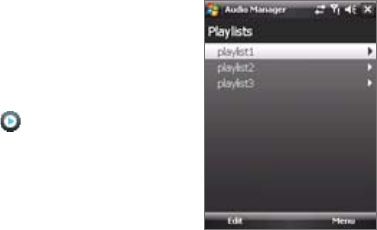
210 Experiencing Multimedia
Playlists
A playlist is a list of music files that play in a sequential order. The Playlists
screen shows the current playlists that are found on the device memory and
memory card.
There are two types of playlists that will be shown on the Playlist screen:
• Windows Media® Player playlists.
These are playlists that are in Windows
Media® Player Mobile’s Library (which
is synchronized with Windows Media®
Player on your computer), and they
are indicated by the Windows Media®
Player icon ( ). They can be played
in Audio Manager’s Music Player but
cannot be edited.
• Custom playlists. These are playlists
that are created in Audio Manager and
can be edited.
Notes • Audio Manager will search for playlists in the following locations:
Device: \Application Data\HTC\AudioManager\playlists
\Playlists
Memory card: \Storage Card\Playlists
• If a Windows Media® Player playlist contains a combination of music,
video and image files, Audio Manager accesses the music files only and
filters out the other media types.
To create a playlist
1. On the Library’s Main screen, tap Playlists.
2. On the Playlists screen, tap Menu > New.
3. Enter a Playlist name then tap OK.
4. On the Playlists screen, tap the playlist you have just created then tap
Edit.
5. Tap Menu > Add.
6. Tap the check boxes to select the songs you want to add to the
playlist, or tap Menu > Select All to choose all the songs.
7. Tap OK thrice to return to the Playlists screen.
Experiencing Multimedia 211
To play back a playlist
1. On the Playlists screen, tap to select a playlist.
2. Tap the first song in the selected playlist. Music Player automatically
opens and starts playing the first song. After each song, the next one
in the playlist will be played.
Note The content of playlists is not automatically updated when music files have
been deleted from the device memory or memory card. Music Player will
display a notification message when you play back a playlist and music files
in that playlist cannot be found.
To edit a playlist
1. On the Playlists screen, select a playlist you want to edit.
2. Tap Edit.
3. Tap Menu to open a list of editing options. You can choose to add
more songs, copy or delete songs, and more.
4. After you have finished editing the playlist, tap OK twice.
5. To return to the Playlists screen, tap the playlist name that’s shown at
the top of the screen.
To add a playlist to another playlist
1. On the Playlists screen, use the NAVIGATION Control to scroll to the
playlist that you want to add to another playlist.
2. Tap Menu > Copy to Playlist.
3. Tap the playlist where to copy it to then tap OK. Tap New Playlist if
you want to add the playlist to a new playlist.
Set music as ring tone
Audio Manager allows you to select your favorite music and set it as a ring
tone for your device.
1. Use the NAVIGATION Control to select a song in the Library, or tap a
song to play it in Music Player.
2. Tap Menu > Set as Ring Tone.
3. If the selected song is in MP3 format, you can trim it first to make it
shorter. Tap Trim to open the MP3 Trimmer and trim the song. For
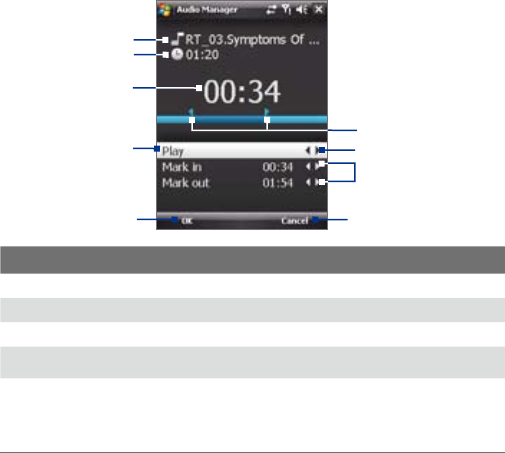
212 Experiencing Multimedia
more information about trimming, see “MP3 Trimmer”.
4. Tap Set as Default Ring Tone.
5. A confirmation message is then displayed. Tap OK.
Tip If you only want to save the song to the ring tone folder for future use, tap
Save to Ring Tone Folder. Later on, you can tap Start > Settings > Personal
tab > Phone to set it as your ring tone.
MP3 Trimmer
Before setting an MP3 file as a ring tone for your device, you can edit the
song first to shorten the duration and make the file size smaller. Use the
available controls on the MP3 Trimmer to cut the song shorter.
1
5
46
2
3
7
9
8
This control Function
1Title Shows the file name for the song.
2Duration Shows the length of the song after trimming.
3Time Shows the playback time when the song is played.
4Play/Stop Tap to toggle between playing and stopping playback.
5Trimmer Allows you to mark the part of the song that will be
used for the ring tone. Drag the left handle to mark the
start time (mark-in point), then drag the right handle
to mark the end time (mark-out point).
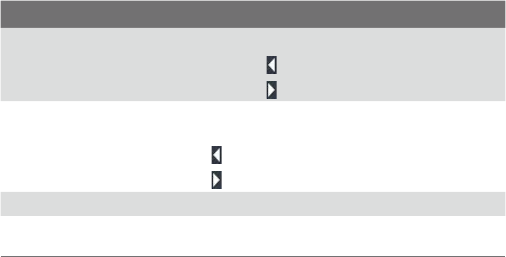
Experiencing Multimedia 213
This control Function
6Rewind/Fast
Forward
While playing:
• Tap and hold to rewind; or
• Tap and hold to fast forward.
7Mark in/
Mark out
Allows precise marking of the start and end times of
the song that will be used for the ring tone.
• Tap to step backward one second and mark it; or
• Tap to step forward one second and mark it.
8OK Tap to confirm trimming the ring tone.
9Cancel Tap to exit MP3 Trimmer without trimming the ring
tone.
214 Experiencing Multimedia
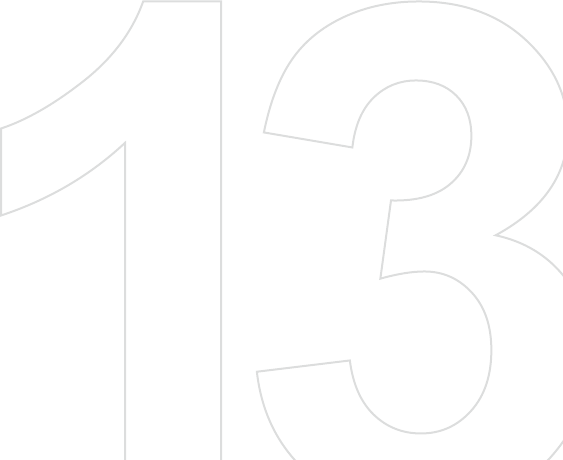
Chapter 13
Managing Your PDA Phone
13.1 Adding and Removing Programs
13.2 Managing Memory
13.3 Task Manager
13.4 Resetting Your Device
13.5 Checking System Information
13.6 Windows Update
13.7 Battery Saving Tips
216 Managing Your PDA Phone
13.1 Adding and Removing Programs
Before you purchase additional programs for your device, make sure that
they are compatible with your device.
To add programs
1. Download the program to your PC (or insert the CD or disk that
contains the program into your PC). You may see a single *.exe file,
a *.zip file, a Setup.exe file, or several versions of files for dierent
device types and processors. Be sure to select a program designed for
your device and processor type.
2. Read any installation instructions or documentation that comes with
the program. Many programs provide special installation instructions.
3. Connect your device to the PC.
4. Double-click the *.exe file.
To remove programs
You can only remove programs that you installed. Programs that come with
your device cannot be removed.
1. Tap Start > Settings > System tab > Remove Programs.
2. In the Programs in storage memory list, select the program you
want to remove, and tap Remove.
3. Tap Yes. If another confirmation message appears, tap Yes again.
Managing Your PDA Phone 217
13.2 Managing Memory
You may need to stop a program if it becomes unstable or the program
memory is low.
To see how much memory is available
• Tap Start > Settings > System tab > Memory.
• On the Main tab, the amount of memory allocated to file and data
storage versus program storage is displayed, as well as the amount of
memory in use versus the available memory.
To see available storage card memory
You can see how much memory is available on a storage card that is
inserted in your device.
1. Tap Start > Settings > System tab > Memory.
2. Tap the Storage Card tab.
To free up program memory
Try the following to free memory on your device:
• Close programs you are not currently using.
• Move e-mail attachments to a storage card.
• Move files to a storage card. Tap Start > Programs > File Explorer.
Tap and hold the file, and tap Cut. Browse to the storage card folder
and tap Menu > Edit > Paste.
• Delete unnecessary files. Tap Start > Programs > File Explorer. Tap
and hold the file, and tap Delete.
• Delete large files. To find your largest files, tap Start > Programs >
Search. In the Type list, tap Larger than 64 KB, and tap Search.
•
In Internet Explorer® Mobile, delete temporary Internet files and clear
history information. For more information, see “Internet Explorer®
Mobile” in Chapter 10.
• Remove programs you no longer use.
• Reset your device.

218 Managing Your PDA Phone
13.3 Task Manager
Task Manager lets you view and stop running programs, configure the
button, and enable the Quick Menu on the Today screen.
To open Task Manager
Tap Start > Settings > System tab > Task Manager.
To view running programs in Task Manager
1. Tap the Running tab to view the Running Programs List.
2. Select the check box of the programs that you want to close, and then
tap Stop Selected to close them.
Tips • To switch back to a running program, tap the program name to open a
shortcut menu then tap Activate.
• Tap Stop All to close all programs in the list.
To add a program to the exclusive list
Programs added to the Exclusive Programs List will not be ended when
you tap Stop Selected or Stop All and will not be listed on the Quick Menu
on the Today Screen.
1. Tap the Running tab.
2. Tap and hold the program in the list to open a menu.
3. Tap Add Exclusive to add it into the Exclusive Programs List.
Tip To remove a program from the exclusive list, tap the Exclusive tab, select the
check box of that program, then tap Remove.
To configure the Exit ( ) button to end programs
1. Tap the Button tab.
2. Select the Enable the “X” button to end the running programs
check box.
Note If this option is not enabled, programs will continue to run in the background
and tapping the exit button will only close the program screen, not end the
program.
3. Choose the action to use for ending programs (by tapping the “X”
button, tapping and holding the button, or both).

Managing Your PDA Phone 219
To enable the Quick Menu
1. Tap Start > Settings > System tab > Task Manager > Button tab.
2. Select Enable Quick Menu on Today screen.
3. Tap OK to exit Task Manager.
Note See Chapter 1 for more information about Quick Menu.
To sort programs in Quick Menu
1. Tap Start > Settings > System tab > Task Manager > Advanced tab.
2. Select an option and tap OK.
13.4 Resetting Your Device
Soft reset
Occasionally, you may need to reset your device. A soft (or normal) reset
of your device clears all active program memory and shuts down all
active programs. This can be useful when your device is running slower
than normal, or a program is not performing properly. A soft reset is
also necessary after the installation of some programs. If a soft reset is
performed when programs are running, unsaved work will be lost.
To perform a soft reset
Use the stylus to press the RESET button found at the bottom of your
device. Your device restarts and displays the Today screen.
RESET button

220 Managing Your PDA Phone
Hard reset
You can also perform a hard reset (also known as a full reset). A hard
reset should be performed only if a normal reset does not solve a system
problem. After a hard reset, the device is restored to its default settings - the
way it was when you first purchased it and turned it on. Any programs you
installed, data you entered, and settings you customized on your device will
be lost. Only Windows Mobile® software and other pre-installed programs
will remain.
Important If Encrypt files placed on storage cards is or was enabled before, then
backup all files from the storage card before using Clear Storage, hard
reset or updating the ROM system software. Otherwise you will no longer
be able to access the encrypted files on the storage card. Use ActiveSync
or Windows Mobile Device Center to transfer files between your storage
card and computer. After the procedure, copy your files back to the
storage card.
To perform a hard reset using device keys
1. Press and hold the left SOFT KEY and the right SOFT KEY, and at the
same time, use the stylus to press the RESET button at the bottom of
your device.
2. Release the stylus, but continue pressing the two SOFT KEYs until you
see the following message on the screen:
This operation will delete
all your personal data,
and reset all settings to
the manufacturer default
settings. Press SEND to
restore manufacturer
defaults, or press any
other button to cancel.
3. Release the two SOFT KEYs, and then press TALK ( ).
Warning! Your device will be set back to factory default settings. Ensure any
additional installed programs and/or user data have been backed up before
a hard reset is performed.
Managing Your PDA Phone 221
Manage NAND Flash
Your device comes with a built-in 1GB NAND flash that gives you additional
storage space for your files. Use Format NAND Flash to delete all the files
in the NAND flash and to format it. You can also recover NAND flash if
you cannot find your NAND flash in the File Explorer. See the on-screen
instructions for further details.
Warning!
As all of your data will be removed, ensure any additional installed programs
and/or user data have been backed up before formatting NAND flash
.
To format NAND flash
1. Tap Start > Programs > Format NAND Flash.
2. Select Format NAND Flash in the list.
3. Enter 1234 in the box and tap Continue.
To recover NAND flash
1. Tap Start > Programs > Format NAND Flash.
2. Select Recover NAND Flash in the list.
3. Enter 1234 in the box and tap Continue.
Clear Storage
Another way of clearing the device storage and reset all settings back to
factory default settings is to use the Clear Storage feature. You can also
format NAND flash simultaneously while using this feature. However, you
will lose all your data and files on the device storage when you use Clear
Storage, so make sure to do a backup first.
Important If Encrypt files placed on storage cards is or was enabled before, then
backup all files from the storage card before using Clear Storage, hard
reset or updating the ROM system software. Otherwise you will no longer
be able to access the encrypted files on the storage card. Use ActiveSync
or Windows Mobile Device Center to transfer files between your storage
card and computer. After the procedure, copy your files back to the
storage card.
1. Tap Start > Settings > System tab > Clear Storage.
2. Select Also format NAND flash if you want to erase all data on the
NAND ash and format it.
3. Enter “1234” then tap Yes.
222 Managing Your PDA Phone
13.5 Checking System Information
If you want to find out about technical details of your device such as the
type or speed of the processor, memory size, etc., you can check under
Settings for device information.
To find the operating system version number
Tap Start > Settings > System tab > About.
The version of the operating system on your device is shown near the top of
the About screen.
To get detailed device information
Tap Start > Settings > System tab > About.
The Version tab displays important device information, including the type
of processor and the amount of memory that is installed.
13.6 Windows Update
Link to Microsoft’s Web site and update Windows Mobile® on your device
with the latest security patches or fixes.
Notes • Updates may not be available at the time of purchase of the device.
• Your device needs to be connected to the Internet to download updates.
To set up Windows Update
The first time you run Windows Update, you need to set up how you want
Windows Update to check for patches on the Microsoft Web site.
1. Tap Start > Settings > Systems tab > Windows Update.
2. On the Update Setup screen, tap Next.
3. Select how you want to check for updates, Manual or Automatic,
then tap Next.
Note If you select Automatic, you will be asked if you want to use your
current data plan to check for updates. Check or clear the Use my data
plan to check for and download updates check box and tap Next.
4. Tap Finish.
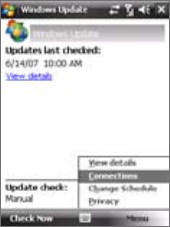
Managing Your PDA Phone 223
To change Windows Update options
1. Tap Start > Settings > Systems
tab > Windows Update.
2. Tap Menu and select the option
you want to change.
• Tap Connections to change
how the device connects to
the Internet when checking
for updates.
• Tap Change Schedule
to change how Windows
Update checks for patches
on the Microsoft Web site.
Tip You can check for updates whenever you want by tapping Check Now on
the Windows Update screen.
13.7 Battery Saving Tips
How long your battery power lasts depends on battery type and how you
use your device. Try the following to help preserve battery life:
• When the device is not in use, press POWER to switch o the display.
• Tap Start > Settings > System tab > Power to open the Power
settings screen. On the Advanced tab of the Power settings screen,
you can specify when your device automatically turns o the display
to conserve battery power. For optimum conservation, specify 3
minutes or less.
• Use the AC adapter to plug your device into external power whenever
possible, especially when using a storage card or when using a
modem or other peripherals.
• Adjust the backlight settings. For more information, see “To set the
backlight to dim after a time delay” in Chapter 4.
224 Managing Your PDA Phone
• When you know you are out of range of your Wi-Fi networks, turn
Wi-Fi o. Searching for networks consumes a lot of power. For more
information about Wi-Fi, see Chapter 10.
• Turn Bluetooth o when you are not using it. Make your device visible
to other devices only when you are trying to establish a Bluetooth
partnership. For more information about Bluetooth, see Chapter 10.
• Lower the volume.
• Close battery-intensive programs, such as the Camera, when you are
done using them. Make sure the programs are ended and are not
continuously running in the background.

Chapter 14
Using Other Applications
14.1 Voice Speed Dial
14.2 Java
14.3 Spb GPRS Monitor

226 Using Other Applications
14.1 Voice Speed Dial
You can record voice tags so that you can dial a phone number or launch
programs simply by speaking a word.
Create a voice tag for a phone number
1. Tap Start > Contacts to open the Contacts list.
2. Do one of the following:
• Tap and hold the desired contact, then tap Add Voice Tag.
• Select the desired contact, then tap Menu > Add Voice Tag.
• Tap the desired contact to open the contact’s detailed screen, then
tap Menu > Add Voice Tag.
3. Select the phone number that you want to create a voice tag, then
tap the Record button ( ).
4. When completed, a Voice Tag icon ( ) will be displayed on the
right of the item.
Select the desired
phone number.
Tap the Record button to
start recording.
5. When you create a voice tag for the item, you can do one of the
following:
• Tap the Record button ( ) to rebuild the voice tag.

Using Other Applications 227
• Tap the Play button ( ) to play the voice tag.
• Tap the Delete button ( ) to delete the voice tag.
Tip To ensure voice recognition accuracy, record your voice in a quiet place.
Create a voice tag for a program
1. Tap Start > Settings > Personal tab > Voice Speed Dial.
2. The Application tab displays a list of all installed programs on your
device. The procedure for creating a voice tag for a program is the
same as the procedure for creating a voice tag for a phone number.
3. After you have created a voice tag for a program, you can then launch
the program by saying the recorded voice tag after tapping Start >
Programs > Voice Speed Dial.
Make a call or launch programs using a voice tag
1. Tap Start > Programs > Voice Speed Dial.
2. After a “beep” sound, say the recorded voice tag that you have
assigned to the phone number you want to call or the program you
want to launch. The system will repeat the voice tag and then dial out
or launch the program automatically.
Note If the system cannot recognize your voice, try again. Speak more clearly and
reduce the surrounding noise or move to a more quiet place.
To view and test the voice tags you have created
1. Tap Start > Settings > Personal tab > Voice Speed Dial.
2. The Voice Tag tab displays a list that contains all the voice tags you
have created. Select an item in the list, and you can do one of the
following:
• Tap the Record button ( ) to rebuild the voice tag.
• Tap the Play button ( ) to play the voice tag.
• Tap the Delete button ( ) to delete the voice tag.
228 Using Other Applications
14.2 Java
MIDlets are Java applications such as games and tools that can run on
mobile devices, while a MIDlet suite is a collection of one or more MIDlets.
The Java program lets you download, install and manage MIDlets or MIDlet
suites on your device. Your device supports Java 2 Micro Edition, J2ME.
To open the Java program
Tap Start > Programs > Java.
Install and launch MIDlets/MIDlet suites
There are several ways to install a MIDlet/MIDlet suite.
To download and install via Internet Explorer Mobile
1. Tap Menu > Install > Browser to open Internet Explorer® Mobile.
2. Locate the MIDlet/MIDlet suite while connected to the Internet.
3. Select the MIDlet/MIDlet suite to download.
4. Information about the MIDlet/MIDlet suite is then displayed. Tap
Continue.
5. Confirm to start downloading.
6. Select <root> or a folder where to install the MIDlet suite to, then tap
OK.
To install from your device
You can copy MIDlets/MIDlet suites from the PC to your device using the
USB sync cable or Bluetooth connection. Copy them to the root folder or
any subfolder on your device.
1. Tap Menu > Install > Local Files. The program then searches for
MIDlets/MIDlet suites on your device and displays them in a list.
2. From the list, tap the MIDlet/MIDlet suite that you want to install.
3. Confirm to start the installation.
4. Select <root> or a folder where to install the MIDlet suite to, then tap
OK.
Using Other Applications 229
To run a MIDlet/MIDlet suite
Do one of the following:
• After installation of the MIDlet/MIDlet suite is complete, tap Yes.
• On the Java screen, open the folder that contains the MIDlet/MIDlet
suite. Select the MIDlet/MIDlet suite then tap Launch.
To uninstall MIDlets
Before you uninstall a MIDlet, make sure that it is not running.
1. Tap and hold the MIDlet, and tap Uninstall.
2. Tap OK to confirm.
Note To uninstall all MIDlets and folders from the current folder, tap Menu >
Uninstall All.
14.3 Spb GPRS Monitor
Using Spb GPRS Monitor, you can monitor how much data you have sent
and received on your device, and check the network usage costs by taking
into account your service plan details. You can also view connection cost
and traffic charts, generate reports of network connection usage, and
export reports to CSV files for use with Microsoft® Office Excel® and Access.
Install GPRS Monitor
The GPRS Monitor program is included on the Application Disc. To install
it onto your device, run the program’s installer on your PC. Follow the on-
screen instructions on your PC and your device to complete the installation.
The Today Plug-in
After you have installed GPRS Monitor on your device, you will find its
program icon in Start > Programs. In addition, GPRS Monitor is also added
to the Today screen as a plug-in which shows connection statistics, a
brightness panel, battery panel, and shortcut icons.
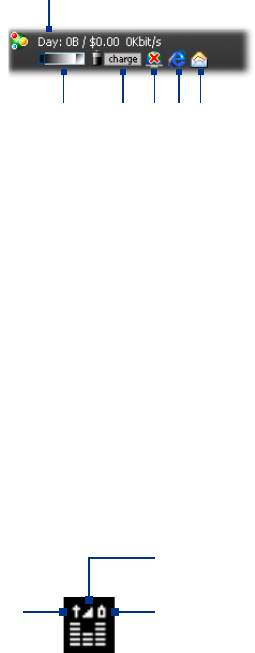
230 Using Other Applications
1
2 3 4 5 6
1Tap to open the GPRS Monitor screen where you can set up monitoring, view
cost and traffic charts, and generate reports..
2Tap inside the control bar to adjust the backlight level.
3This is the battery power monitor. Tap it to access the Power Settings screen.
4Tap to toggle between connecting or disconnecting your default data
connection.
5Tap to open Internet Explorer Mobile.
6Tap to open Messaging.
The GPRS Monitor icon and pop-up window
Another way of displaying status information visually is by enabling the
GPRS Monitor icon to be shown on the title bar. This icon shows the GPRS/
dial-up connection speed, data traffic, and battery status.
To show the GPRS Monitor icon on the title bar
1. Tap Start > Programs > Spb GPRS Monitor.
2. Tap Tools > Options > Icon tab.
3. Select the Show taskbar icon check box.
By default, the GPRS Monitor icon shows three bars that represent the
following status information:
Icon Bar 2: Traffic
(Full bar corresponds to
100%. Each bar is 20%.)
Icon Bar 3: Battery
(Each bar corresponds to
20% of the total charge.)
Icon Bar 1: Speed
(Full bar corresponds
to 19KB/sec.)
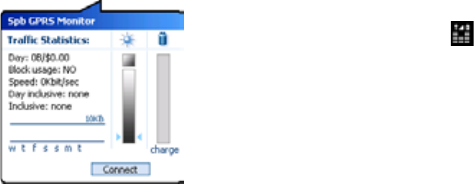
Using Other Applications 231
When you tap the GPRS Monitor icon
on the title bar, a pop-up window opens
and shows you detailed statistics about data
transfers, such as the data size just transferred
and its cost, the data amount left that you are
allowed to transfer, and more.
Set up monitoring and notification
To select the connection to be monitored
1. On the GPRS Monitor screen, tap Tools > Options > Connection tab.
2. Select the Enable connection monitoring check box.
3. In the Connection list, select the connection you want to monitor.
To enter your service plan details
Service plan details, or tariff, determine the price that you pay for your data
transfers. The tariff may either be flat rate or time-based, depending on
whether you’re using GPRS or a phone dial-up connection for data transfers.
Contact your service provider to find out about your tariff, and enter the
information in the Tariff tab or the Tariff Details tab on the Options screen.
Note The calculation of network usage costs is based on the information that you
entered, and is an estimate only. The actual amount billed by your service
provider may differ.
To set up traffic limit notifications
You can set up traffic limit notifications if you want to be notified when a
traffic limit is reached.
1. On the GPRS Monitor screen, tap Tools > Options.
2. Enable the notifications on the Day Warn and Month Warn tabs. You
can specify up to three daily and three monthly limits.
Once traffic reaches one of these limits, you will receive a notification.
232 Using Other Applications
View charts and reports
On the GPRS Monitor, you can view network connection cost charts and
traffic charts, as well as generate detailed reports of network connection
usage during a given period of time. These reports can be exported to CSV
files that you can open using Excel, Access, or other similar spreadsheet and
database software.
To view charts and generate reports
On the GPRS Monitor screen:
• Tap the Chart tab to view the network connection cost charts and
trac charts.
• Tap the Report tab to generate reports on network trac and tari.
For more information about using Spb GPRS Monitor, see Help on your
device.
Appendix
A.1 Regulatory Notices
A.2 Specifications
234 Appendix
A.1 Regulatory Notices
Regulatory Agency Identifications
For regulatory identification purposes, your product is assigned a model
number of SEDN100.
To ensure continued reliable and safe operation of your device, use only the
accessories listed below with your SEDN100.
The Battery Pack has been assigned a model number of TRIN160.
Note This product is intended for use with a certified Class 2 Limited Power Source,
rated 5 Volts DC, maximum 1 Amp power supply unit.
Federal Communications Commission Notice
This device complies with part 15 of the FCC Rules. Operation is subject
to the following two conditions: (1) This device may not cause harmful
interference, and (2) this device must accept any interference received,
including interference that may cause undesired operation.
This equipment has been tested and found to comply with the limits for a
Class B digital device, pursuant to Part 15 of the FCC Rules. These limits are
designed to provide reasonable protection against harmful interference in
a residential installation. This equipment generates, uses, and can radiate
radio frequency energy and, if not installed and used in accordance with
the instructions, may cause harmful interference to radio communications.
However, there is no guarantee that interference will not occur in a
particular installation. If this equipment does cause harm-ful interference to
radio or TV reception, which can be determined by turning the equipment
on and off, the user is encouraged to try to correct the interference by one
or more of the following measures:
• Reorient or relocate the receiving antenna.
• Increase the separation between the equipment and receiver.
• Connect the equipment into an outlet on a circuit different from that
to which the receiver is connected.
• Consult the dealer or an experienced radio or television technician for
help.
Appendix 235
Modifications
The FCC requires the user to be notified that any changes or modifications
made to the device that are not expressly approved by High Tech Computer
Corporation may void the user’s authority to operate the equipment.
Safety precautions for RF exposure
• Use only original manufacturer-approved accessories, or accessories
that do not contain any metal.
• Use of non-original manufacturer-approved accessories may violate
your local RF exposure guidelines and should be avoided.
Exposure to Radio Frequency (RF) Signals
Your device contains a radio transmitter and receiver. The radiated output
power is far below the international radio frequency exposure limits. These
limits are part of comprehensive guidelines and establish permitted levels
of RF energy for the general population. The guidelines are based on the
safety standards previously set by international standards bodies:
• American National Standards Institute (ANSI) IEEE. C95.1-1992
• National Council on Radiation Protection and Measurement (NCRP).
Report 86. 1986
• International Commission on Non-Ionizing Radiation Protection
(ICNIRP) 1996
• Ministry of Health (Canada), Safety Code 6. The standards include a
substantial safety margin designed to assure the safety of all persons,
regardless of age and health.
The exposure standard for wireless mobile phones employs a unit of
measurement known as the Specific Absorption Rate, or SAR. The standard
incorporates a substantial margin of safety to give additional protection for
the public and to account for any variations in usage.
As with other mobile radio transmitting equipment, users are advised that
for satisfactory operation of the equipment and for the safety of personnel,
it is recommended that no part of the human body be allowed to come too
close to the antenna during operation of the equipment.
Your device has an internal antenna. Use only the supplied integral antenna.
Use of unauthorized or modified antennas may impair call quality and
236 Appendix
damage the phone, causing loss of performance and SAR levels exceeding
the recommended limits as well as result in non-compliance with local
regulatory requirements in your country.
To assure optimal phone performance and ensure human exposure to RF
energy is within the guidelines set forth in the relevant standards; always
use your device only in its normal-use position. Do not touch or hold the
antenna area unnecessarily when placing or receiving a phone call. Contact
with the antenna area may impair call quality and cause your device to
operate at a higher power level than needed. Avoiding contact with the
antenna area when the phone is IN USE optimizes the antenna performance
and the battery life.
Tests for SAR are conducted using standard operating positions specified by
the FCC with the phone transmitting at its highest certified power level in
all tested frequency bands. Although the SAR is determined at the highest
certified power level, the actual SAR level of the phone while operation can
be well below the maximum value. This is because the phone is designed
to operate at multiple power levels so as to use only the power required to
reach the network. In general, the closer you are to a wireless base station
antenna, the lower the power output. Before a phone model is available
for sale to the public, it must be tested and certified to the FCC that it does
not exceed the limit established by the government-adopted requirement
for safe exposure. The tests are performed in positions and locations (for
example, at the ear and worn on the body) as required by the FCC for
each model. (Bodyworn measurements may differ among phone models,
depending upon available accessories and FCC requirements). For body
worn operation, to maintain compliance with FCC RF exposure guidelines,
use only original manufacturer approved accessories. When carrying
the phone while it is on, use the specific original manufacturer supplied
or approved carrying case, holster, or other body-worn accessory. SAR
compliance for body-worn operations is restricted to belt-clips, holsters, or
similar accessories that have no metallic component in the assembly and
which provide at least 1.5 cm separation between the device and the users
body.
Appendix 237
SAR Information
FCC: 1.47 w/kg @1g(Head)
1.30 w/kg @1g (Body)
Telecommunications & Internet Association (TIA) safety
information
Pacemakers
The Health Industry Manufacturers Association recommends that a
minimum separation of six inches be maintained between a handheld
wireless phone and a pacemaker to avoid potential interference with the
pacemaker. These recommendations are consistent with the independent
research by and recommendations of Wireless Technology Research.
Persons with pacemakers:
• Should ALWAYS keep the phone more than six inches from their
pacemaker when the phone is turned ON.
• Should not carry the phone in a breast pocket.
• Should use the ear opposite the pacemaker to minimize the potential
for interference. If you have any reason to suspect that interference is
taking place, turn the phone OFF immediately.
Hearing Aids
Some digital wireless phones may interfere with some hearing aids. In the
event of such interference, you may want to consult your service provider,
or call the customer service line to discuss alternatives.
Other Medical Devices
If you use any other personal medical device, consult the manufacturer
of your device to determine if they are adequately shielded from external
RF energy. Your physician may be able to assist you in obtaining this
information.
Turn the phone OFF in health care facilities when any regulations posted in
these areas instruct you to do so. Hospitals or health care facilities may be
using equipment that could be sensitive to external RF energy.

238 Appendix
WEEE Notice
The Directive on Waste Electrical and Electronic Equipment (WEEE), which
entered into force as European law on 13th February 2003, resulted in a
major change in the treatment of electrical equipment at end-of-life.
The purpose of this Directive is, as a first priority, the prevention of WEEE,
and in addition, to promote the reuse, recycling and other forms of recovery
of such wastes so as to reduce disposal.
The WEEE logo (shown at the left) on the product or on its box
indicates that this product must not be disposed of or dumped
with your other household waste. You are liable to dispose of all
your electronic or electrical waste equipment by relocating over
to the specified collection point for recycling of such hazardous
waste. Isolated collection and proper recovery of your electronic
and electrical waste equipment at the time of disposal will
allow us to help conserving natural resources. Moreover, proper
recycling of the electronic and electrical waste equipment will
ensure safety of human health and environment. For more
information about electronic and electrical waste equipment
disposal, recovery, and collection points, please contact your
local city center, household waste disposal service, shop from
where you purchased the equipment, or manufacturer of the
equipment.
RoHS Compliance
This product is in compliance with Directive 2002/95/EC of the European
Parliament and of the Council of 27 January 2003, on the restriction of the
use of certain hazardous substances in electrical and electronic equipment
(RoHS) and its amendments.
Body-worn Operation
This device was tested for typical body-worn operations. To comply with
RF exposure requirements, a minimum separation distance of 1.5 cm must
be maintained between the user’s body and the handset, including the
antenna. Third-party belt-clips, holsters, and similar accessories used by this
device should not contain any metallic components. Body-worn accessories
that do not meet these requirements may not comply with RF exposure
requirements and should be avoided.
Appendix 239
Use only the supplied or an approved antenna. Unauthorized antennas,
modifications, or attachments could impair call quality, damage the phone,
or result in violation of regulations. Do not use the phone with a damaged
antenna. If a damaged antenna comes into contact with the skin, a minor
burn may result. Please contact your local dealer for replacement antenna.

240 Appendix
A.2 Specifications
System Information
Processor Qualcomm® MSM 7200 400MHz
Memory - ROM : 256 MB
- NAND Flash : 1 GB
- RAM : 128 MB SD RAM
(Figures are the total ROM and RAM memory available for use and
storage. Since the memory is shared by the Operating System,
applications, and data, the actual available memory is less than
what is written).
Operating System Windows Mobile® 6 Professional
Power
Battery Rechargeable Lithium-ion Polymer battery, 1500 mAh
Charging Time 3 hours
Battery Life
(estimates)
Standby time: Up to 460 hours for WCDMA
Up to 407 hours for GSM
Talk time: Up to 284 minutes for WCDMA
Up to 464 minutes for GSM
AC Adapter Voltage range/frequency: 100 ~ 240V AC, 50/60 Hz
DC output: 5V and 1A
Display
LCD Type 3.5-inch QVGA touch screen
Resolution 240 x 320 with 65,536 colors
Alignment Portrait and Landscape
HSDPA / WCDMA / GSM / GPRS / EDGE Module
Functionality HSDPA/WCDMA: Tri-band (850, 1900, and 2100 Mhz).
HSDPA: Up to 384kbps for upload and 3.6Mbps for
download;
WCDMA: Up to 384kbps for upload and download
GSM/GPRS/EDGE: Quad-band (850, 900, 1800, and
1900 Mhz)
Internal Antenna Yes

Appendix 241
Physical
Dimensions 137.4 mm (L) x 72.9 mm (W) x 20.5 mm (T)
Weight 220 g (with battery)
Camera Module
Type 3 Megapixel CMOS color camera with auto focus
Resolution Photo: 2048x1536, 1600x1200 (UXGA), 1280x960 (SXGA),
640x480 (VGA), 320x240 (QVGA), 160x120 (QQVGA)
Video: CIF (352x288), QVGA (320x240, depends on
recording formats), QCIF (176x144) and Sub-QCIF (128x96)
Digital Zoom Up to 8X
Connections
I/O Port HTC ExtUSB™ (11-pin mini-USB and audio jack in one;
USB 2.0 Full-Speed), SDIO, fingerprint sensor.
GPS Antenna
Connector
Yes. Use only the external GPS antenna with model
number GA S120.
Wireless
Connections
Wi-Fi (IEEE 802.11 b/g), Bluetooth 2.0 with EDR
Audio
Microphone and
Speaker
Built-in
Ring tone • MP3, AAC, AAC+, WMA, WAV, and AMR-NB
• 40 polyphonic and standard MIDI format 0 and 1
(SMF)/SP MIDI
Controls and Lights
Device Control • 5-way NAVIGATION Control / ENTER button
• Jog Wheel
• Two phone functions : TALK and END
• Four program buttons : MESSAGING, INTERNET
EXPLORER, COMM MANAGER, and CAMERA
• START button
• Two OK buttons
• Two SOFT KEYs
• POWER button
• RESET button

242 Appendix
LEDs The left (bi-color) LED shows Green and Amber lights
for WCDMA/GSM standby, message, network status,
notification, and battery charging status. Shows a
flashing red light when the battery level reaches 5% or
lower.
The right LED shows a blinking Blue light for Bluetooth
system notification of powered-up and ready to transmit
Bluetooth signal, or a blinking Green light for Wi-Fi status
(when both Bluetooth and Wi-Fi are enabled, the Blue
and Green lights blink alternately). The Amber light
indicates GPS notification.
Expansion Slots
Card Slot Two SD™ (SD 2.0 compatible) card slots
Index
244 Index
A
A2DP 174
About licenses and protected media
203
ActiveSync 88
- Comm Manager 156
- overview 84
- setting up 88
- synchronize 89, 131
Add and remove programs 216
Add attachment to message 122
Adobe Reader LE 40, 147
- exit 147
- navigate through document 147
- search for text in the document
147
Alarm 82
Answer/end a call 61
Appointment search 53
Assign programs or shortcuts to
hardware buttons 81
Attachments 124
Audio Manager 41, 207
B
Backlight 80
Back up data 151
Basic settings 68
Battery
- battery information 24
- charge battery 28
- save battery power 161, 223
Beam via Bluetooth 175
Block Recognizer 50
Bluetooth
- beam information 175
- Bluetooth Explorer 41, 176
- Bluetooth file sharing 176
- Bluetooth shared folder 176
- hands-free headset 174
- modes 172
- overview 172
- partnership (pairing) 172
- stereo headset 174
- synchronize 91
- turn on and o 156
- visible 172
Bluetooth Explorer 41
Burst capture mode 189
C
Calculator 41
Calendar 40, 101
Calendar search 53
Calibration 29
Camera
- capture modes 188, 189
- controls 190
- file formats 189
- icons 190
- overview 41
- Quick Settings Panel 192
- settings 192
- specifications 241
Change screen text size 80
Clear Storage 221
Clock & Alarms 44, 68
Comm Manager 41, 45, 156
Compose messages 122
Conference call 62
Configure data connection settings 28
Index 245
Connection Setup 28, 38, 157
Connect device to Internet
- set up dial-up connection to ISP
163
- set up GPRS connection 162
- start a connection 164
Connect to Internet 158
Contacts 40, 94
Contacts Picture capture mode 189
Contacts search 53
Copy
- contacts to SIM card 99
- media files from PC to device 204
- SIM contacts to device 99
Copy and manage files 148
Customize
- Start menu 71
- Today screen 69
D
Device ID 80
Device name 80
Dial-up 163
Dial-up to ISP 163
Digitally sign messages 140, 142
Digital Rights Management (DRM) 203
Digital signature
- sign 140
- verify 141
Dimensions and weight 241
Direct Push 132, 156
Disconnect data services 156
Download messages 125
Draw 107
E
E-mail 118, 119
- IMAP4 119
- POP3 119
- search 53
- security 140
- settings (POP3/IMAP4) 121
- setup wizard 119
Emergency call 65
Emoticon 116
Encrypt messages 140, 142
Excel Mobile 40
Exchange Server
- automatic synchronization 132
- schedule synchronization 132
Exclude e-mail address when replying
to all 127
F
Favorite People 34
File Explorer 41
Find
- device information 222
- operating system version number
222
Find contact
- online 138
- on device 97
Forward message 124
G
Games 41
GPRS 162
GPRS Monitor 42, 229
246 Index
GPS 42, 182, 184
GPS Photo capture mode 189
H
Hard reset 220
Help 40
Help search 53
Home 33
HSDPA 46
HTC Home 32
I
IMAP4 119
Input methods
- Block Recognizer 50
- Keyboard 49
- Letter Recognizer 49
- Symbol Pad 52
- Transcriber 50
Input Panel 48
International call 65
Internet 158
Internet Explorer Mobile 40, 165
Internet Sharing 41, 171
J
Java
- install MIDlets/MIDlet suites from
device 228
- install MIDlets/MIDlet suites from
Internet 228
- overview 41
- uninstall MIDlets 229
K
Keypad tone 72
L
Landscape 29
Launcher 37
Letter Recognizer 49
Library screen (Windows Media Player
Mobile) 202
Live Messenger 169
M
Mail search 53
Make call
- from Call History 60
- from Contacts 59
- from Phone program 58
- from SIM Manager 61
- from Speed Dial 60
Memory 217, 240
Messaging 110
- overview 40
- POP3 119
Messenger 41
MIDlet/MIDlet suite 228
MMS 112
- add audio clip 117
- add photo/video 114
- add text 116
- blacklist 118
- create and send 114
- MMS settings 112
- reply message 117
- view message 117
Index 247
MMS Video capture mode 189
MP3 Trimmer 212
Music Player 209
Mute 62
N
NAND Flash
- format 221
- recover 221
Notes 41, 53, 106
Notes search 53
Now Playing screen (Windows Media
Player Mobile) 202
O
Office Mobile 40
On-screen keyboard 49
Open PDF file 147
Opera Browser 41
P
Panorama capture mode 189
Password 73
Phone 40, 56, 58
Phonebook 94
Phone services 72
Phone settings 71
Photo capture mode 189
Pictures & Videos
- file formats 200
- overview 42
Picture Theme capture mode 189
PIN 56, 73
Playback screen (Windows Media
Player Mobile) 202
Playlists
- Audio Manager 210
- Windows Media 206
Play media 206
Plug-in
- GPRS Monitor 229
- HTC Home 32
POP3 119
Portrait 29
PowerPoint Mobile 40
Programs
- Format NAND Flash 41
- HTC Fingerprint Manager 41
- QuickGPS 42
Put call on hold 62
Q
QuickGPS 42, 184
Quick menu 32
R
Receive call 61
Record voice note 108
Regional settings 69
Regulatory notices 234
Reply message 124, 127
Reply MMS 117
Reset
- clear storage 221
- format NAND ash 221
- hard reset 219
- soft reset 219
Review screen (Camera) 195
Ringer 156
Ring tone 71, 211
Ring type 71
248 Index
S
Search 42, 53
Secure/Multipurpose Internet Mail
Extension (S/MIME) 140
Send messages 122
Settings
- basic settings 68
- capture and advanced settings for
camera 196
- device settings 43
- other settings 80
- quick settings for camera 192
Settings (Connections tab)
- Beam 45
- Bluetooth 45
- Connections 45
- CSD Line Type 45
- GPRS Setting 45
- HSDPA 46
- Network Wizard 45, 157
- SMS Service 46
- USB to PC 46
- Wi-Fi 46
- Wireless LAN 46
Settings (Personal tab)
- Buttons 43
- HTC Fingerprint Options 43
- Input 43
- Menus 43
- Owner Information 43
- Phone 43
- Sounds & Notifications 43
- Today 43
- Voice Speed Dial 43
Settings (System tab)
- About 43
- Backlight 43
- Certificates 44
- Clear Storage 44, 221
- Clock & Alarms 44
- Customer Feedback 44
- Device Information 44
- Encryption 44
- Error Reporting 44
- GPS 44
- Key Lock 44
- Lock 44
- Memory 44
- Microphone AGC 44
- Power 44, 223
- Regional Settings 45
- Remove Programs 45
- Screen 29, 45
- Task Manager 45
Set music as ring tone 211
Shortcuts 37
SIM card 24
SIM Manager 99
- copy contacts to SIM card 99
- copy SIM contacts to device 99
- create SIM contact 99
- make call 61
- overview 42
Smart Dialing 63
SMS 111, 122
Soft reset 219
Sounds & Notifications 82
Spb GPRS Monitor 42
Speakerphone 62
Specifications 240
Speed Dial 60
Index 249
Sports capture mode 189
Sprite Backup 42, 151
Start menu 31, 71
STK (SIM Tool Kit) Service 42
Storage card
- check available space 217
- copy files 149
Swap/switch calls 62
Synchronize
- ActiveSync 89
- change information types 90
- Outlook information with computer
89
- schedule synchronization with
Exchange Server 132
- via Bluetooth 91
- Windows Media Player 92
- Windows Media Player Mobile 204
Sync connection problem 90
System information 240
T
Tasks 42, 104
Tasks search 53
Text messages 111
Text size on screen 80
Today screen 30, 69
Transcriber 50
Troubleshoot Windows Media Player
Mobile 207
Turn device on and off 27
Turn phone function on and off 57,
156
U
USB modem 171
USB to PC 90
Using Task Manager 218
V
Verify digital signature 141
Vibrate 58, 156
Vibration 71
Video capture mode 189
Voicemail 60
Voice call 58
Voice Speed Dial
- create voice tag for phone numbers
226
- create voice tag for programs 227
- make call or launch program 227
- overview 42, 226
Voice tag
- create entries for phone numbers
226
- create entries for programs 227
- make calls or launch programs 227
Volume 58
W
Weather 34
Wi-Fi 46, 156, 158
Windows Live 42
Windows Live Messenger 41
Windows Live Mobile 166
Windows Media Player Mobile
- file formats 202
- menus 202
- overview 42
- playlists 206
- troubleshoot 207
Windows Mobile Device Center 85
Windows Update 45
Word Mobile 40
Z
ZIP
- create archive 151
- open zip file and extract files 150
- overview 42, 150
Zoom (Camera) 194